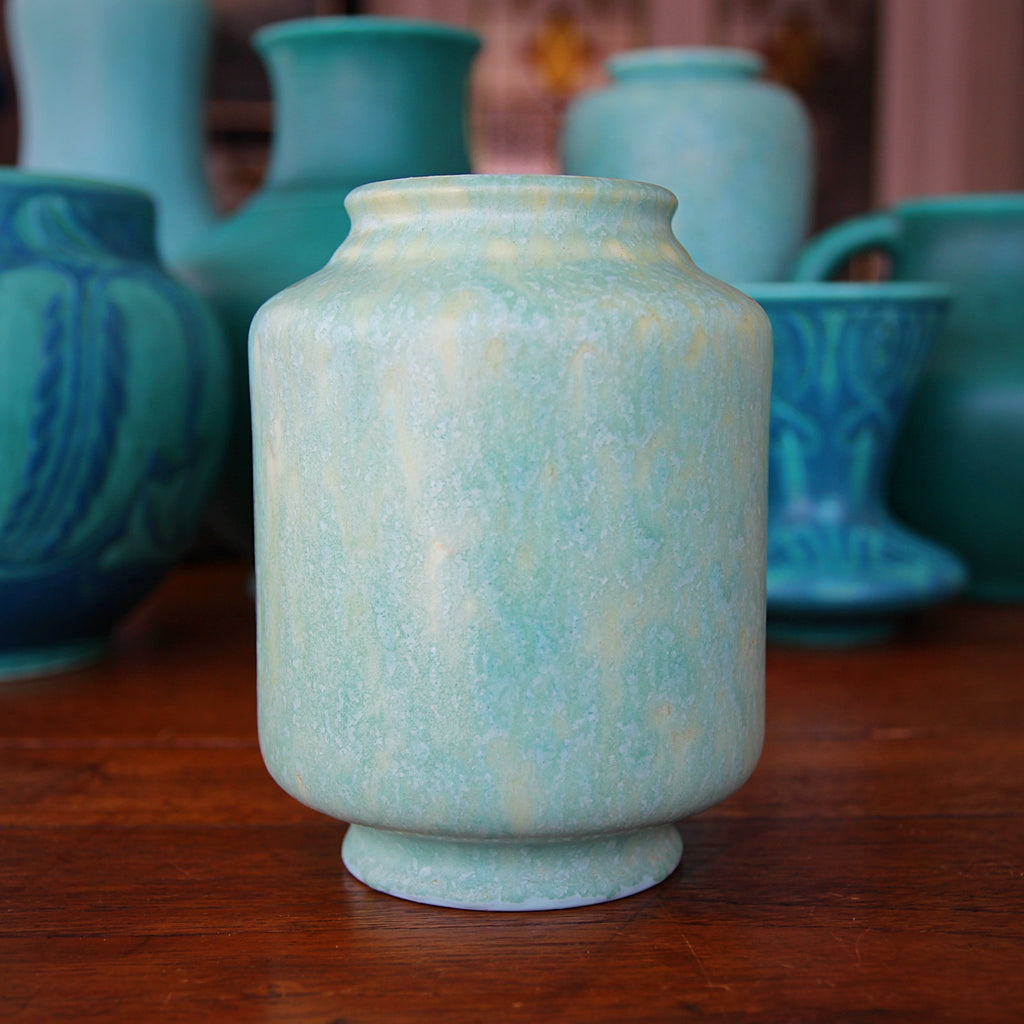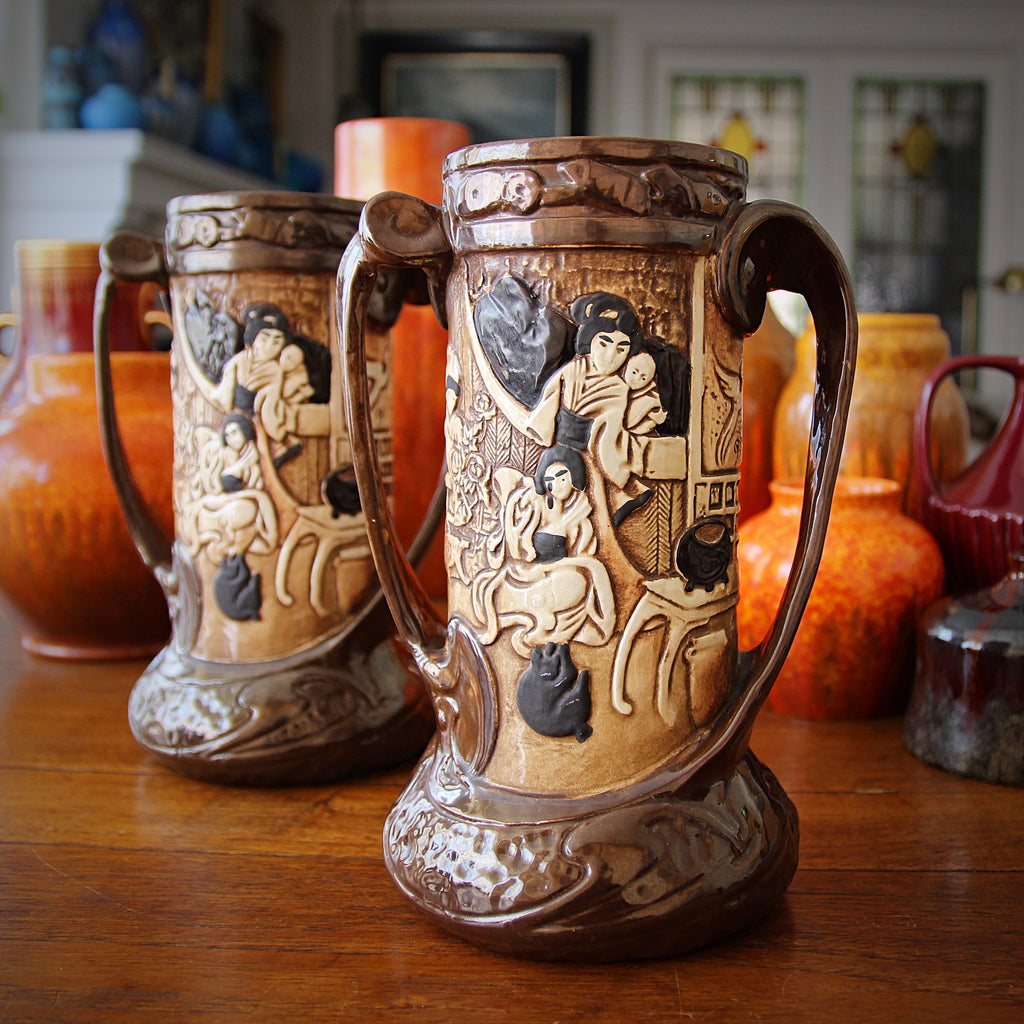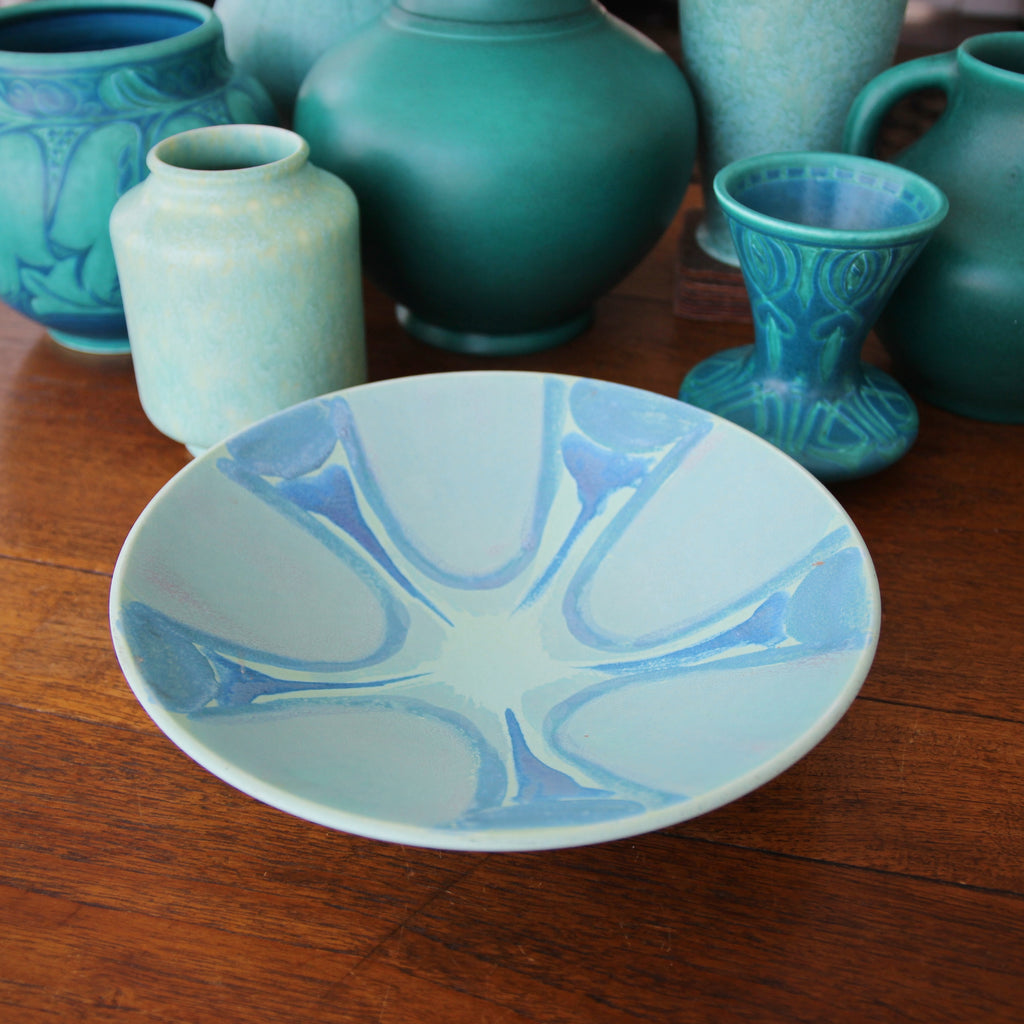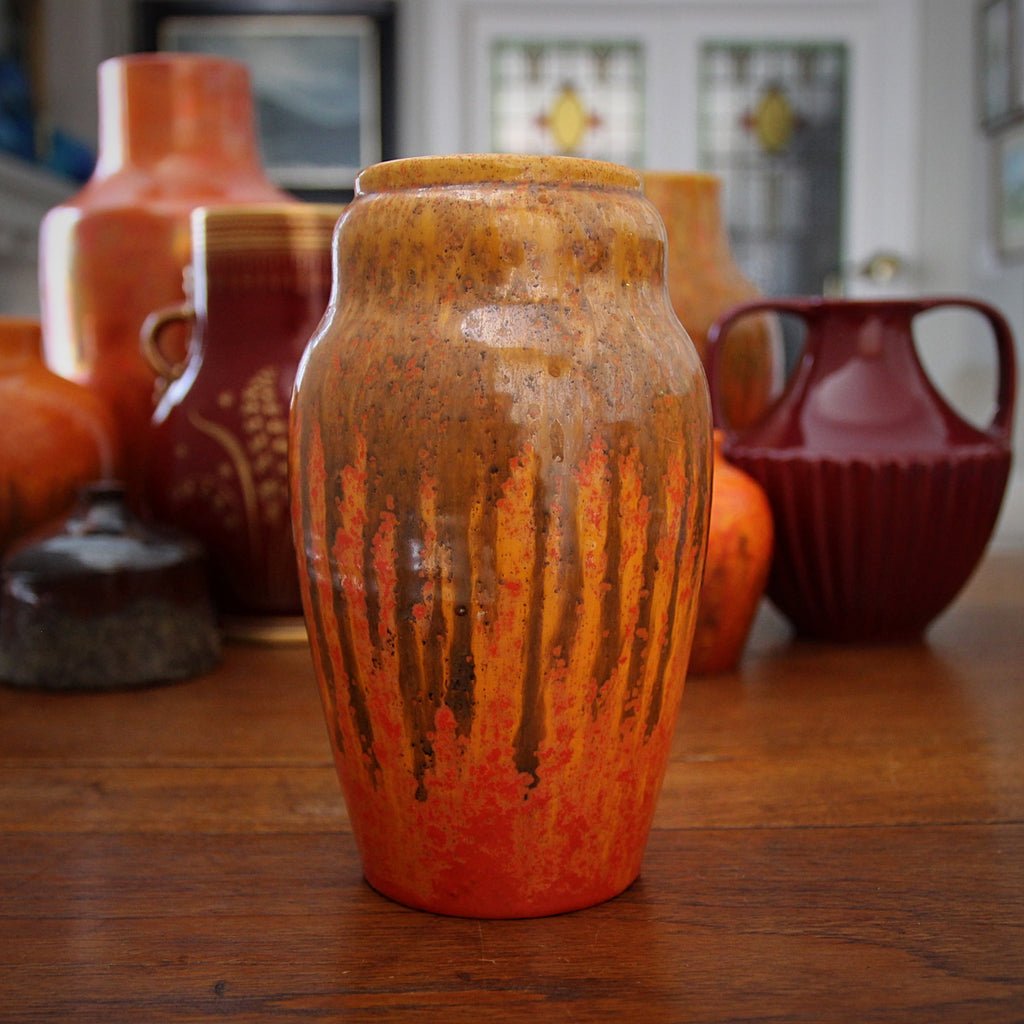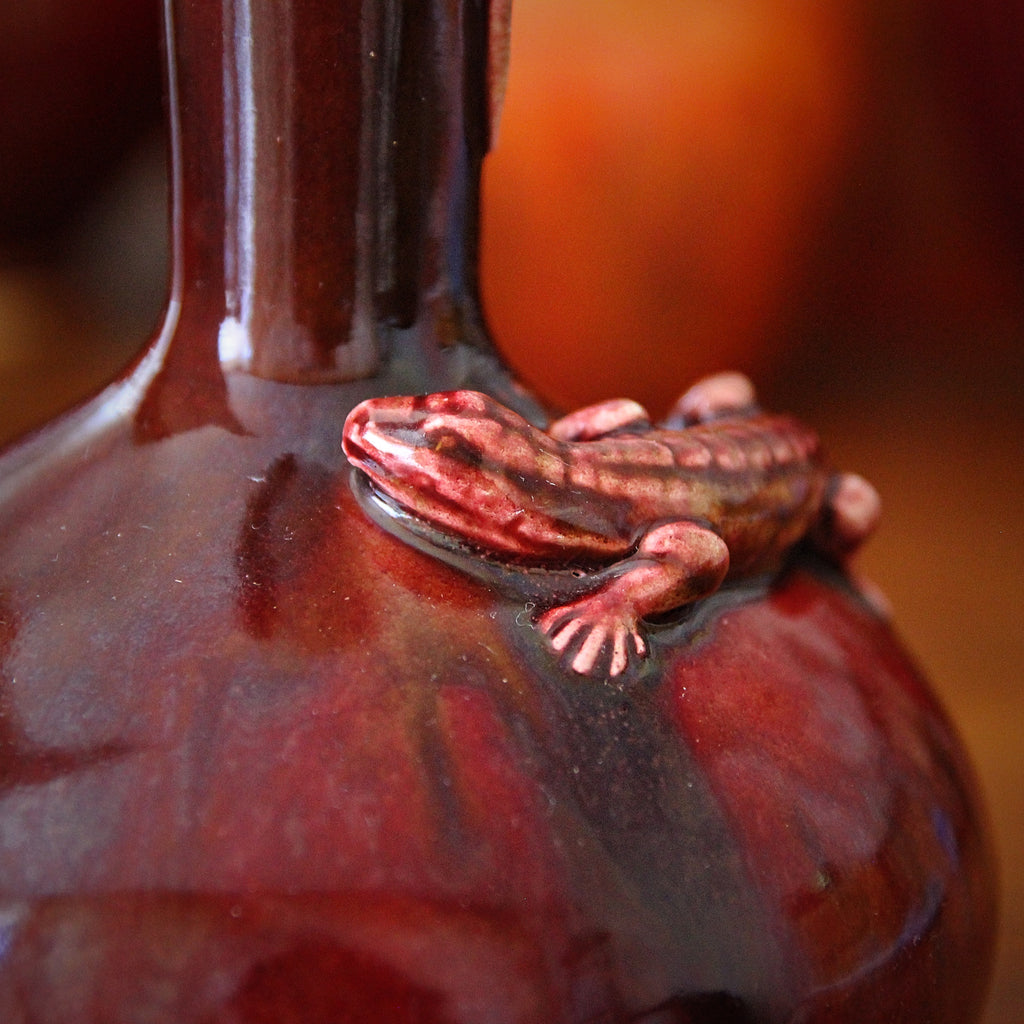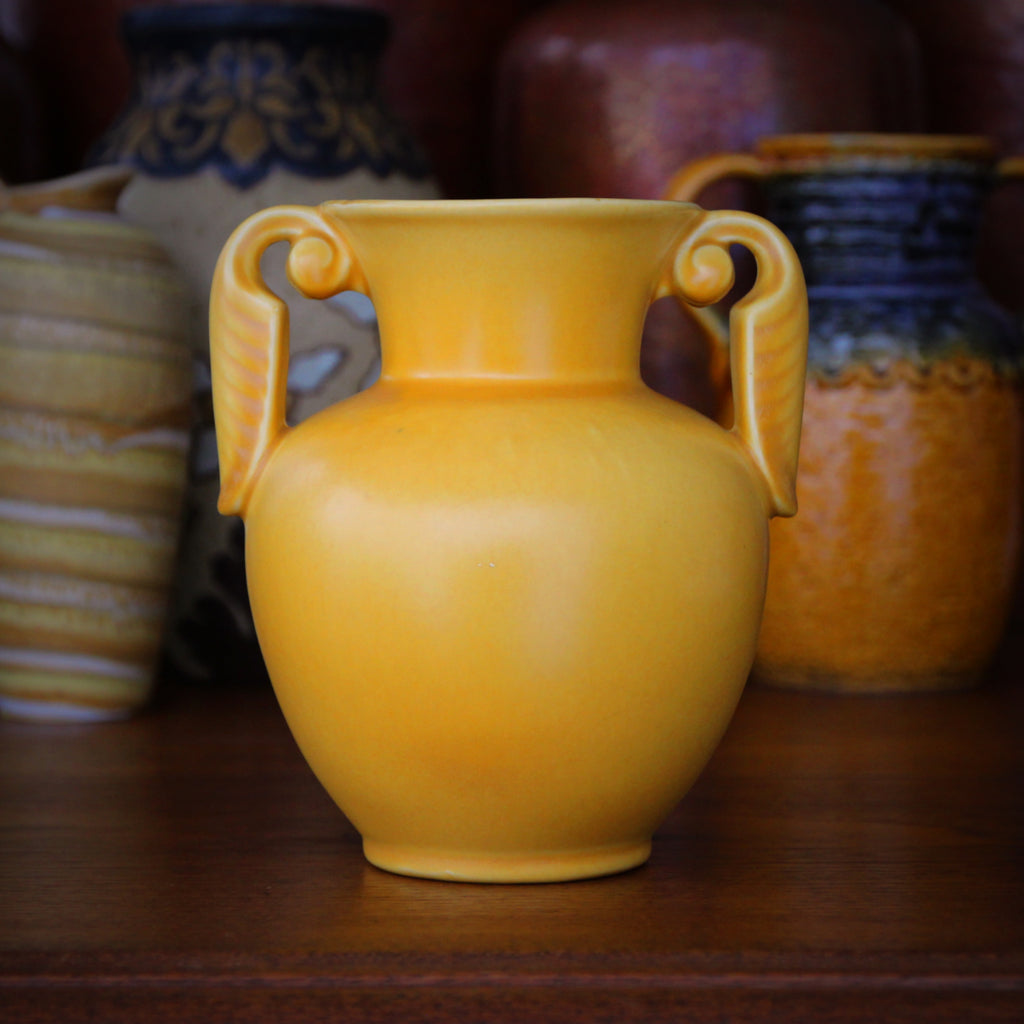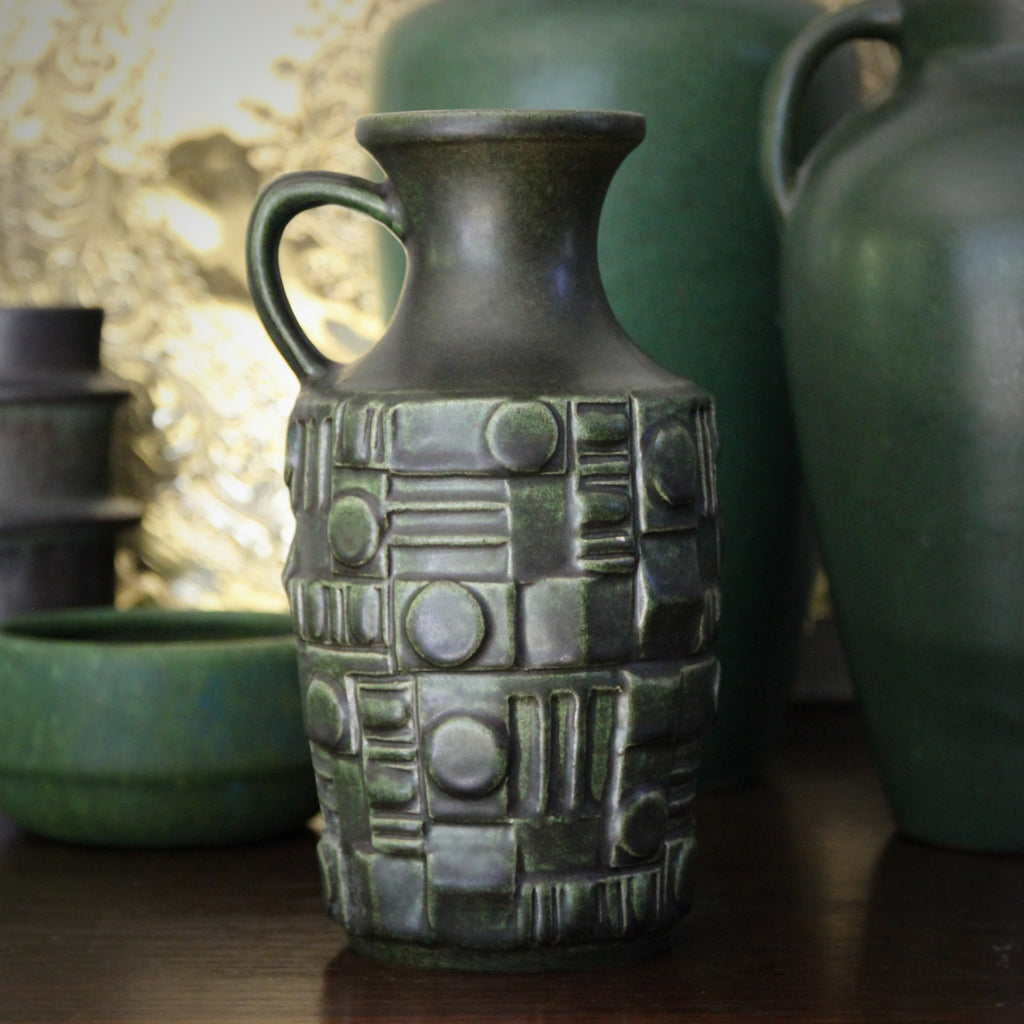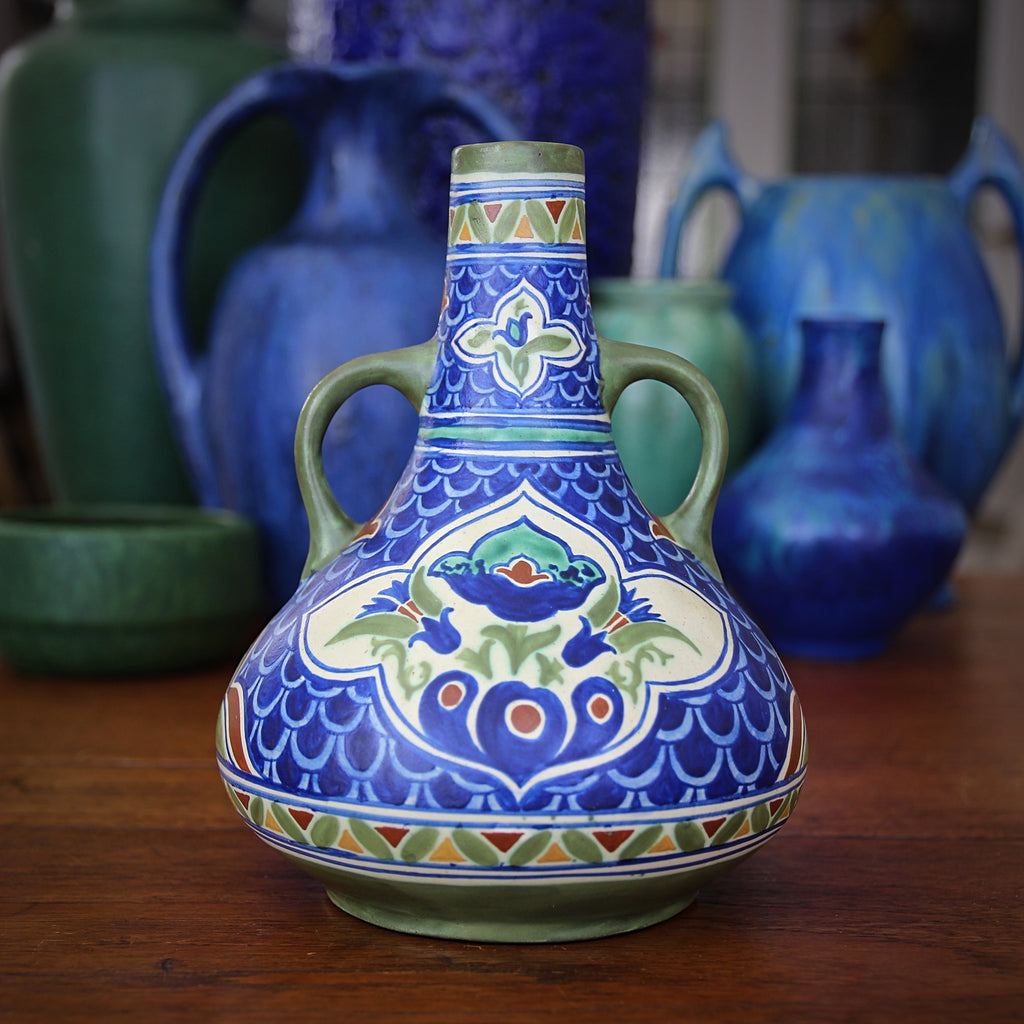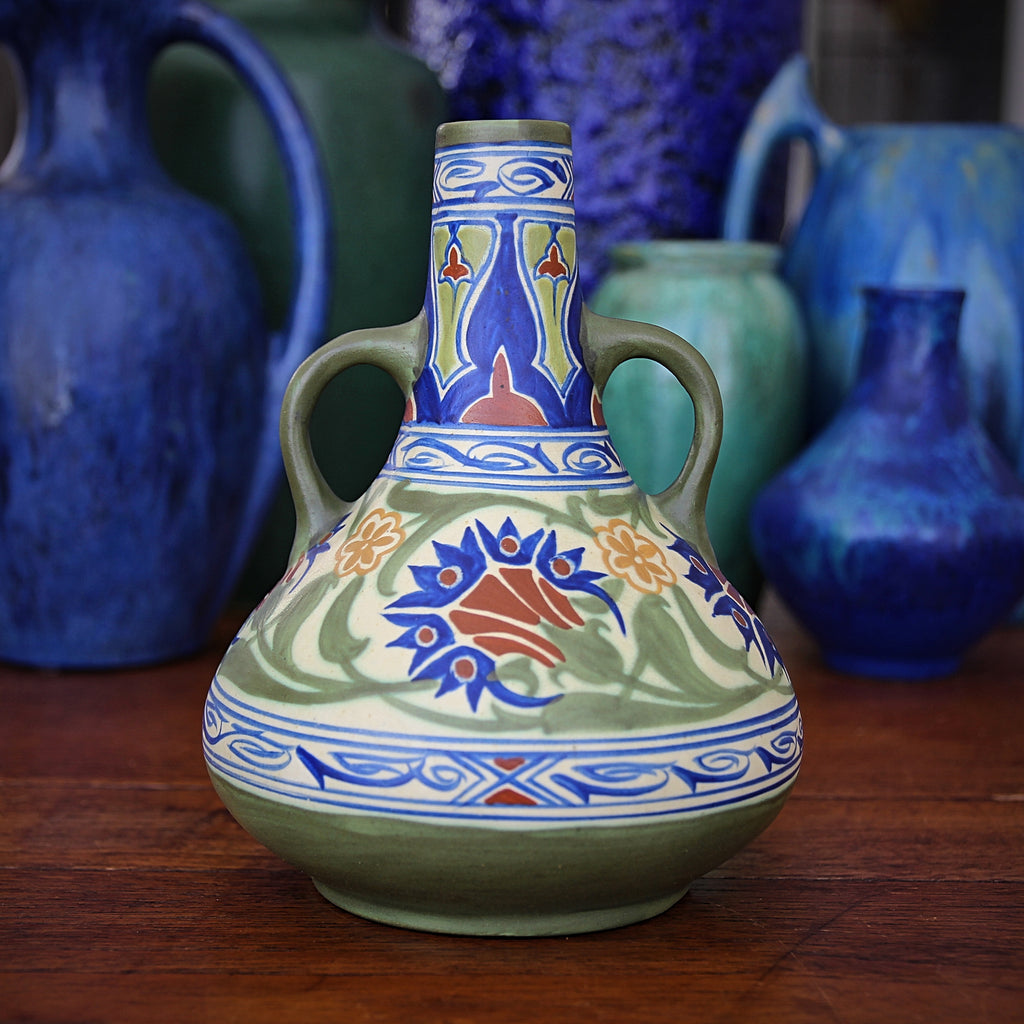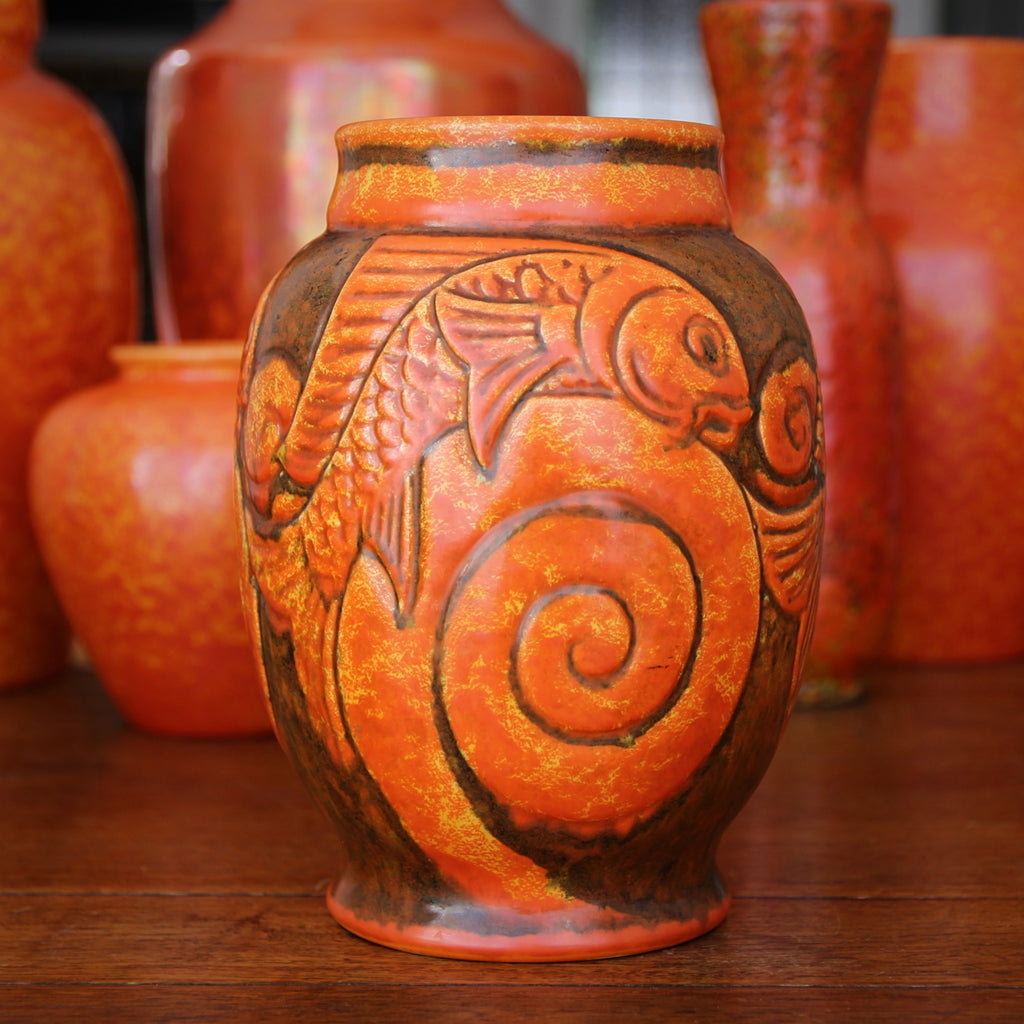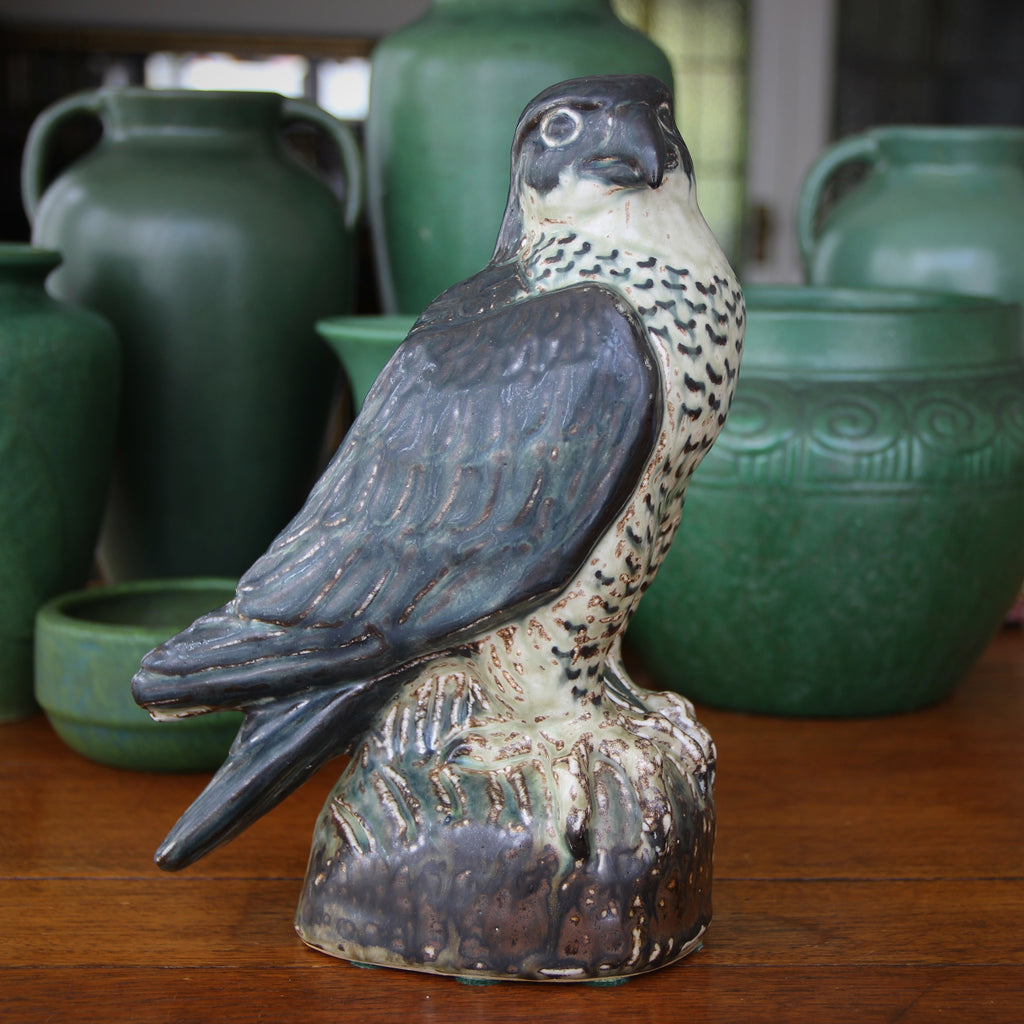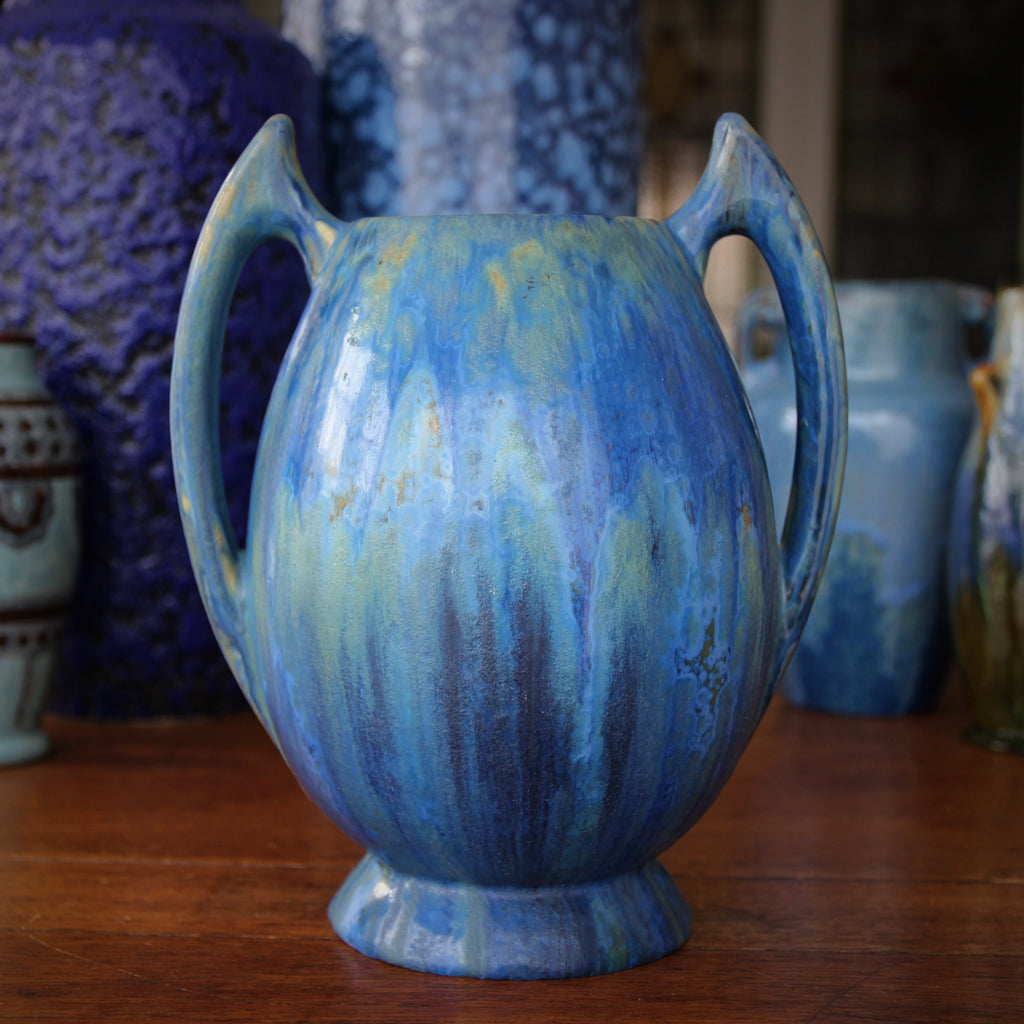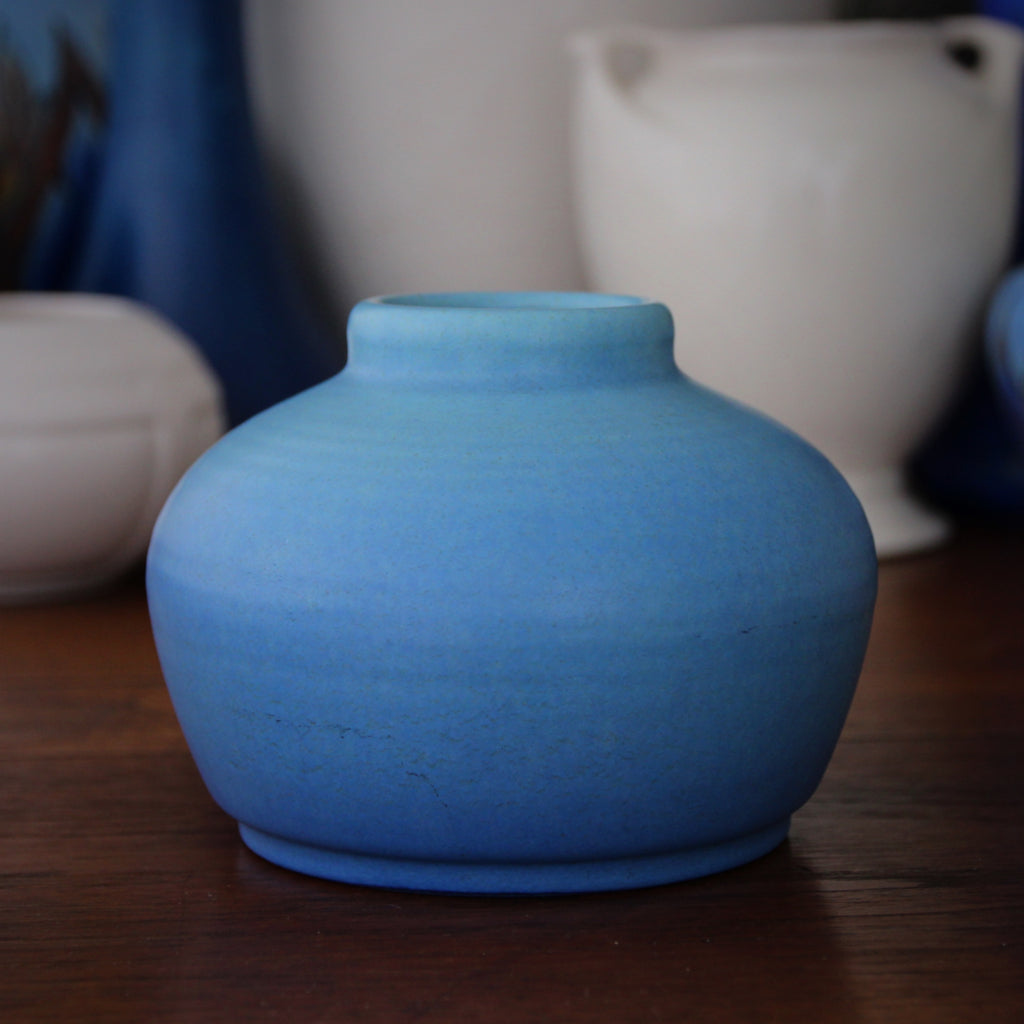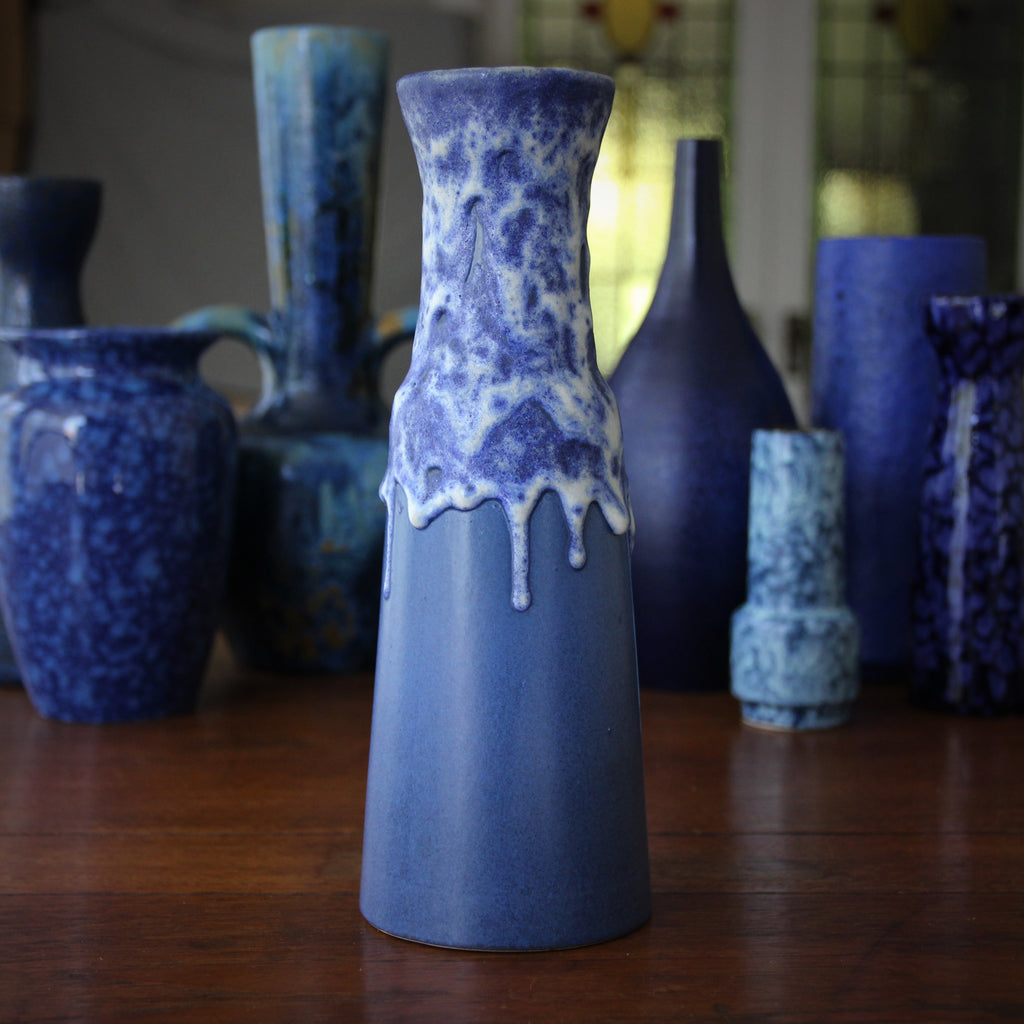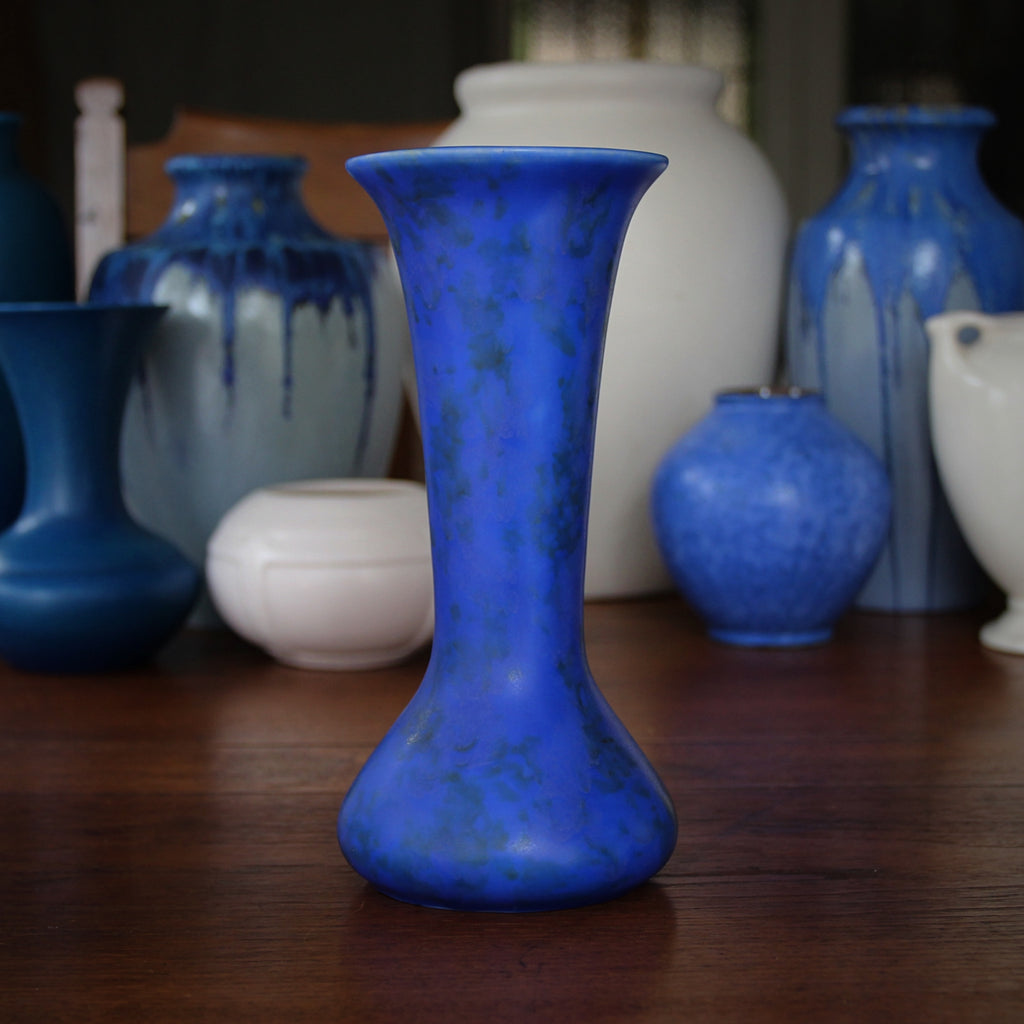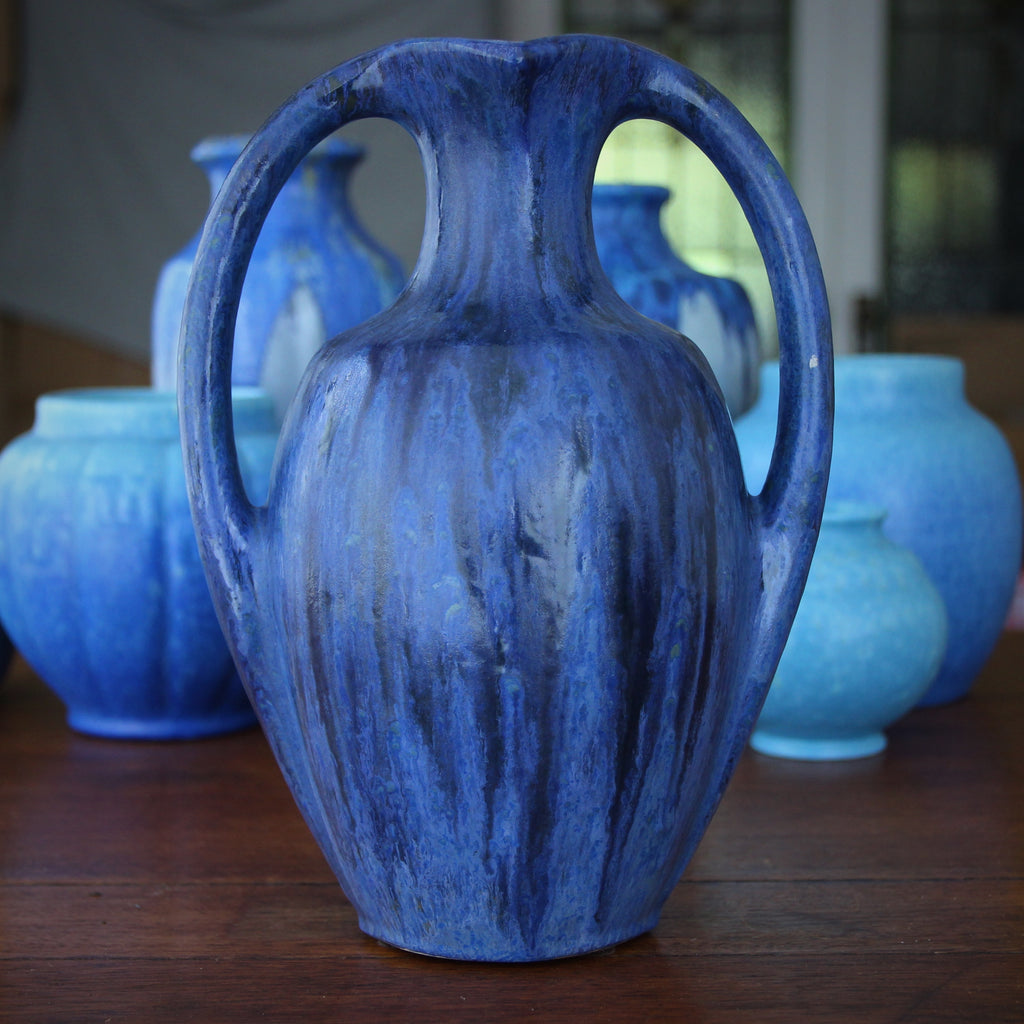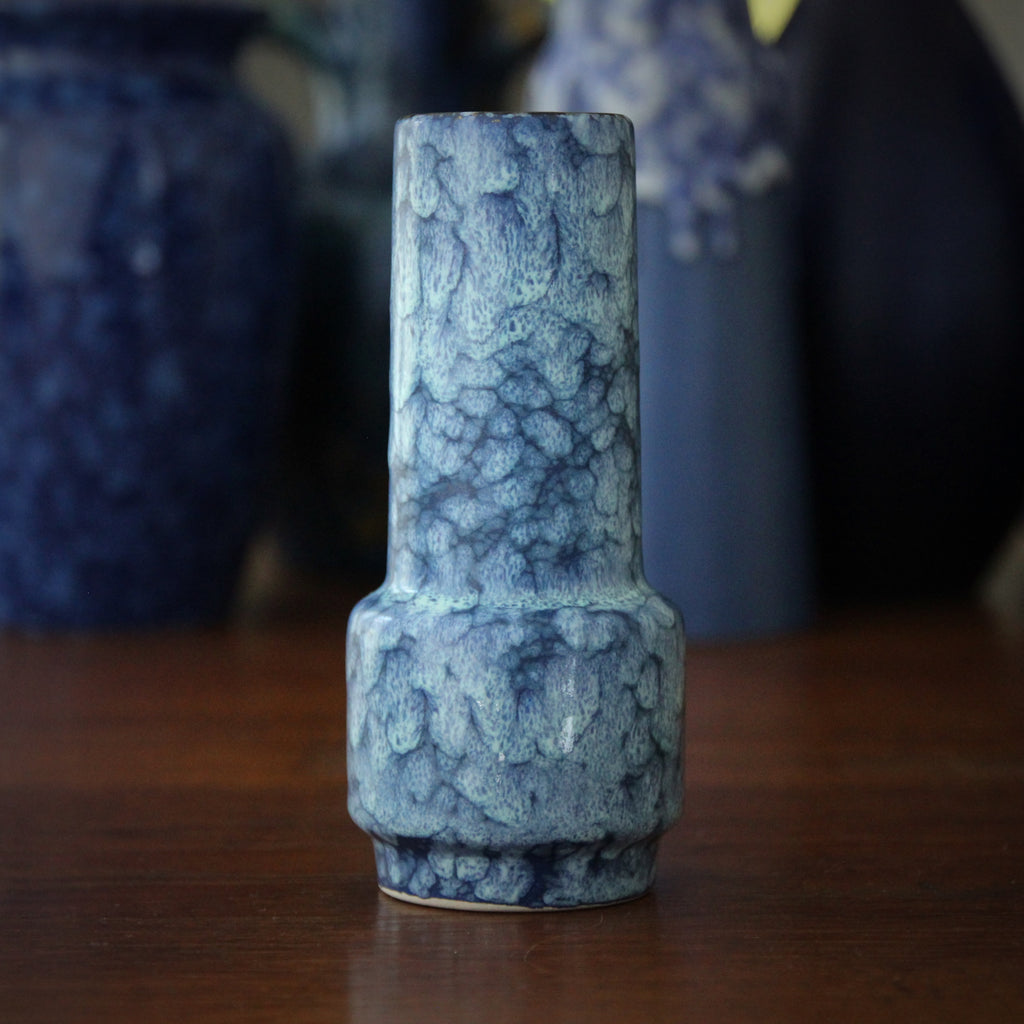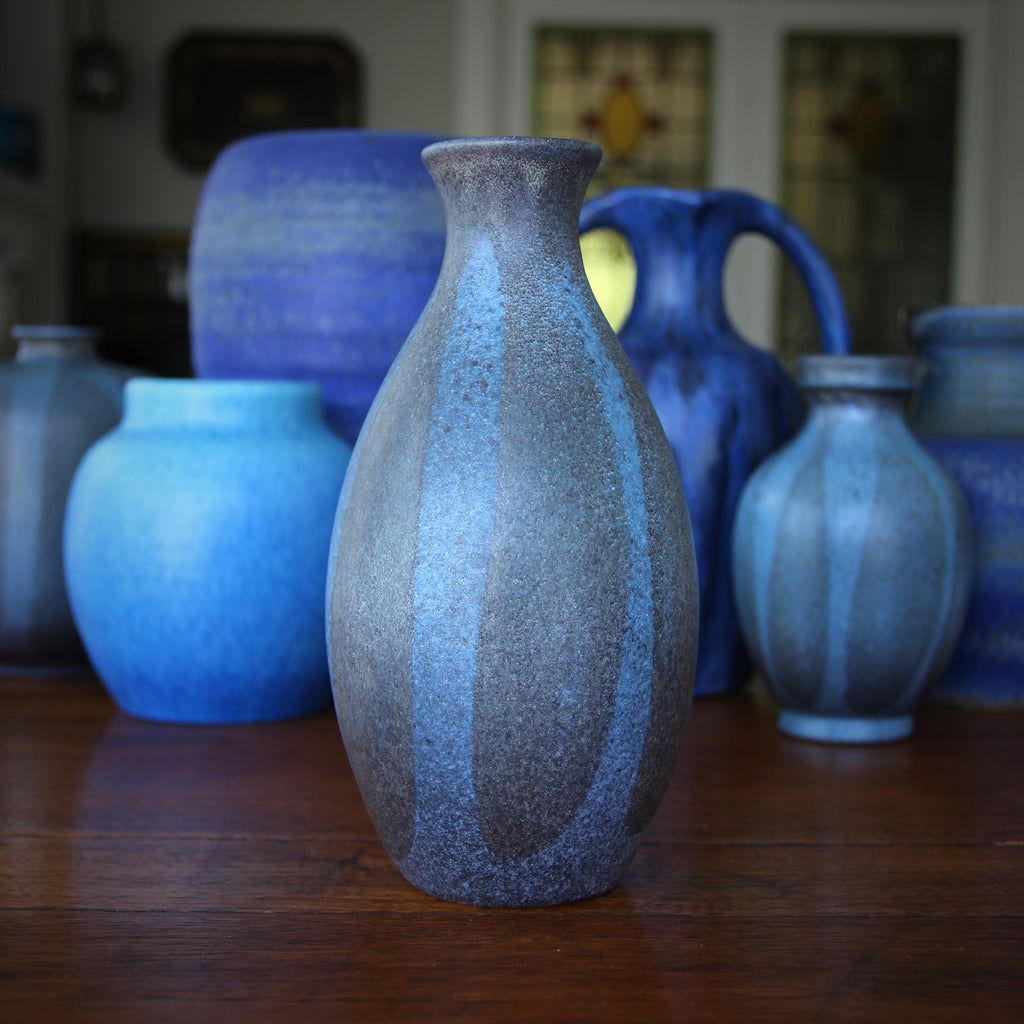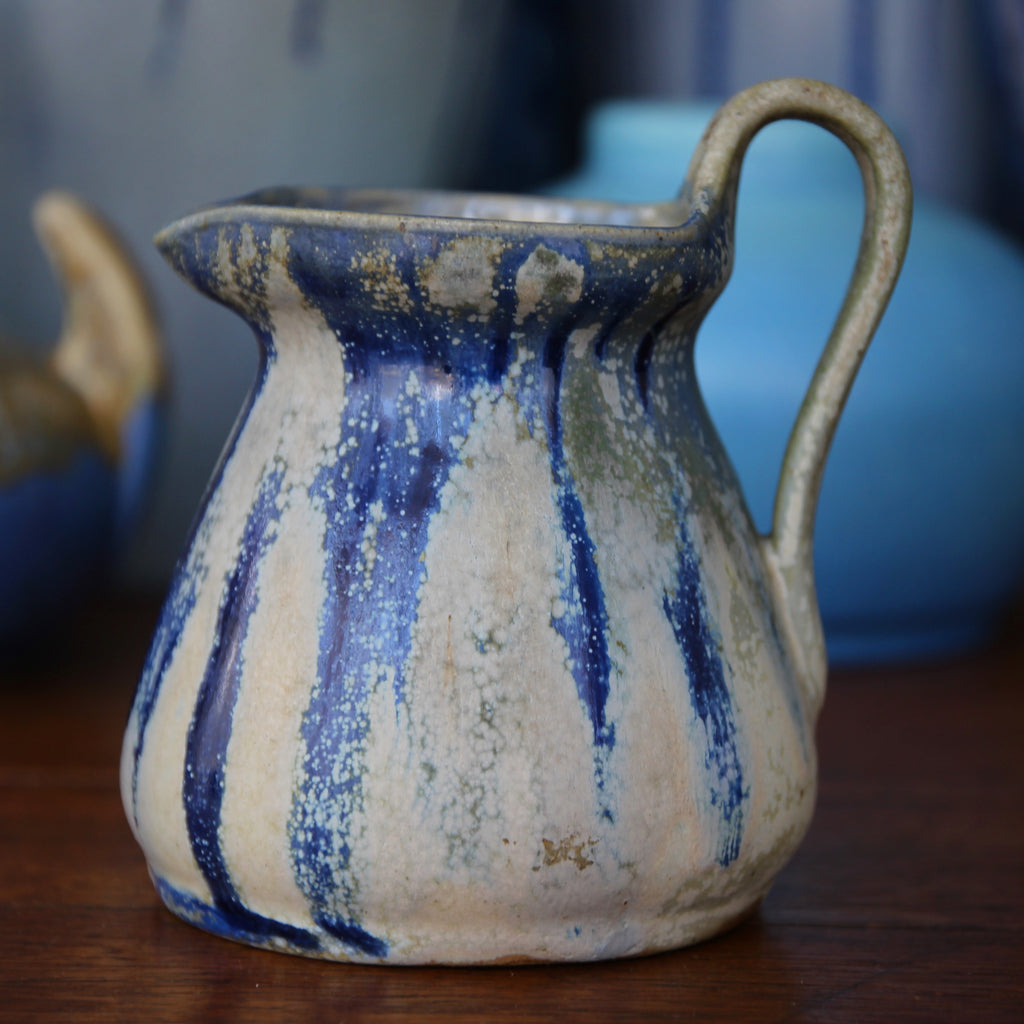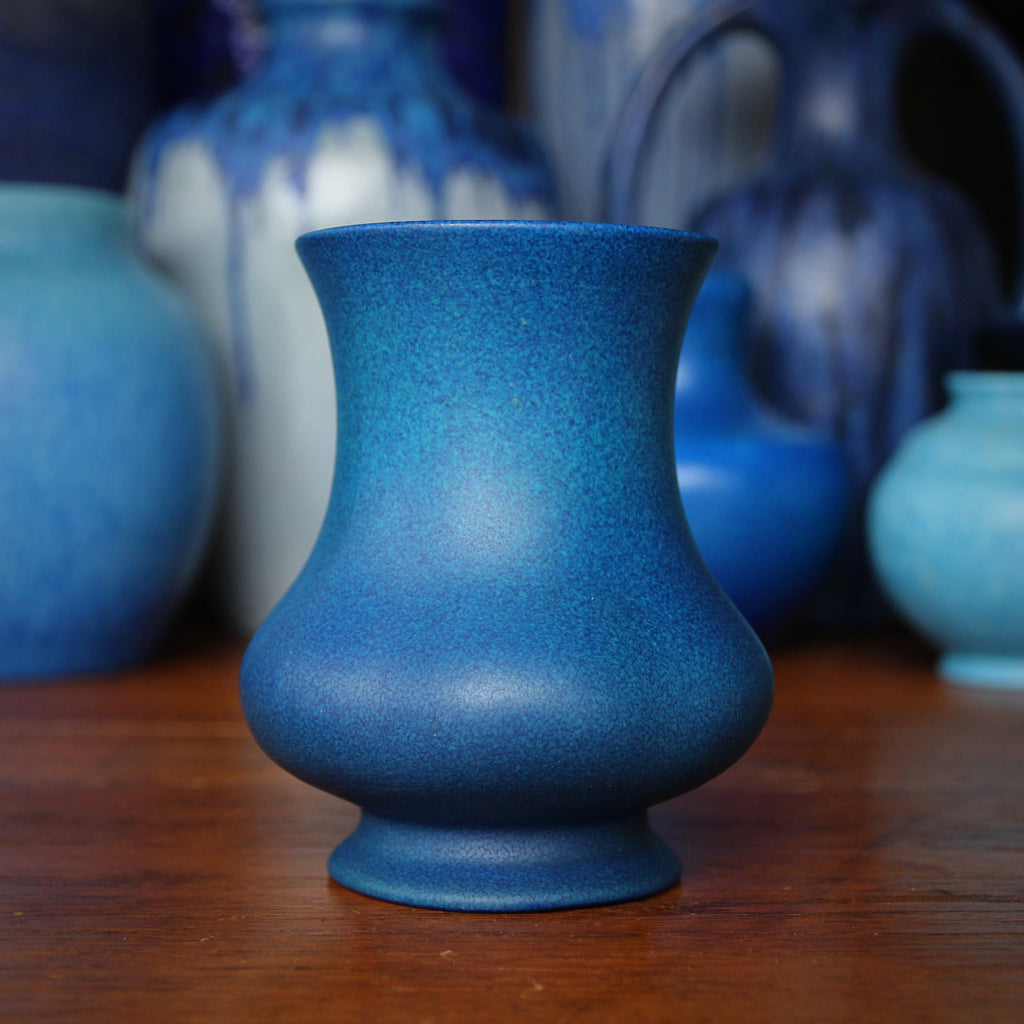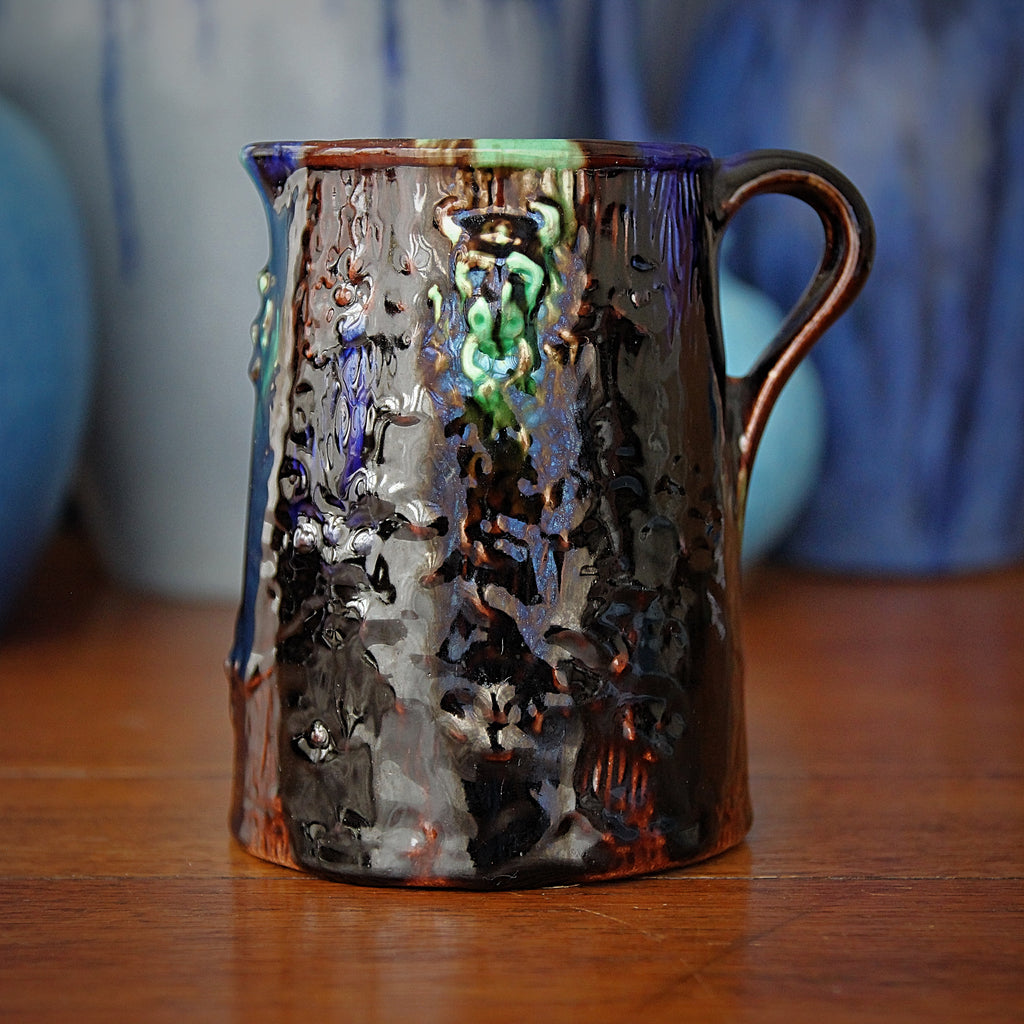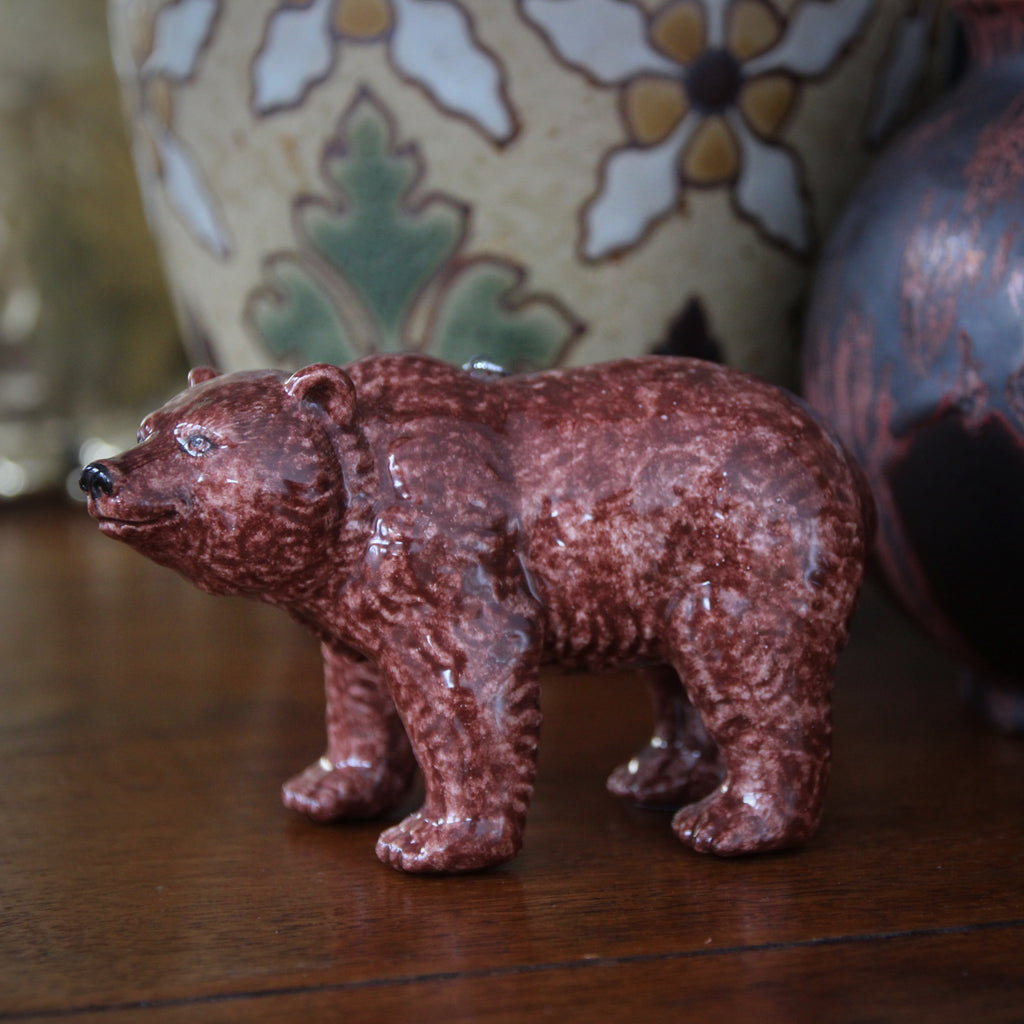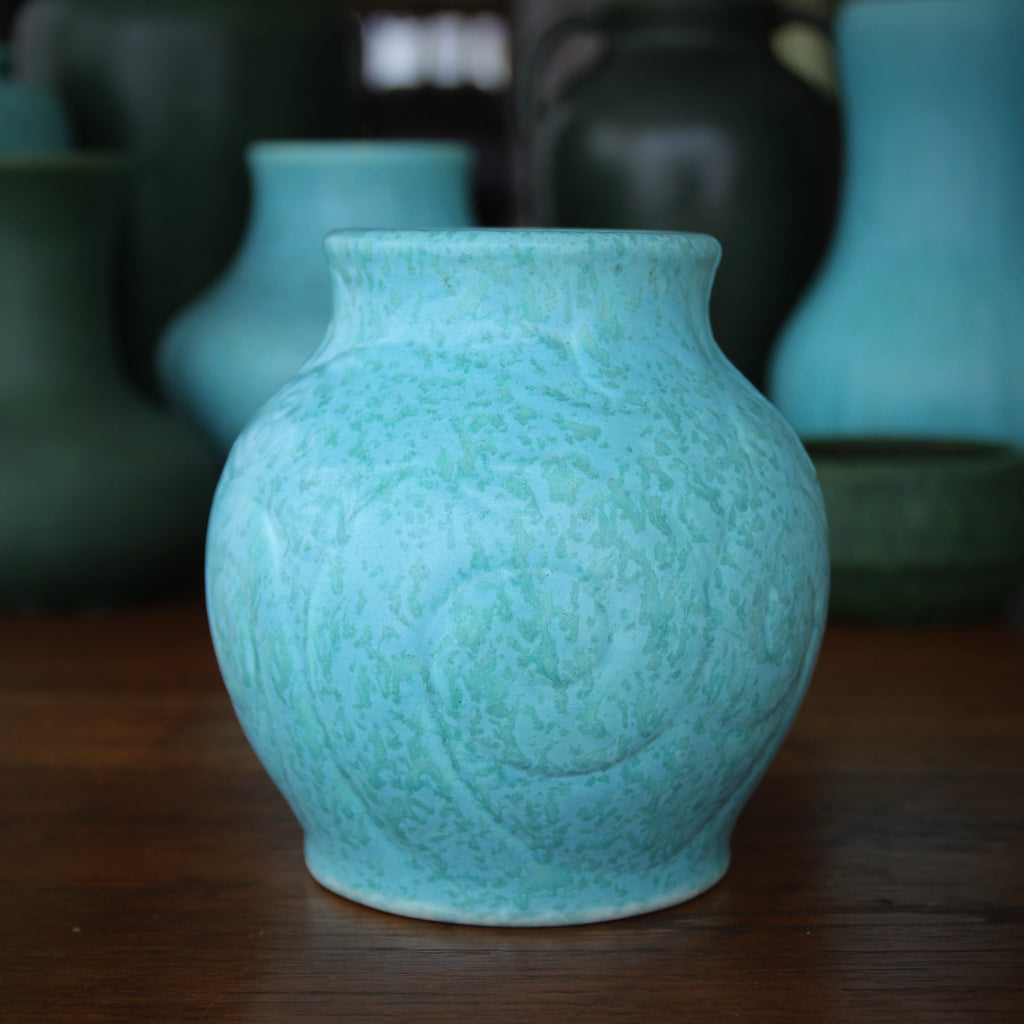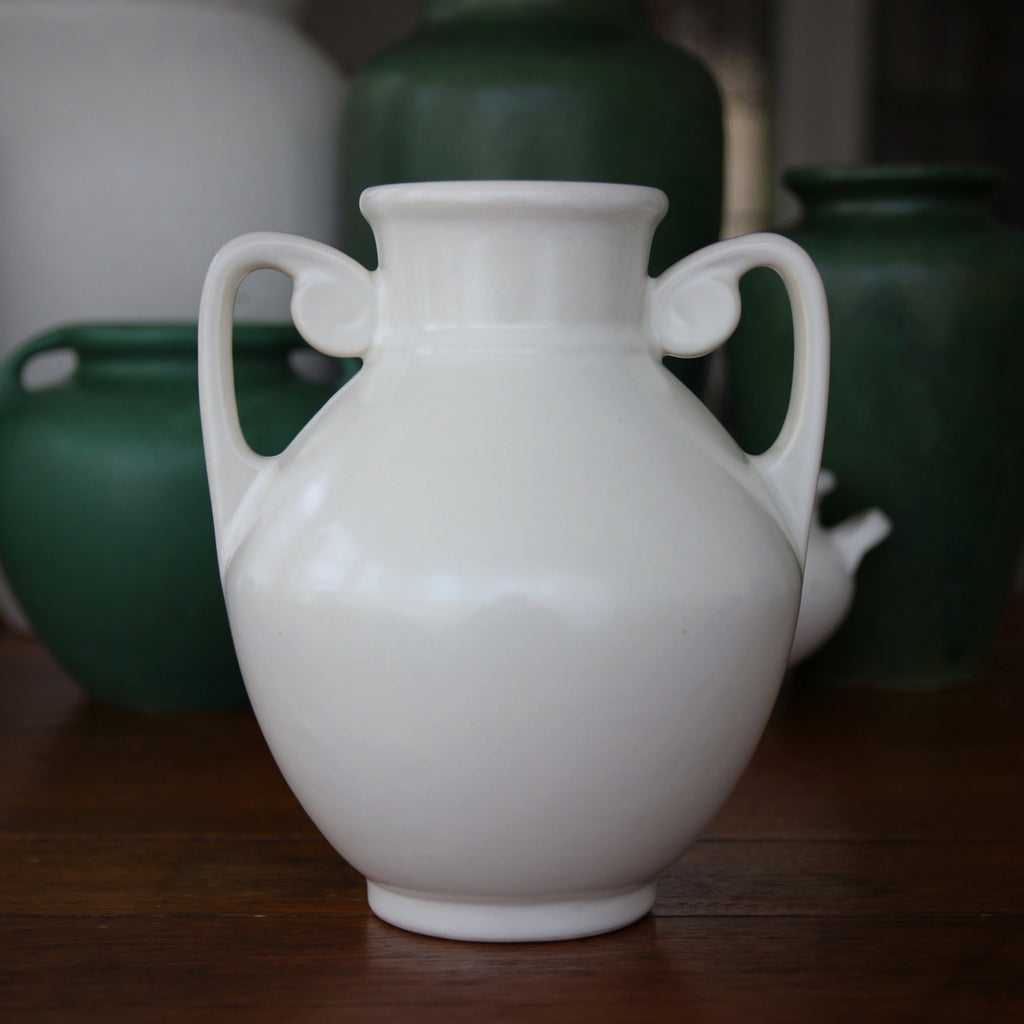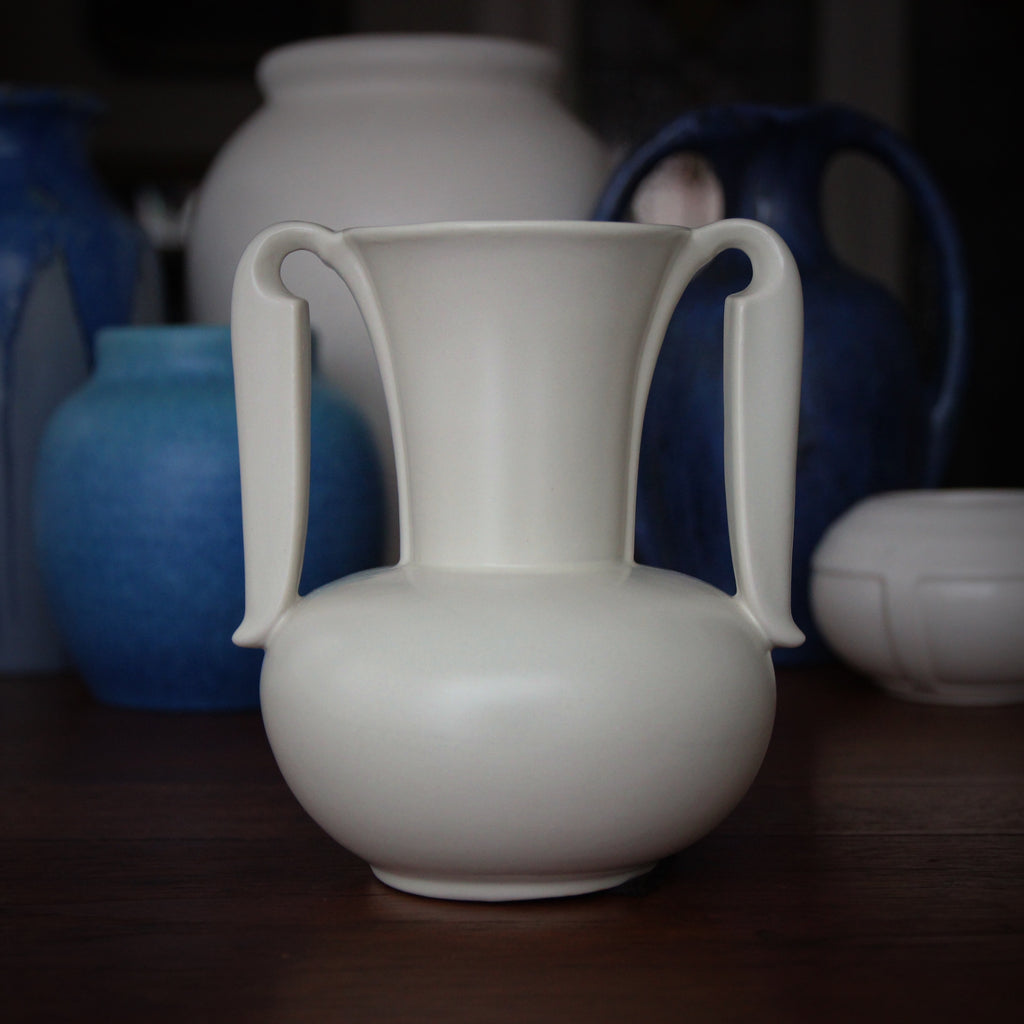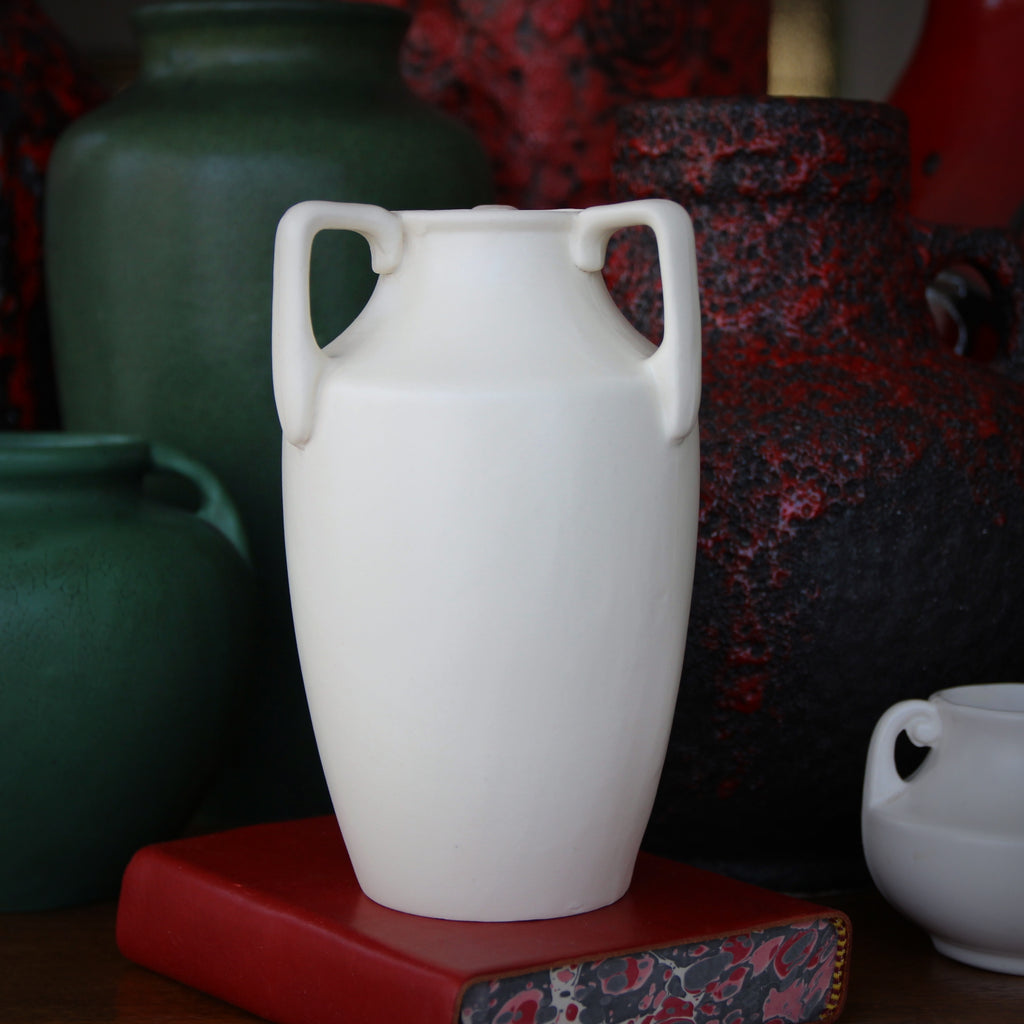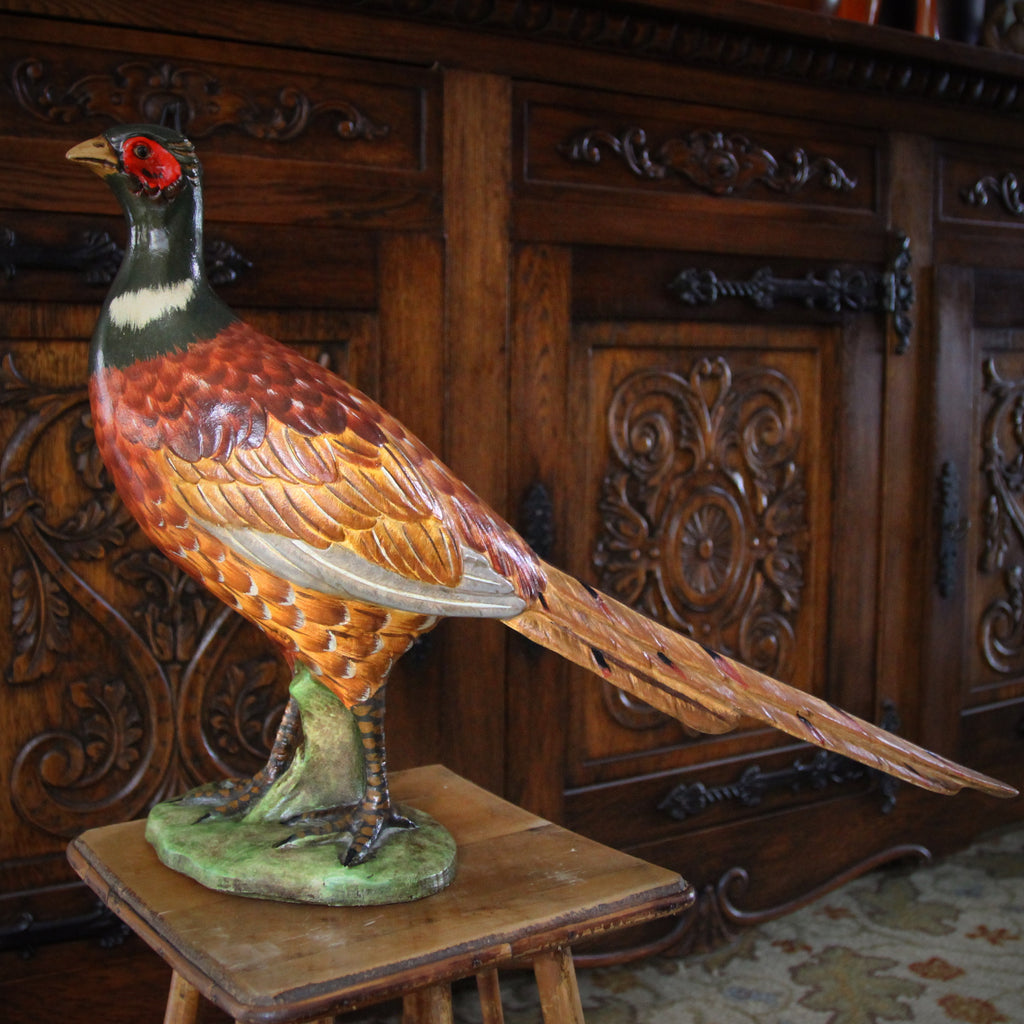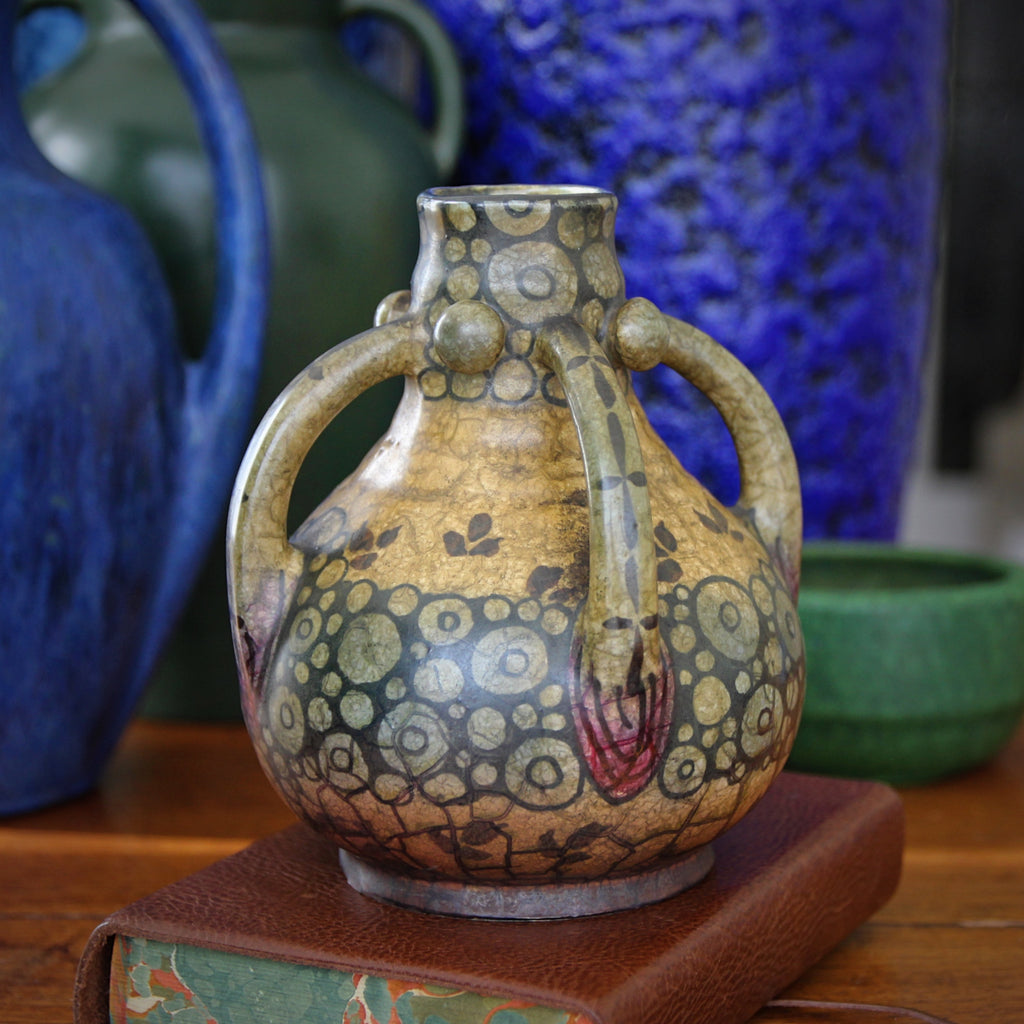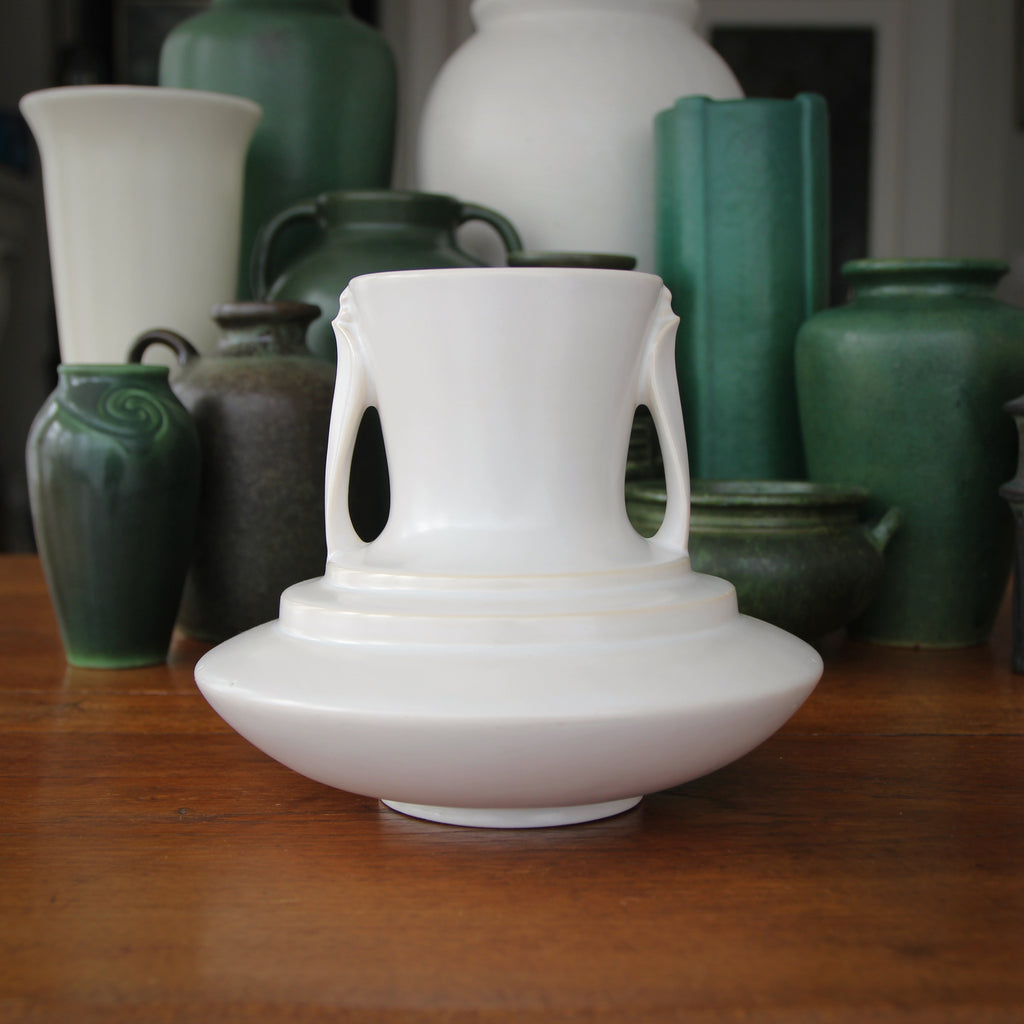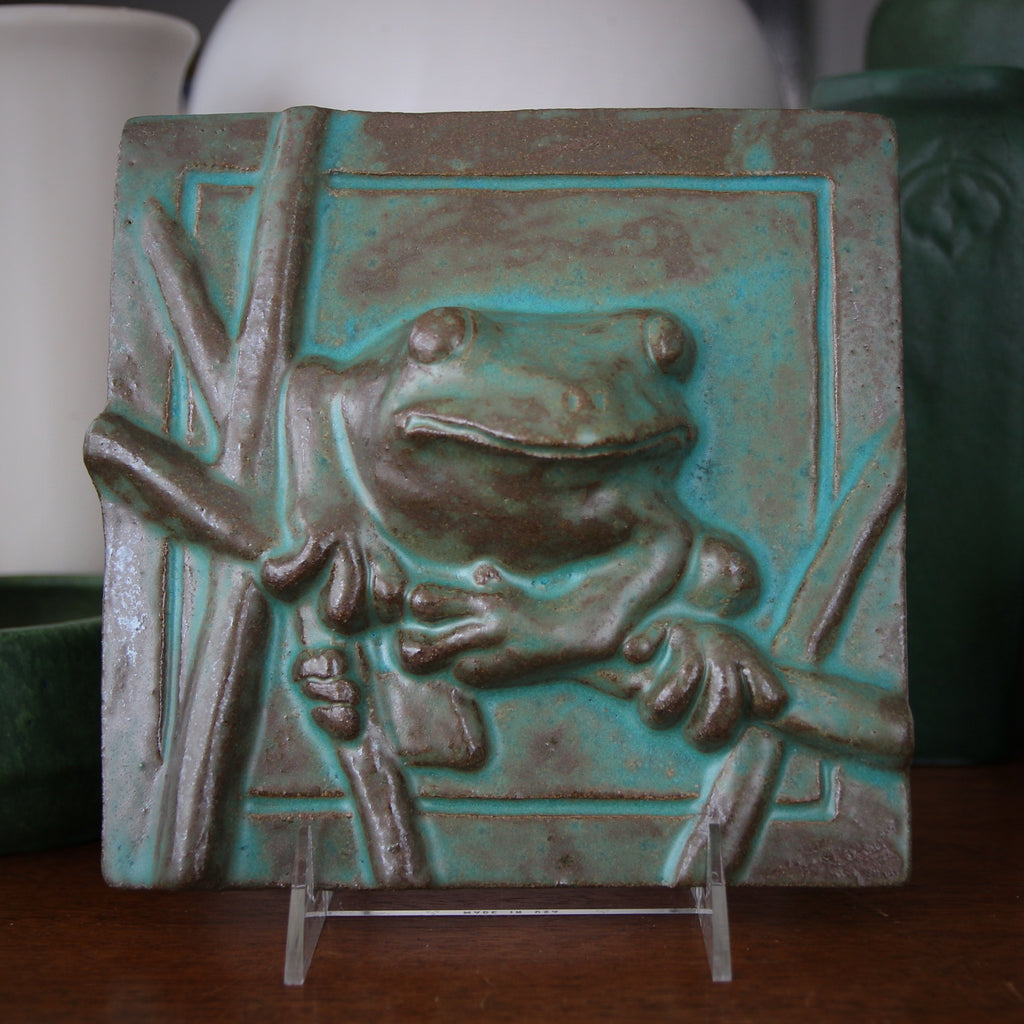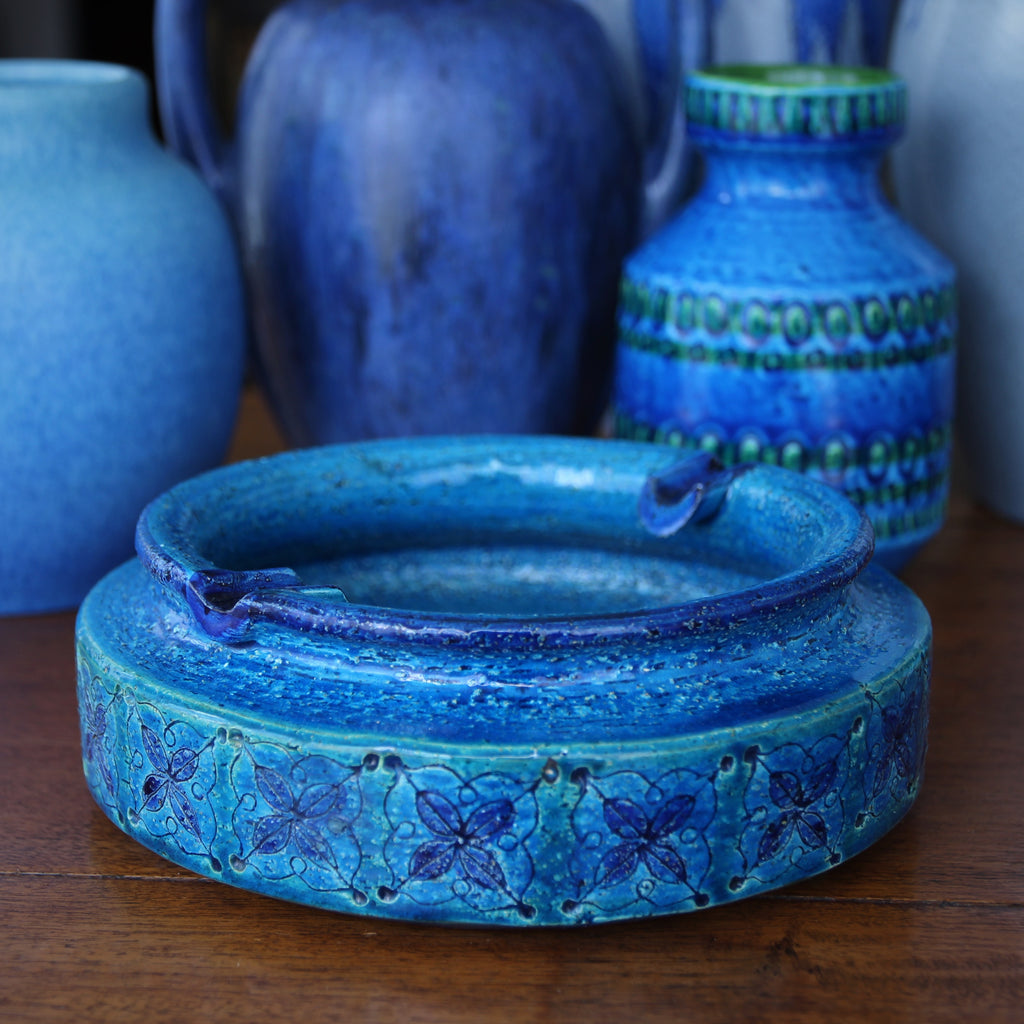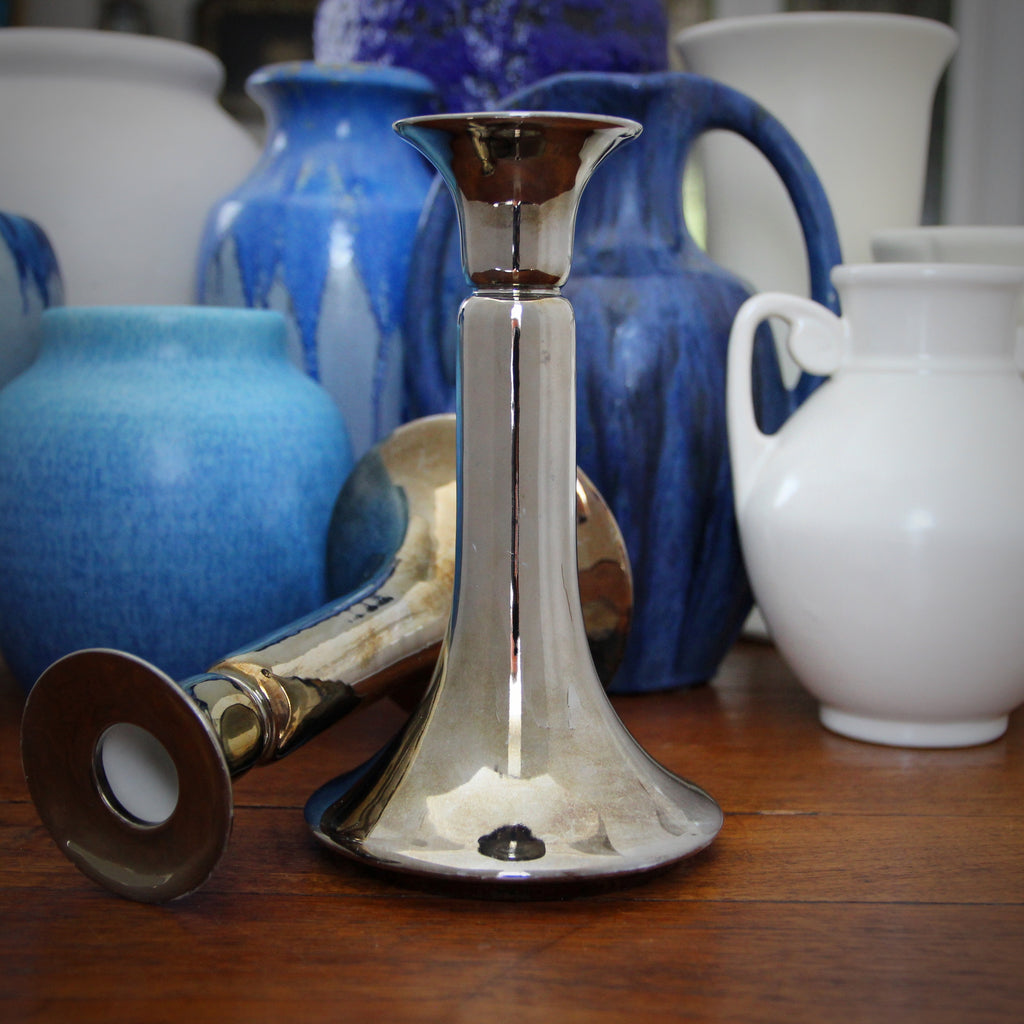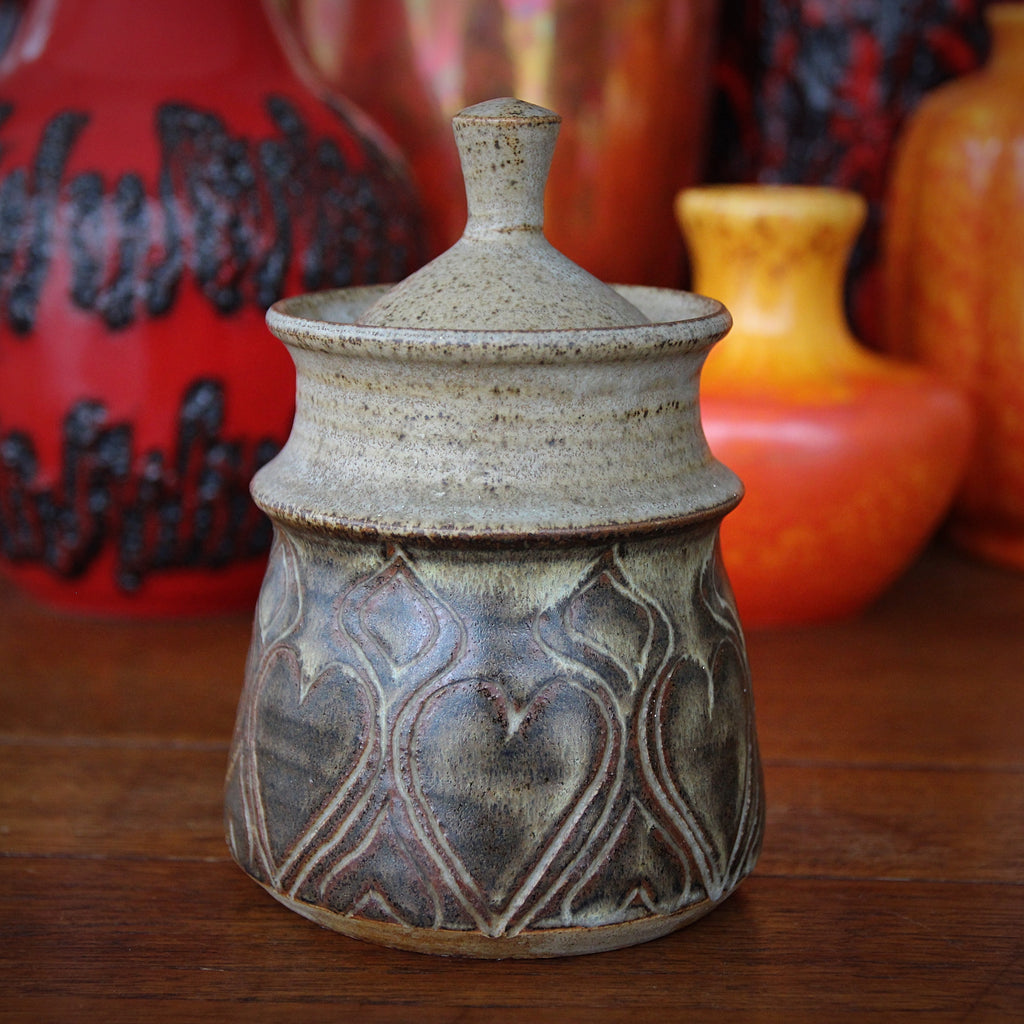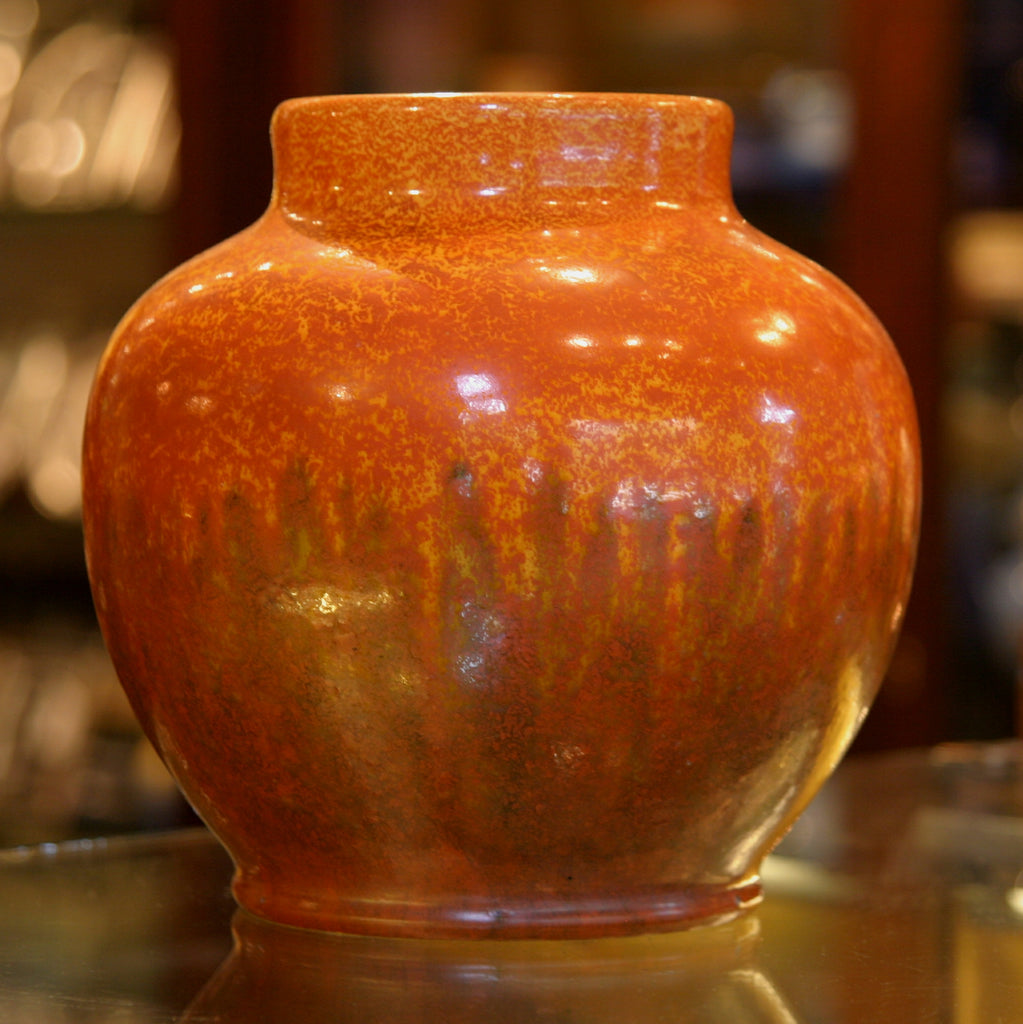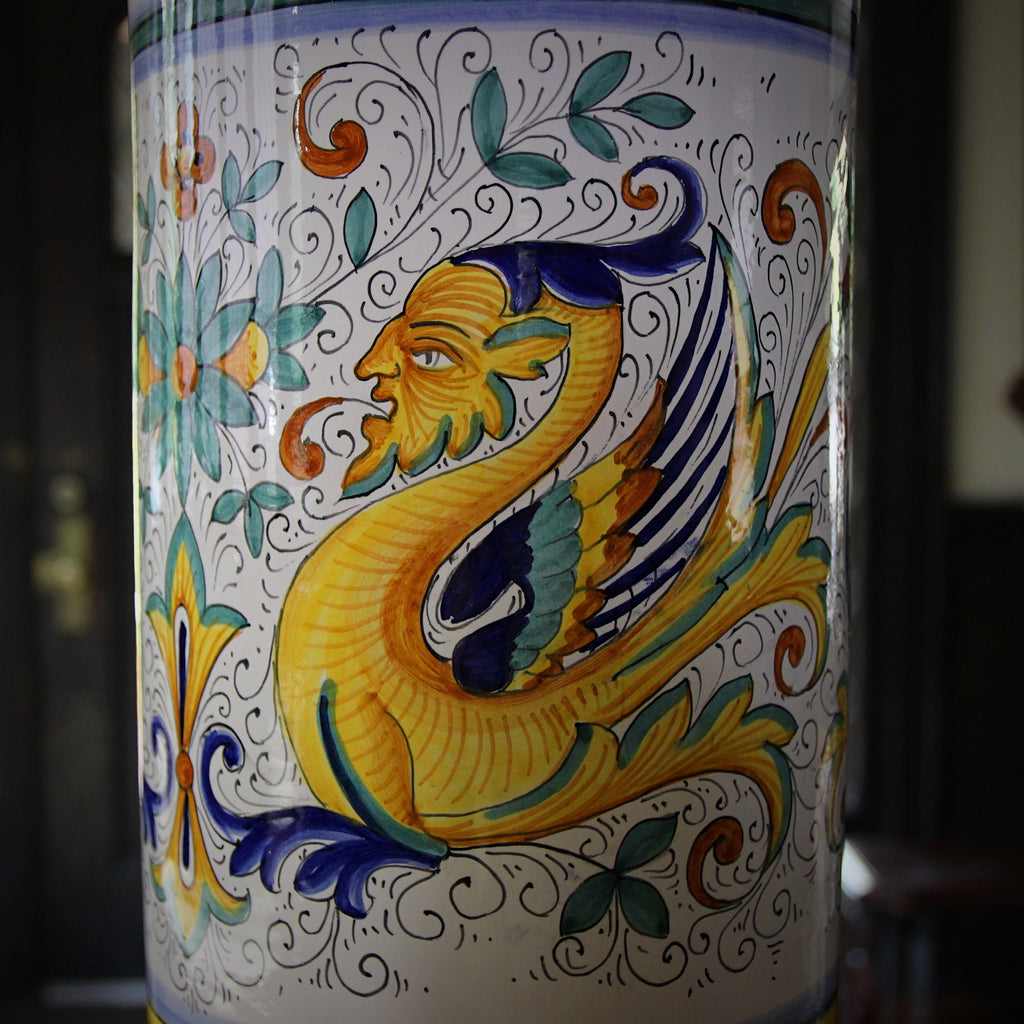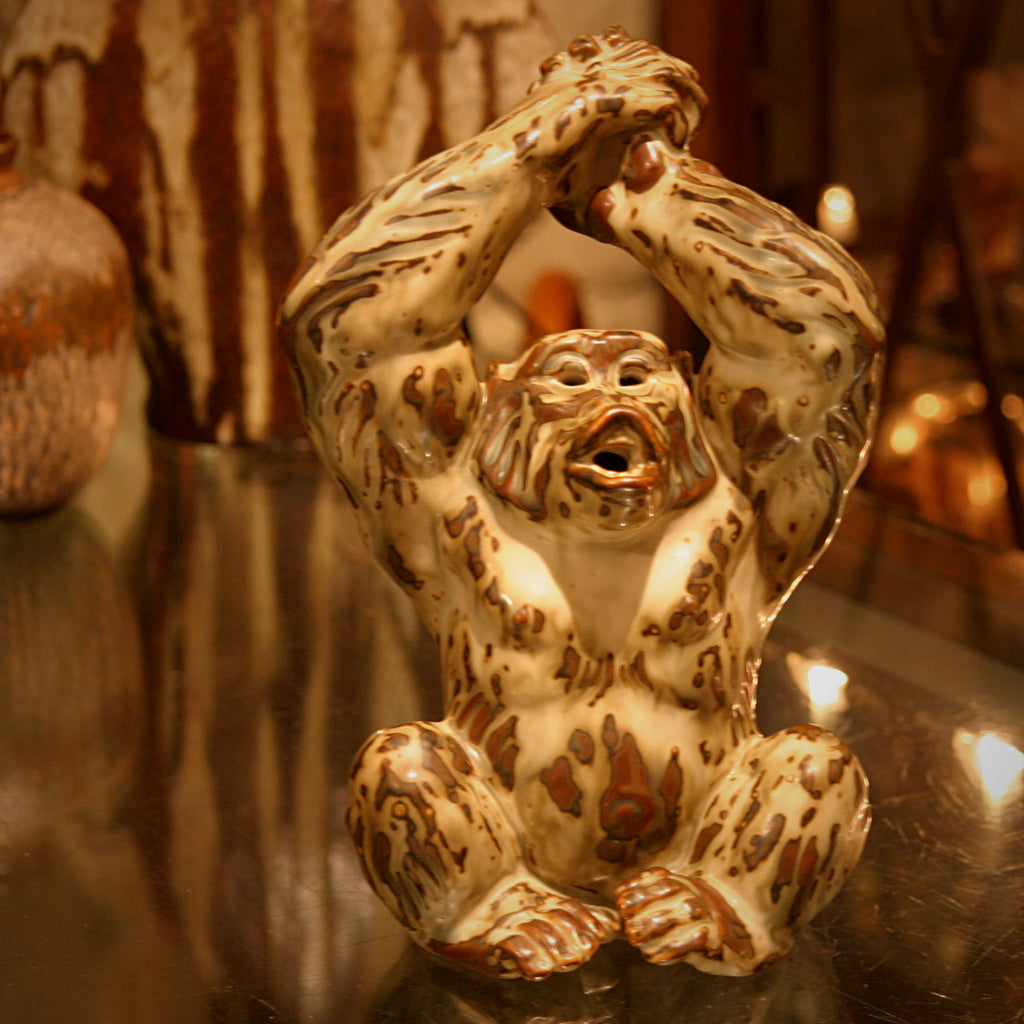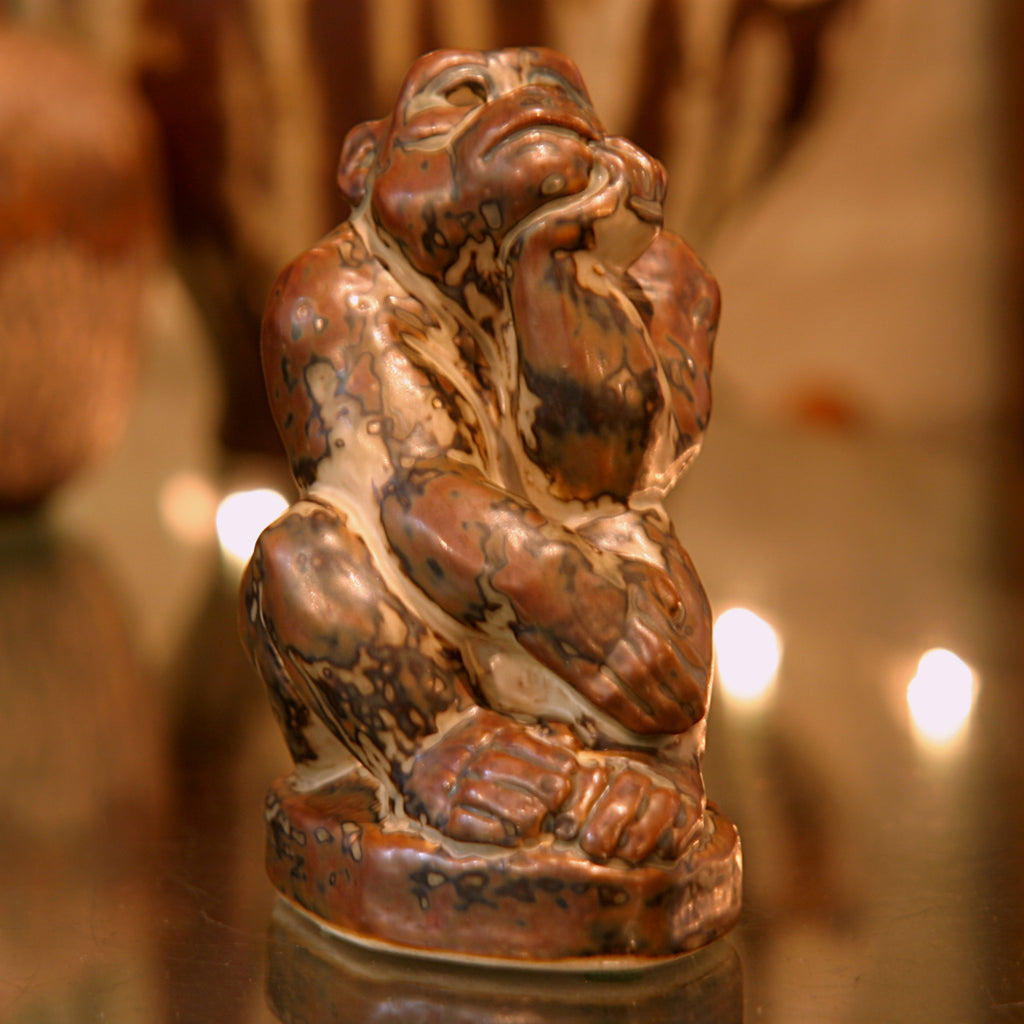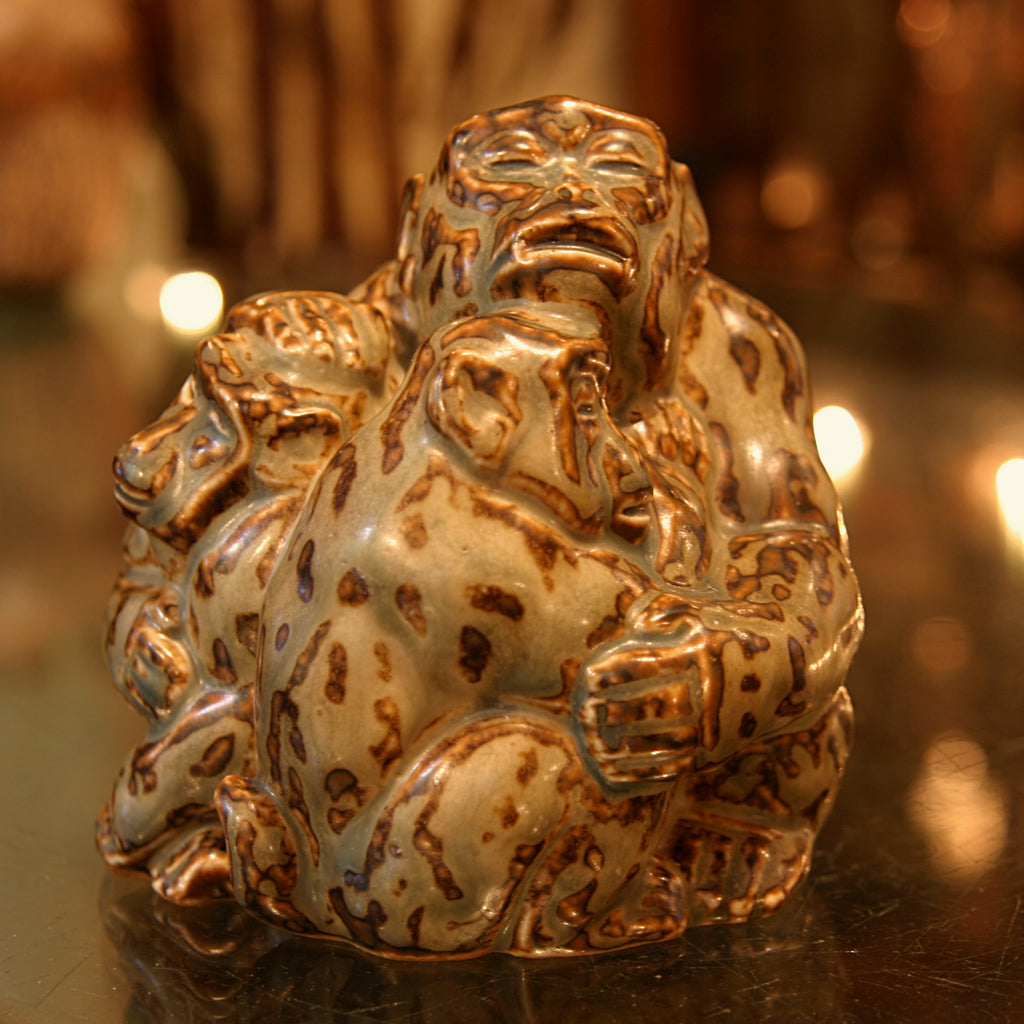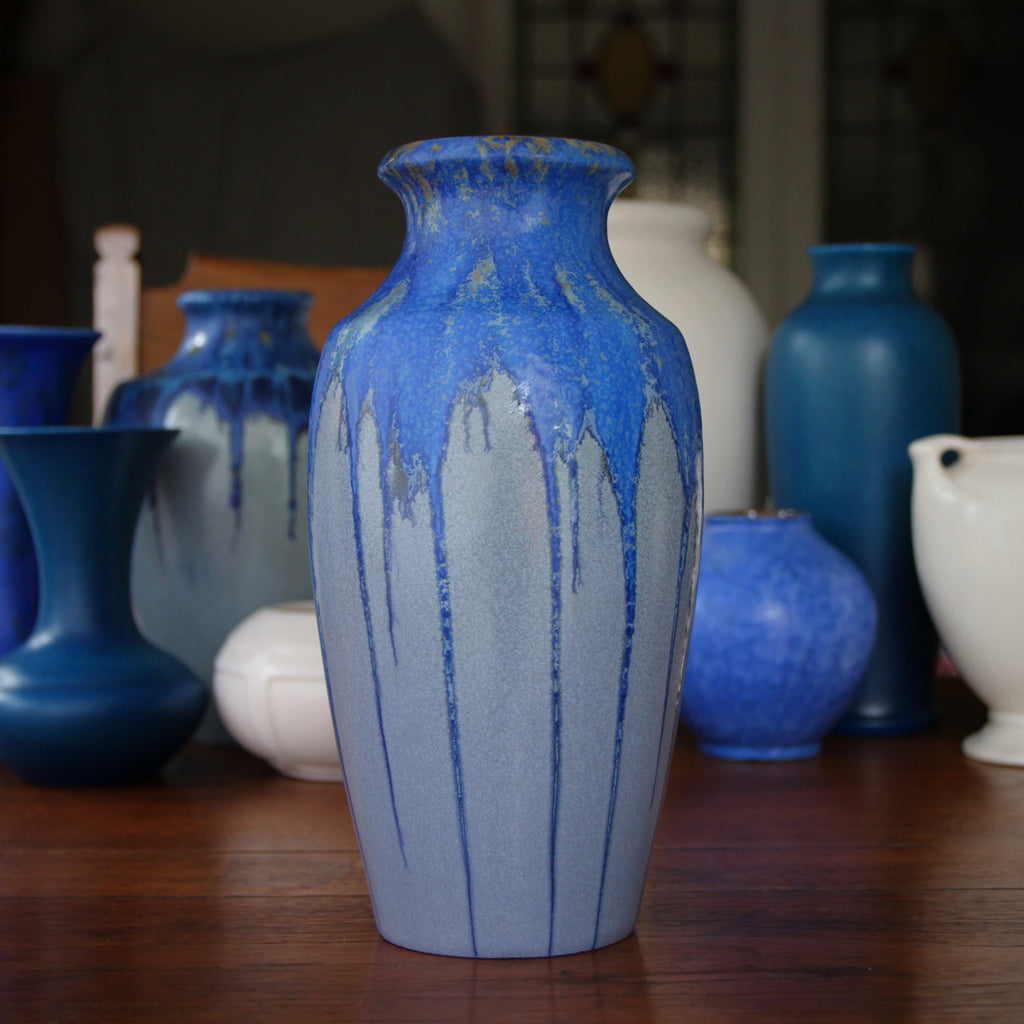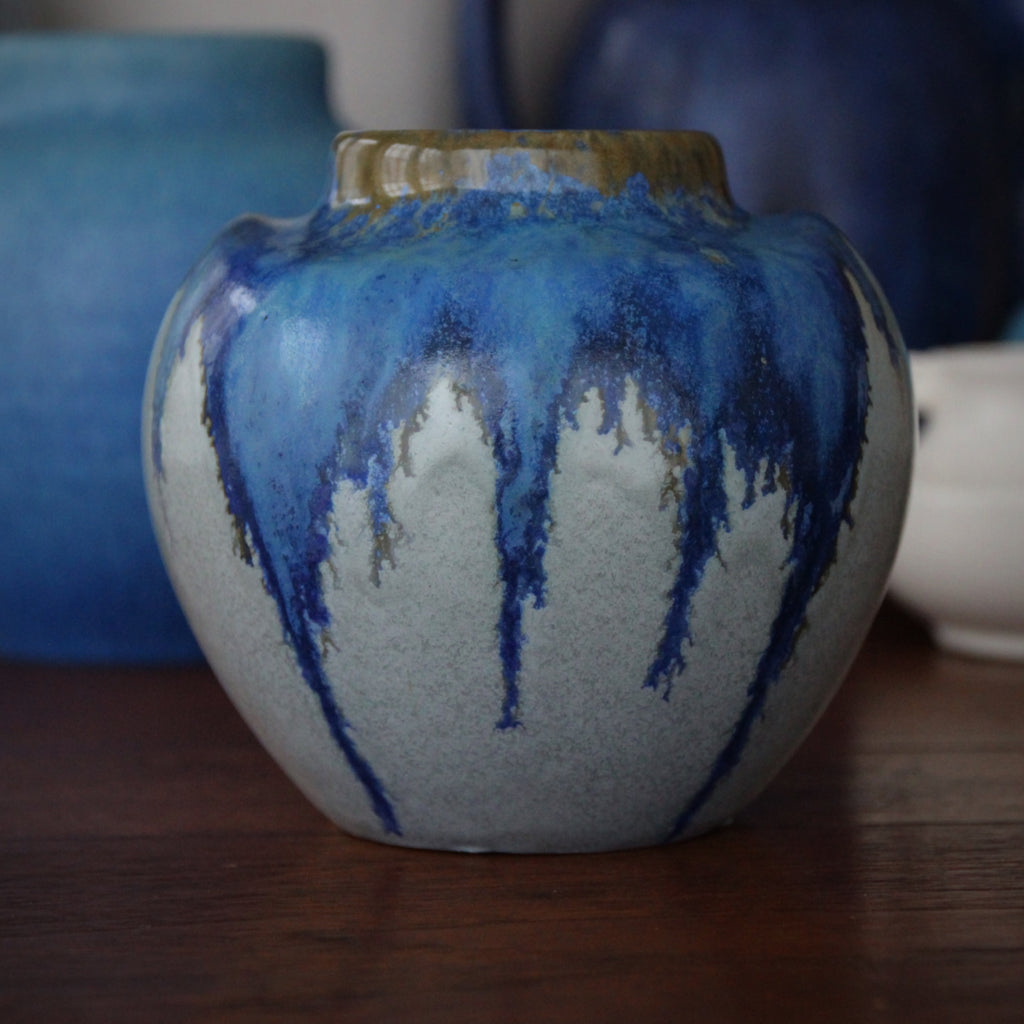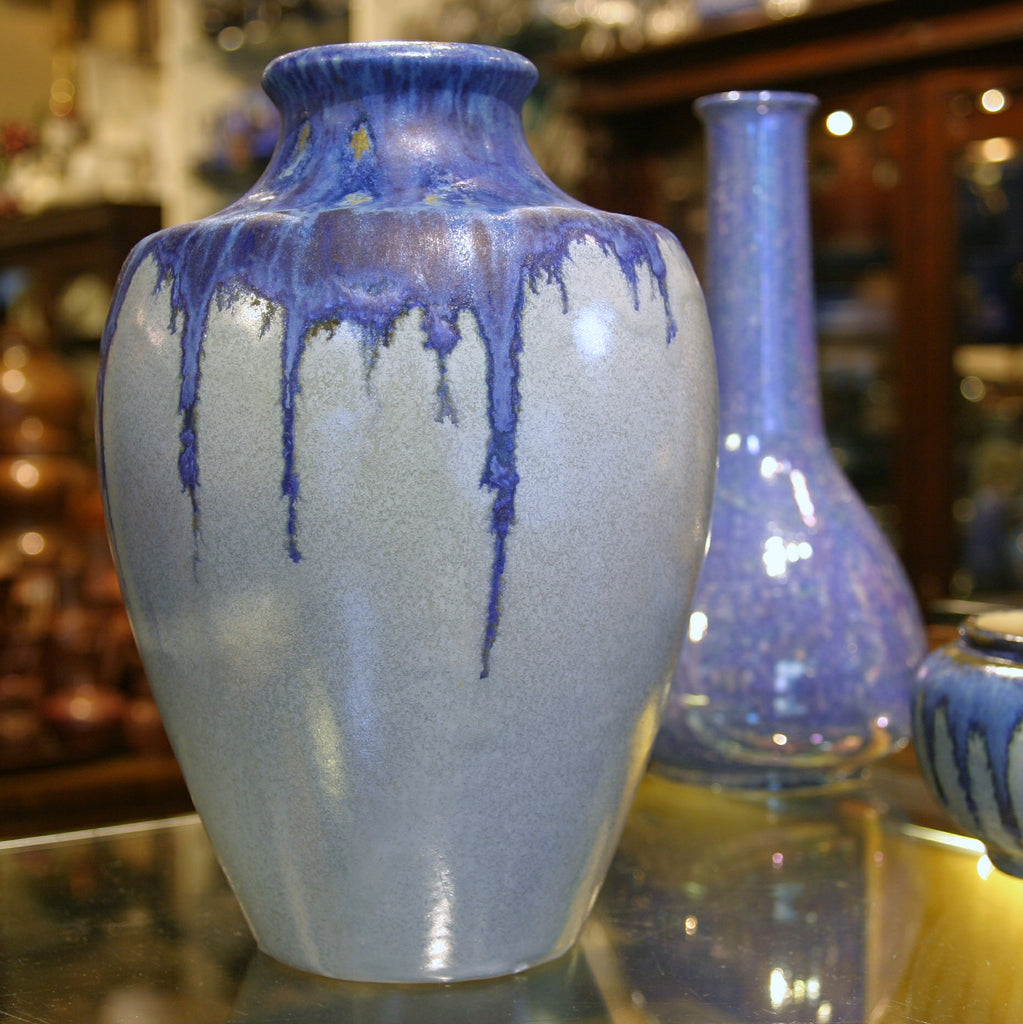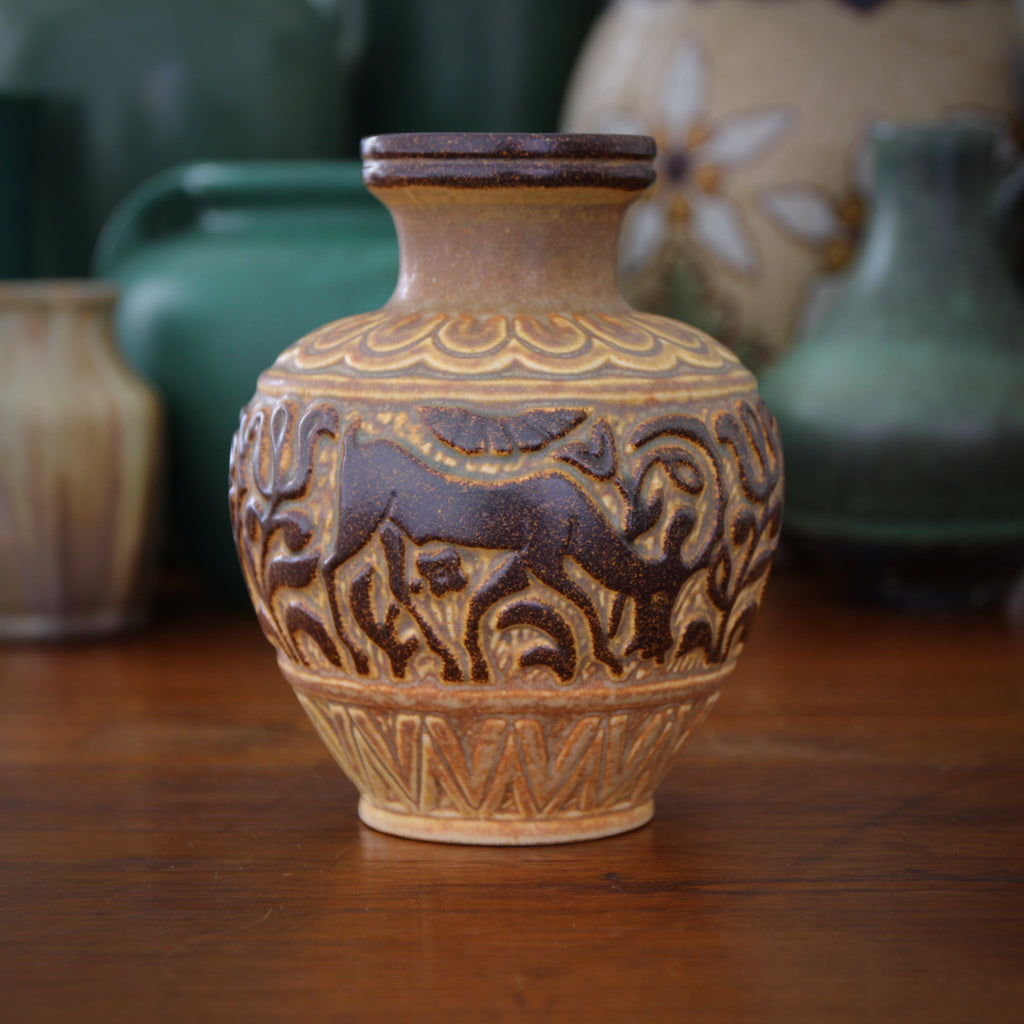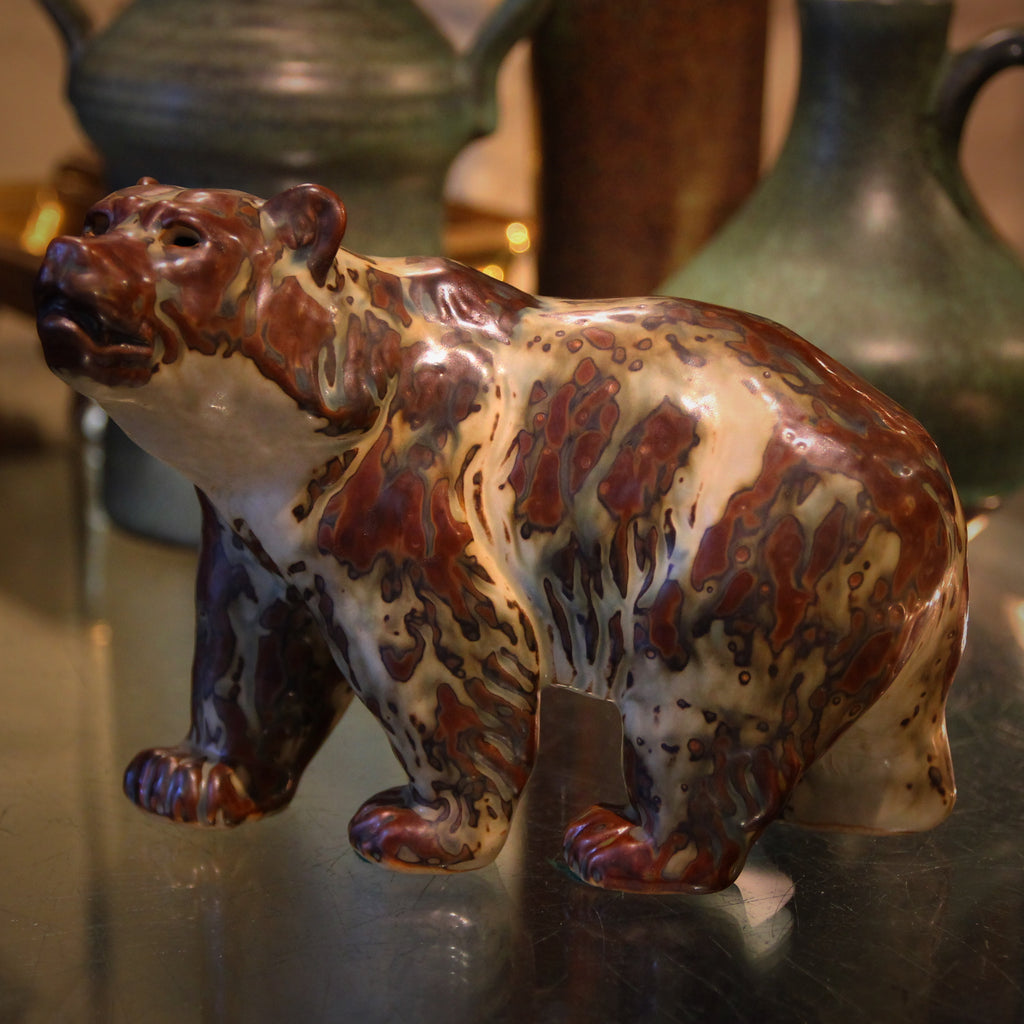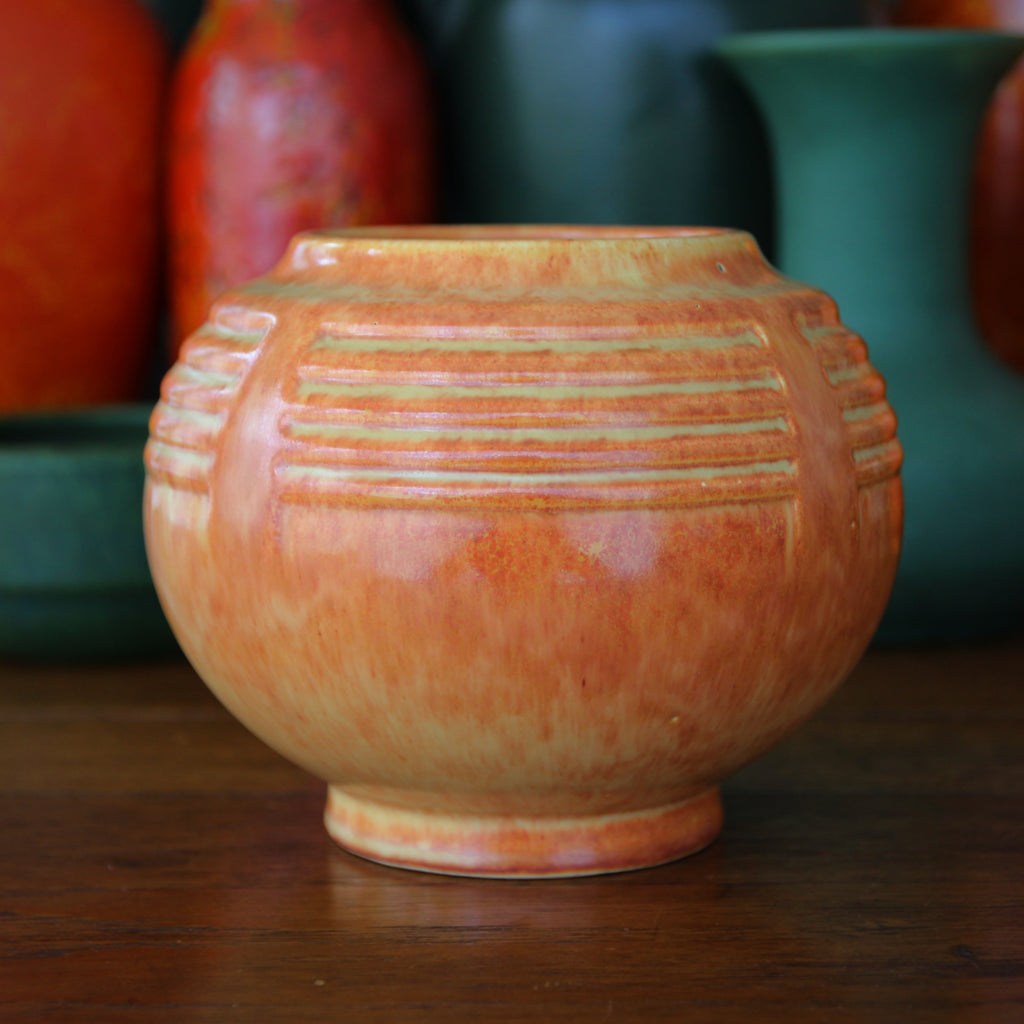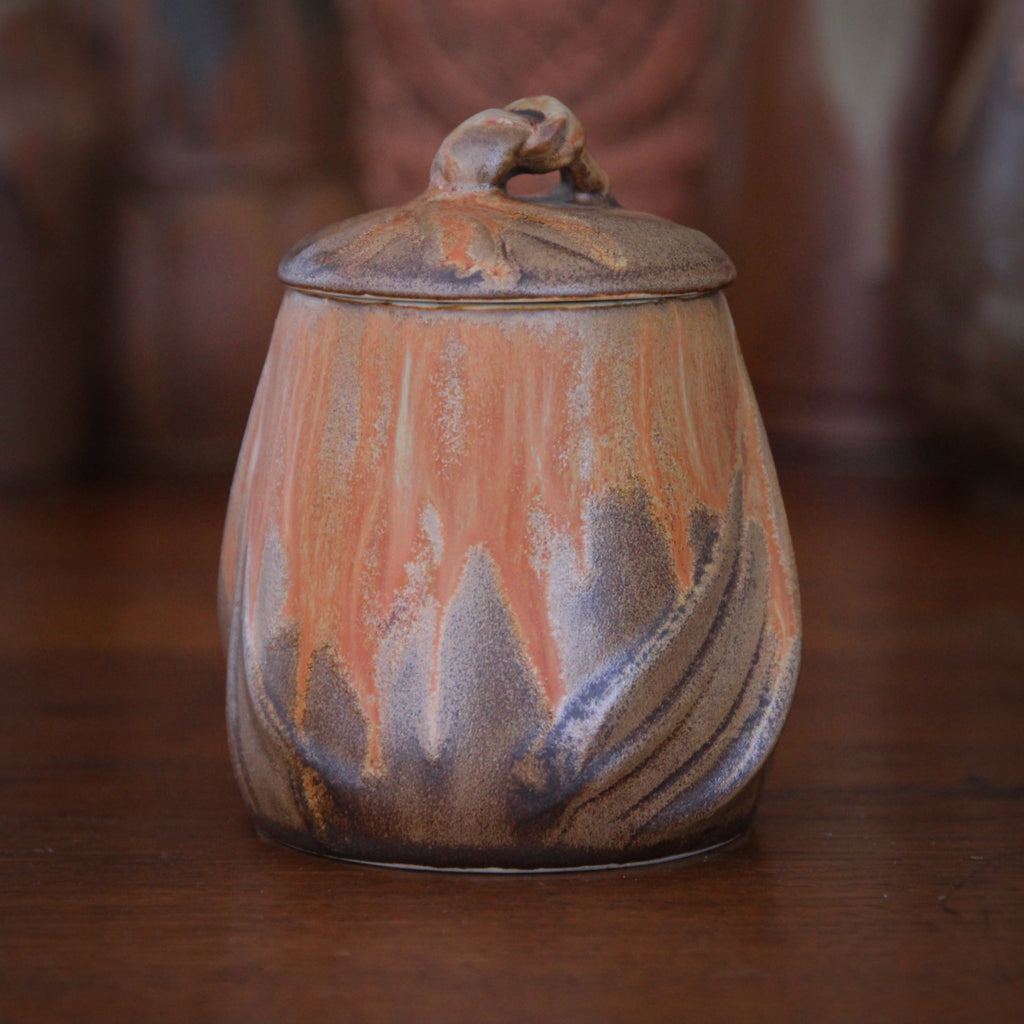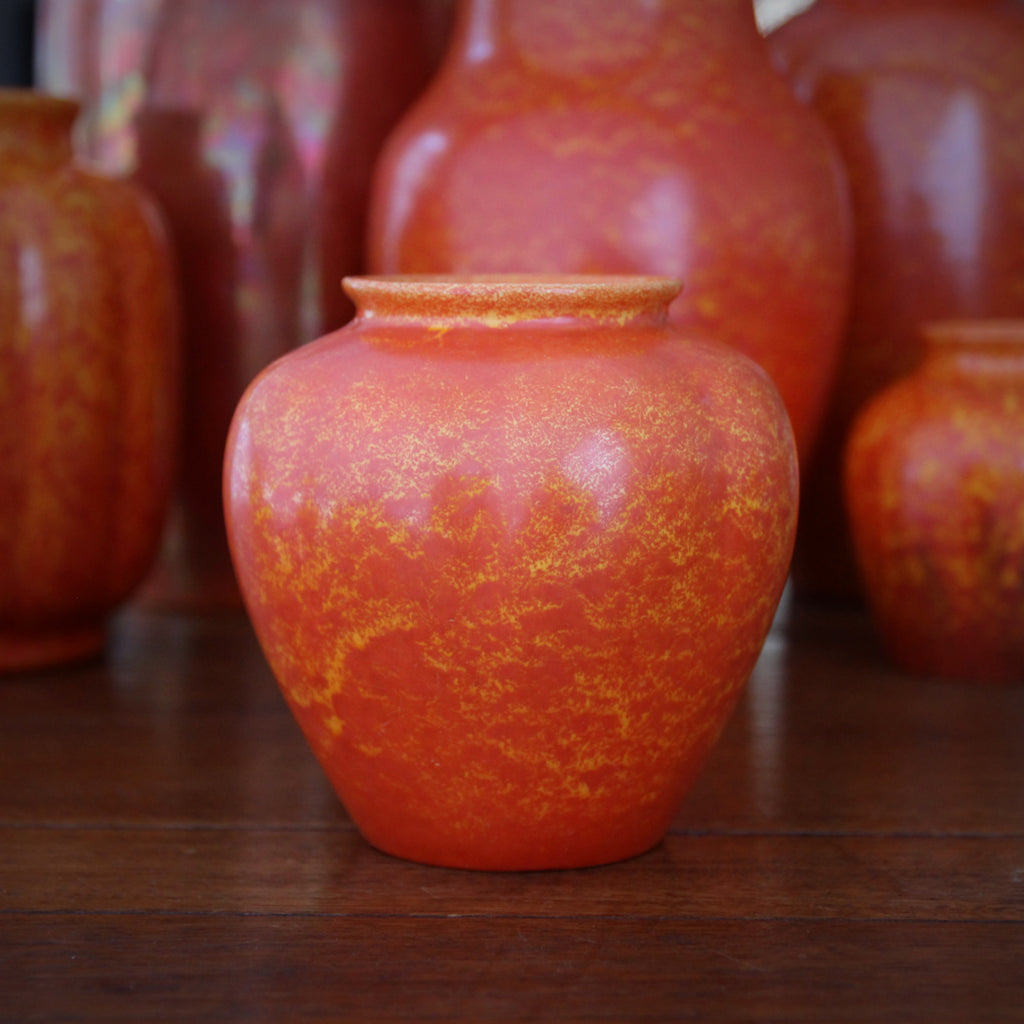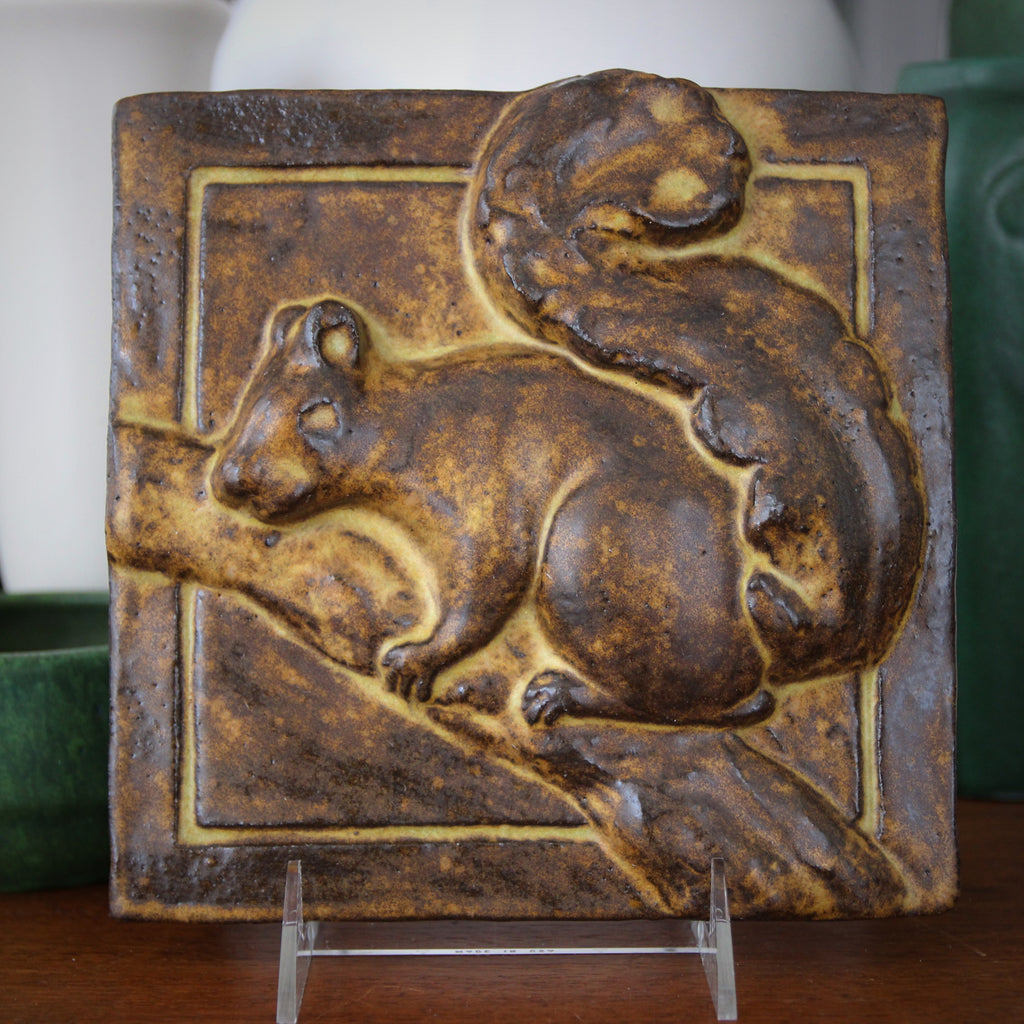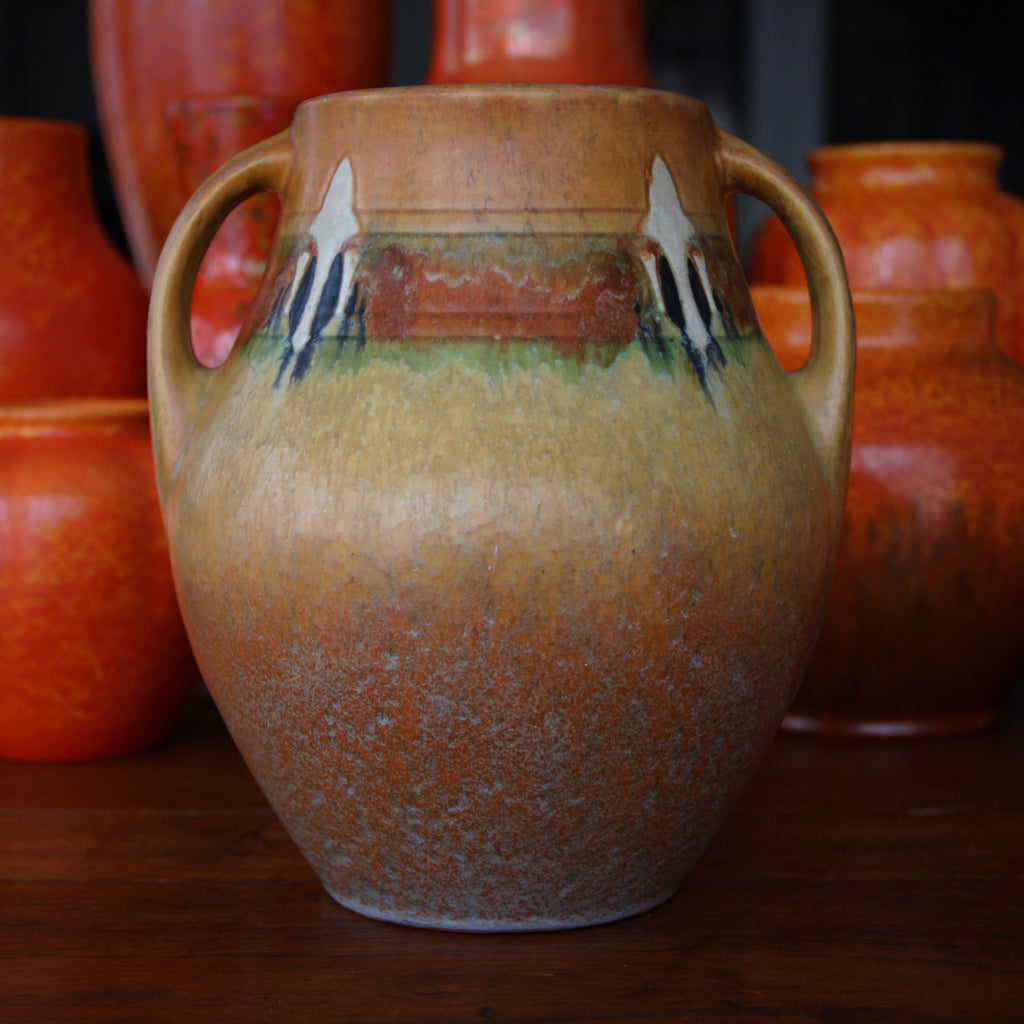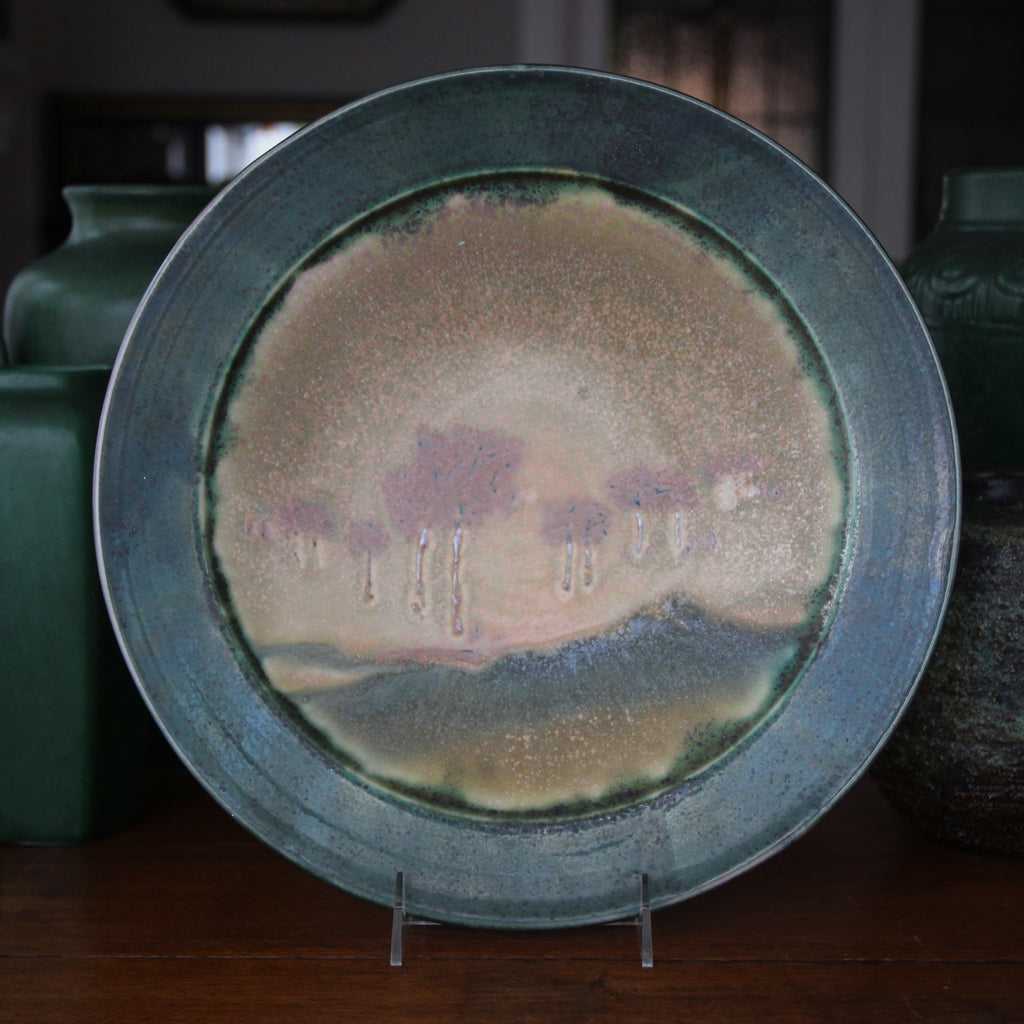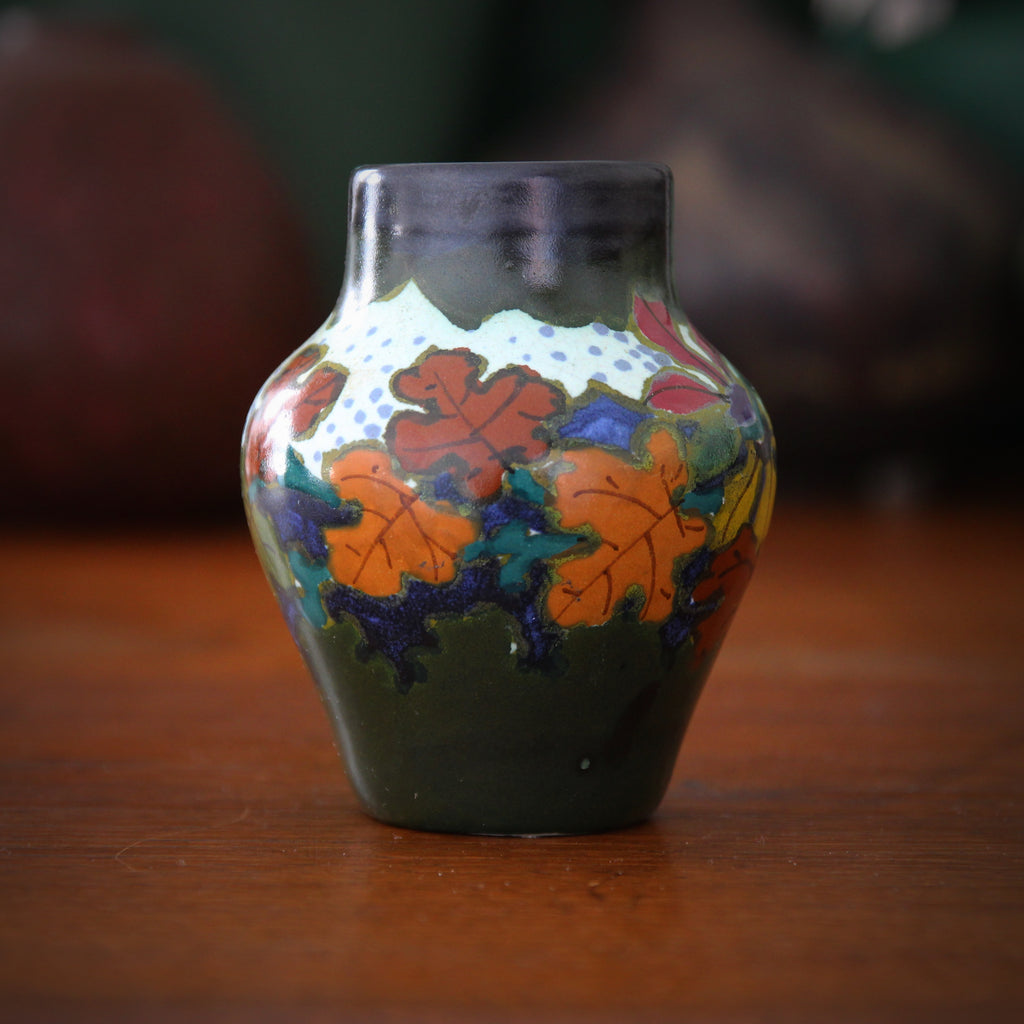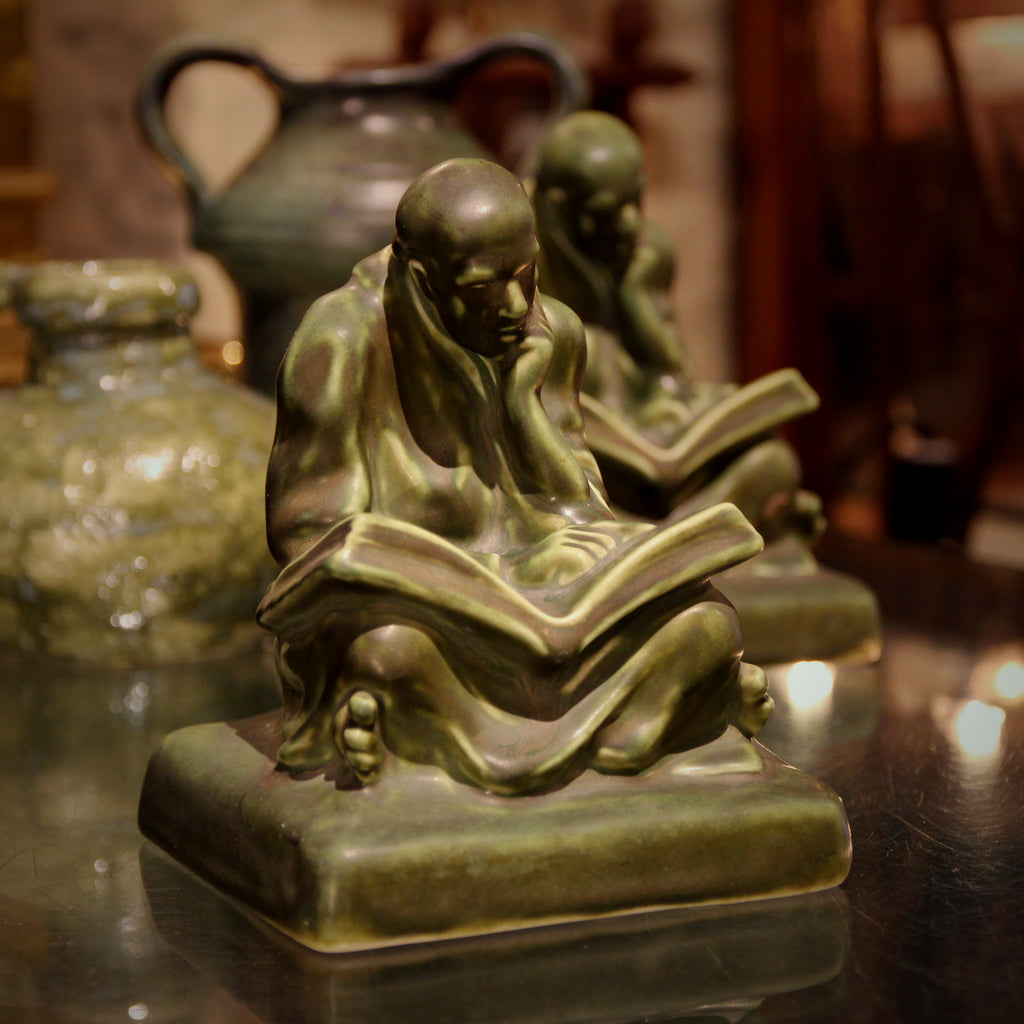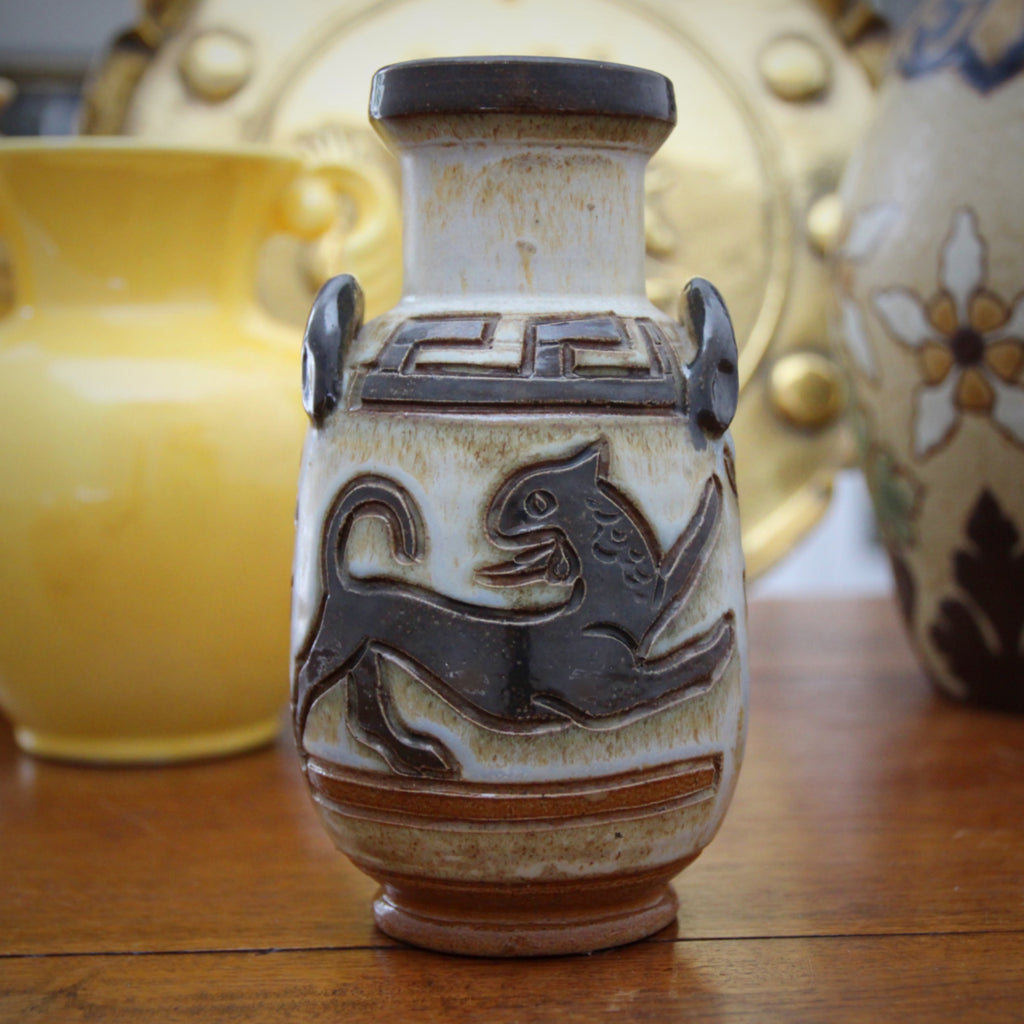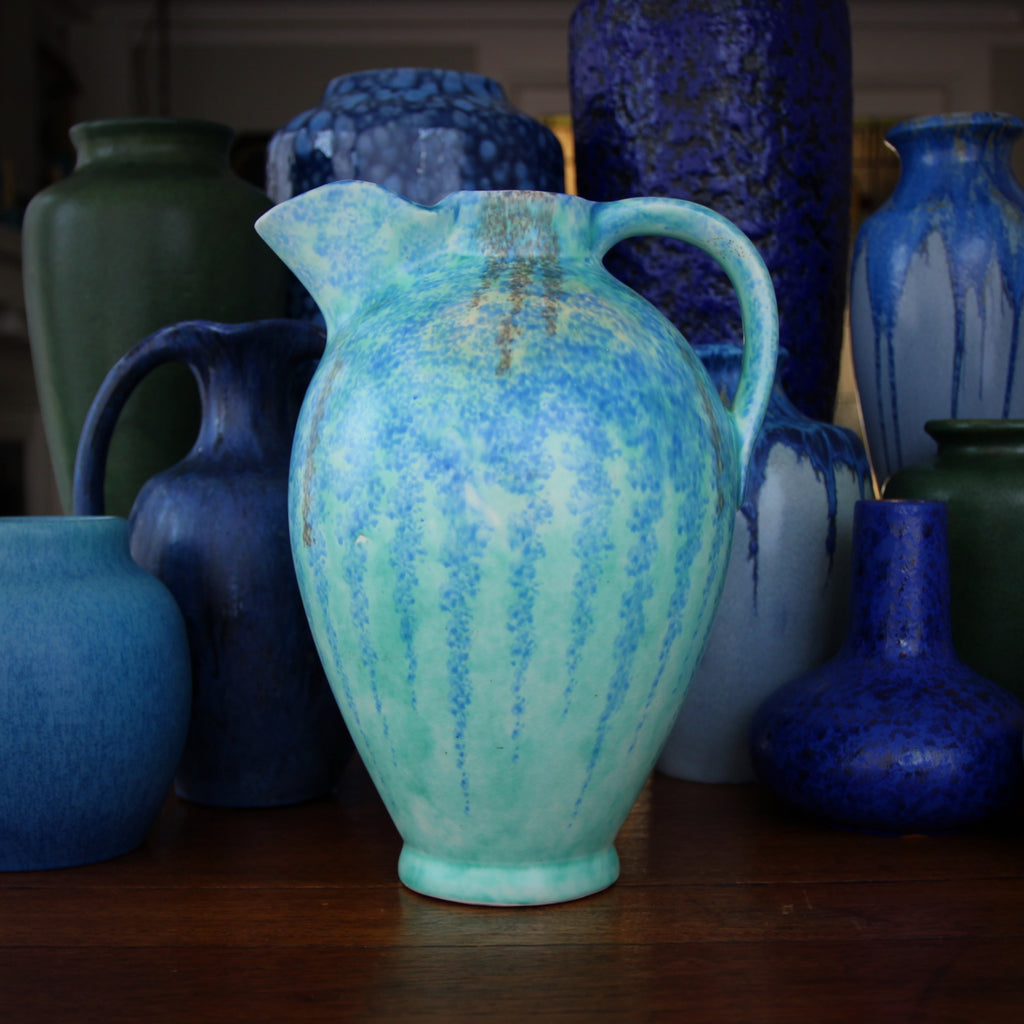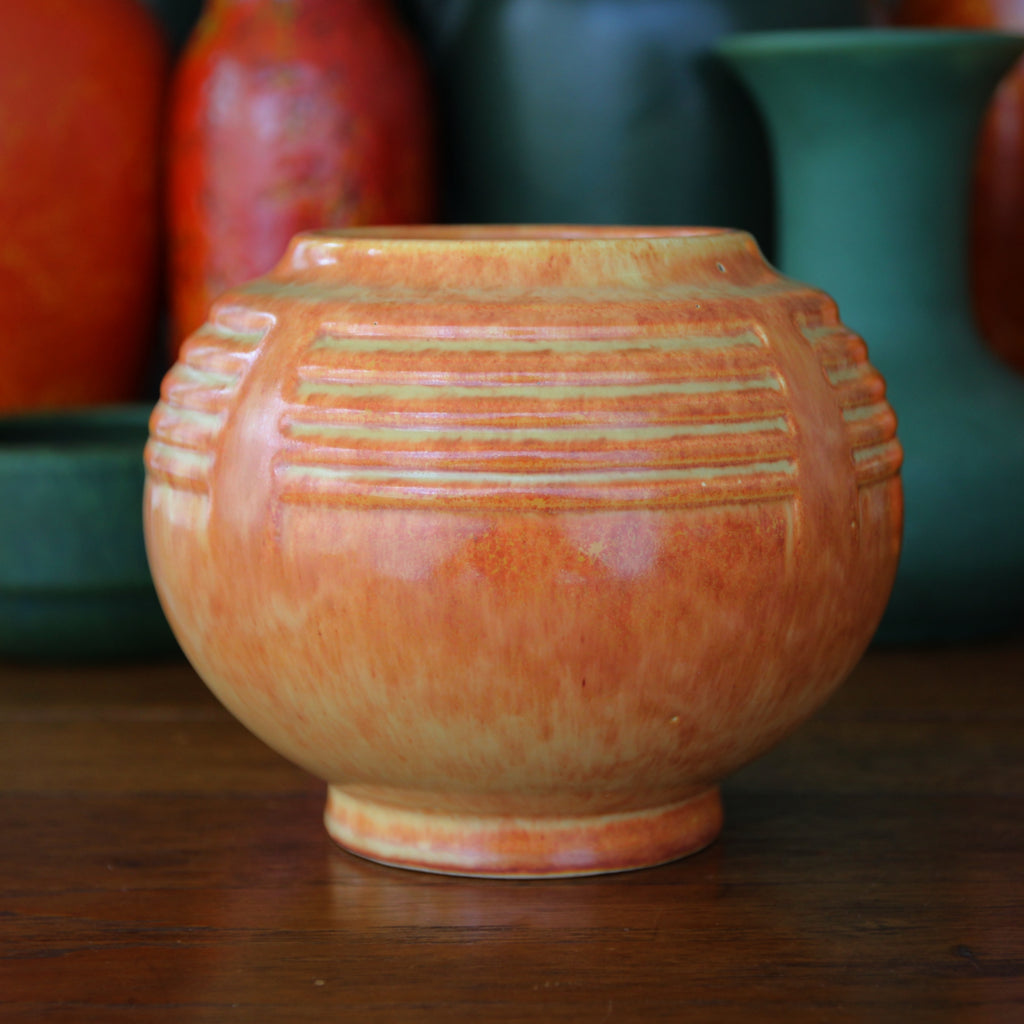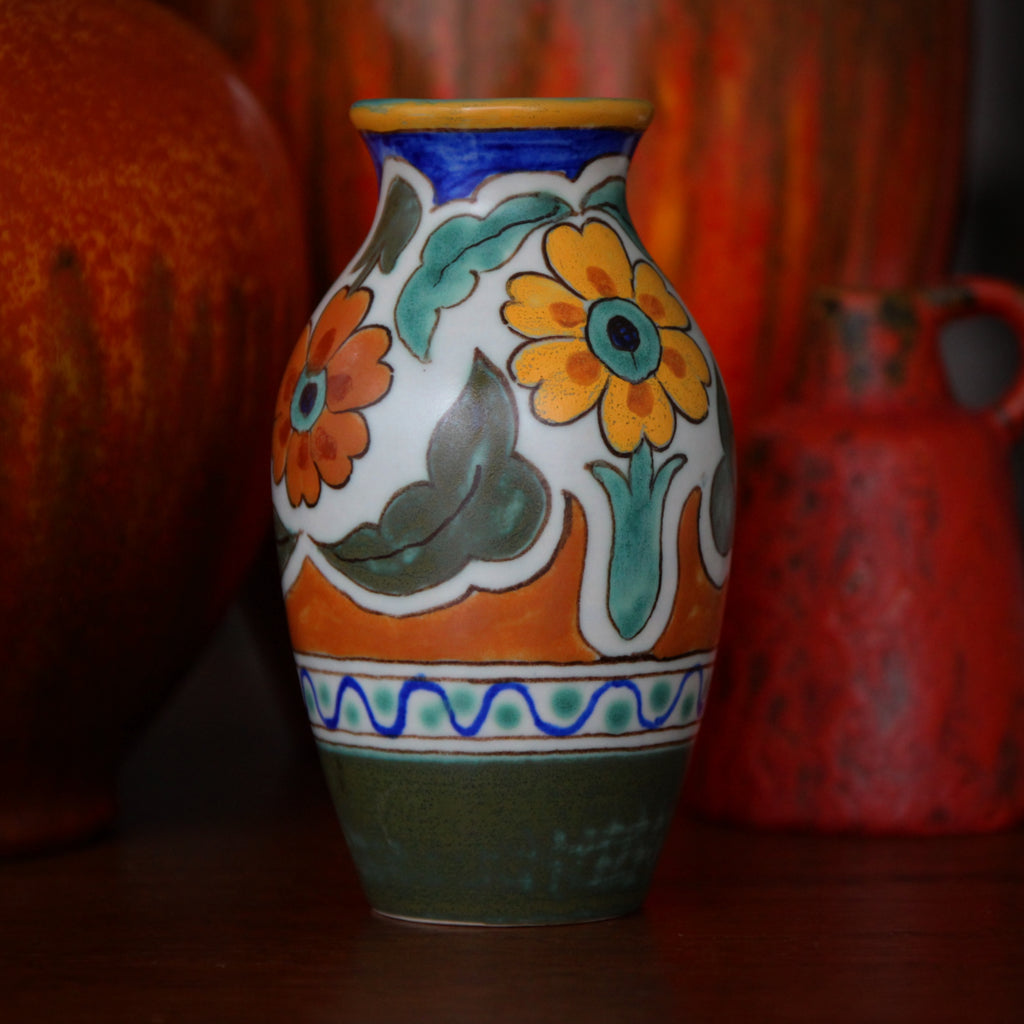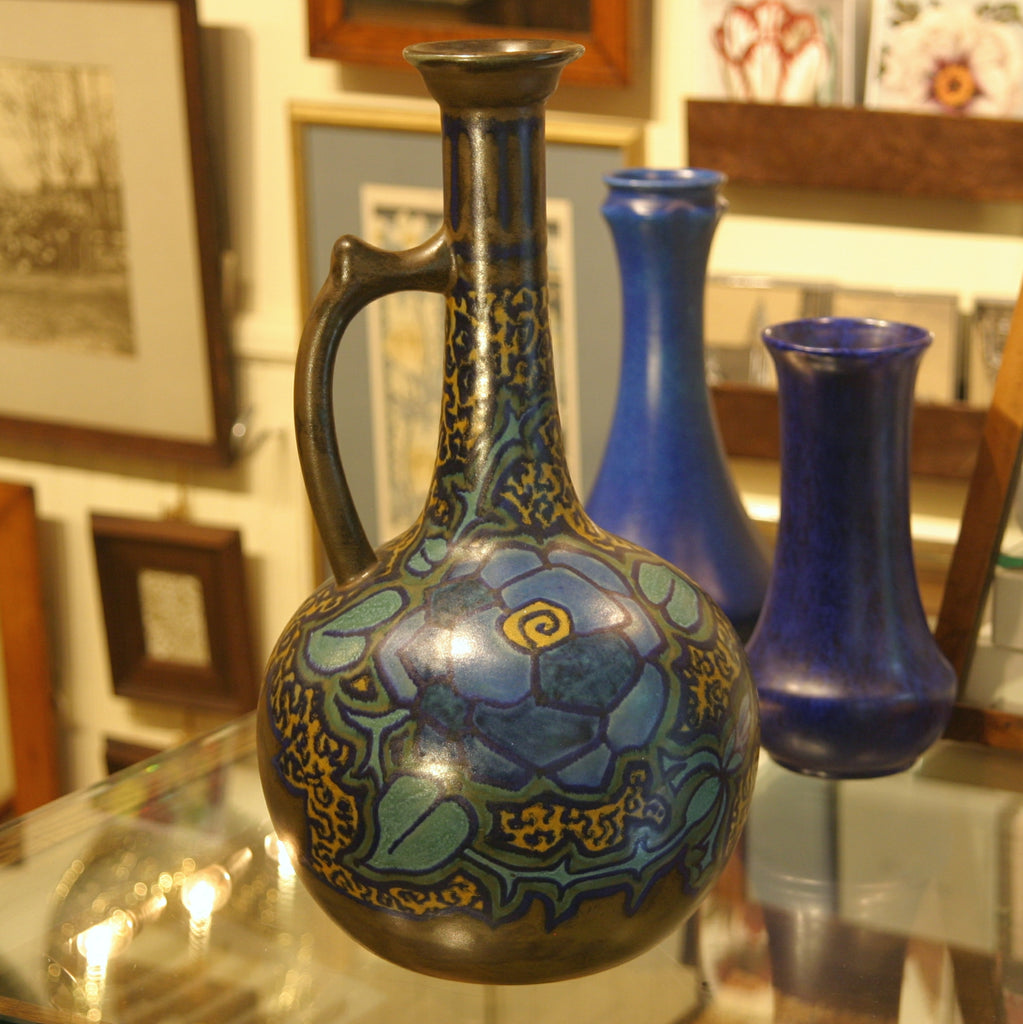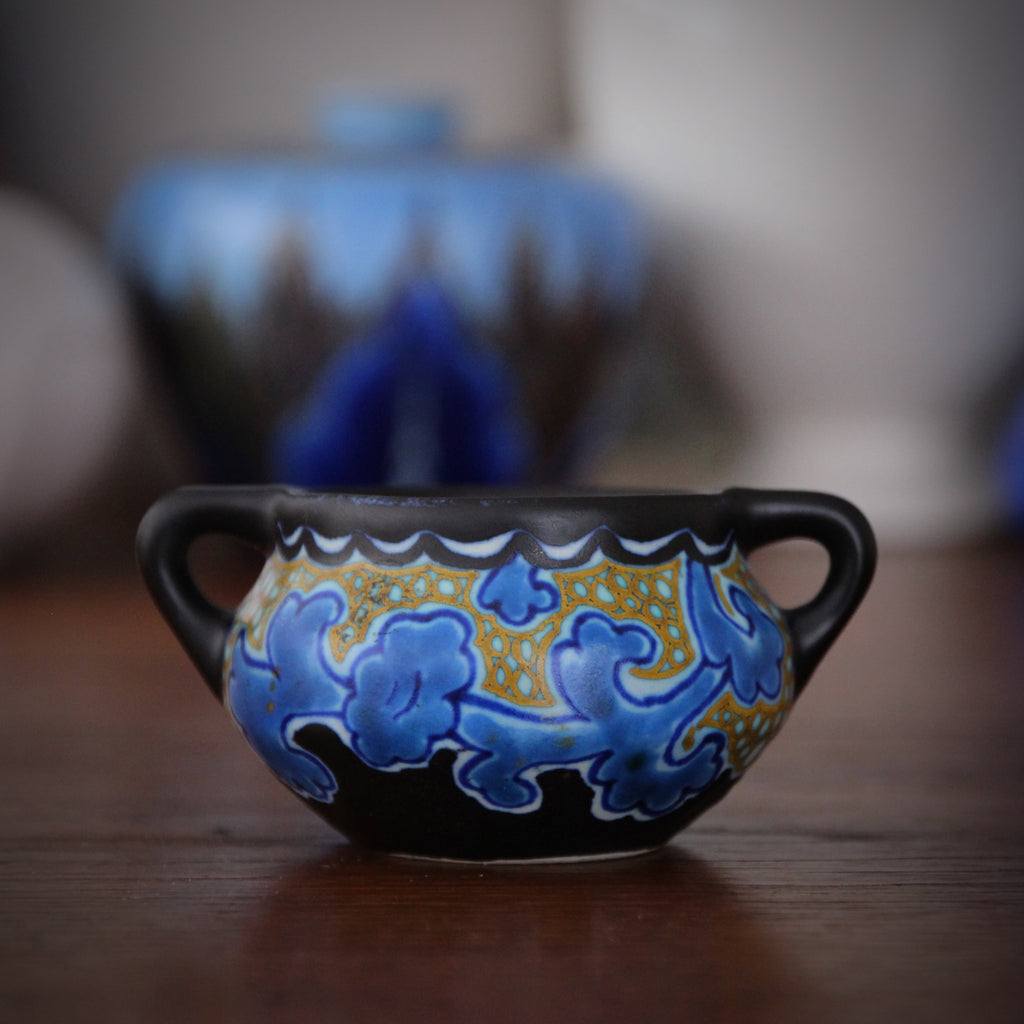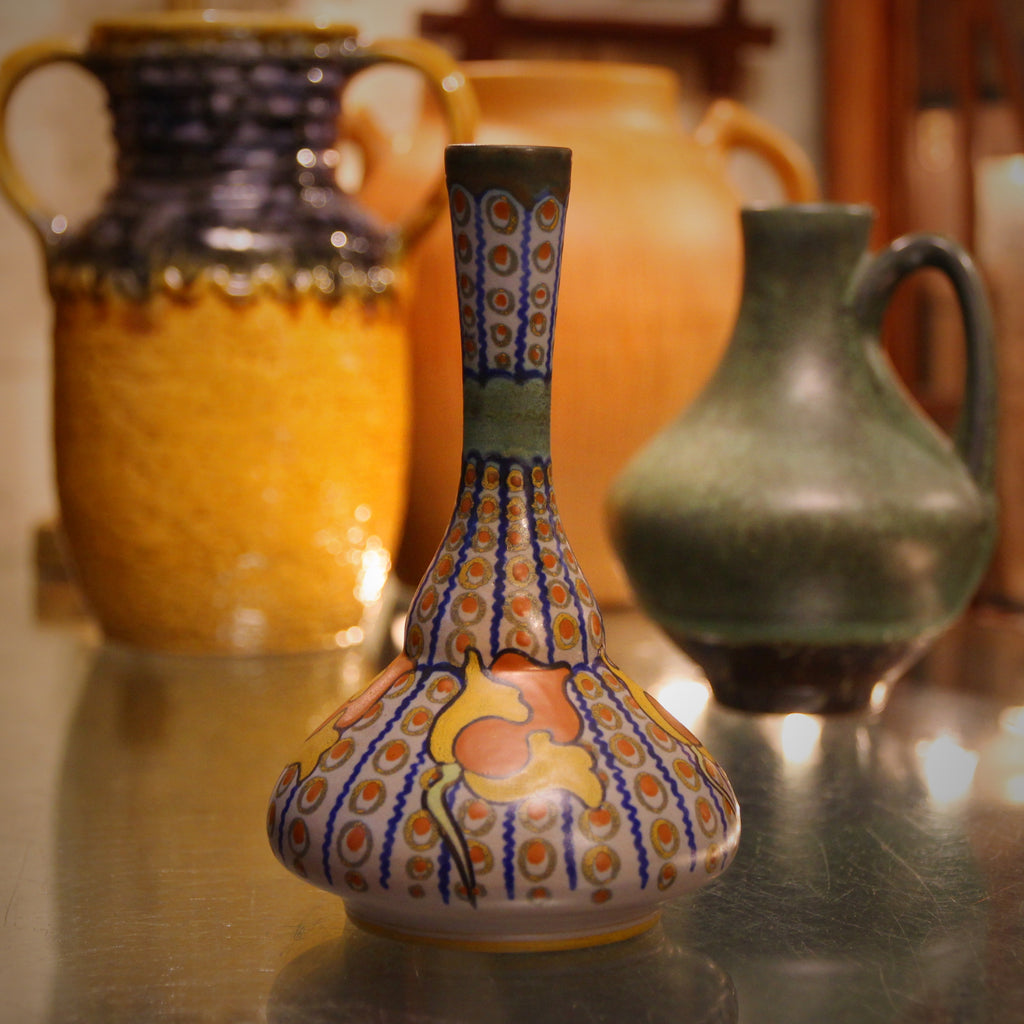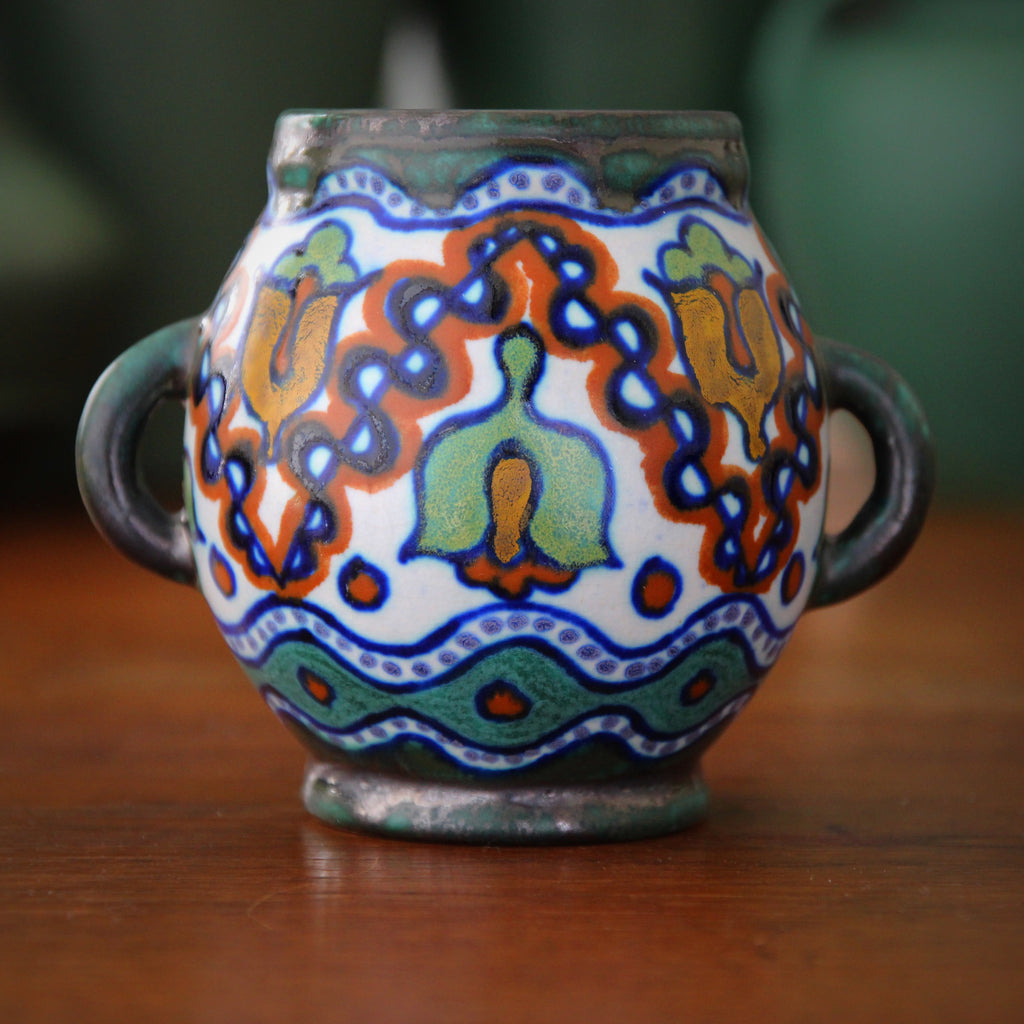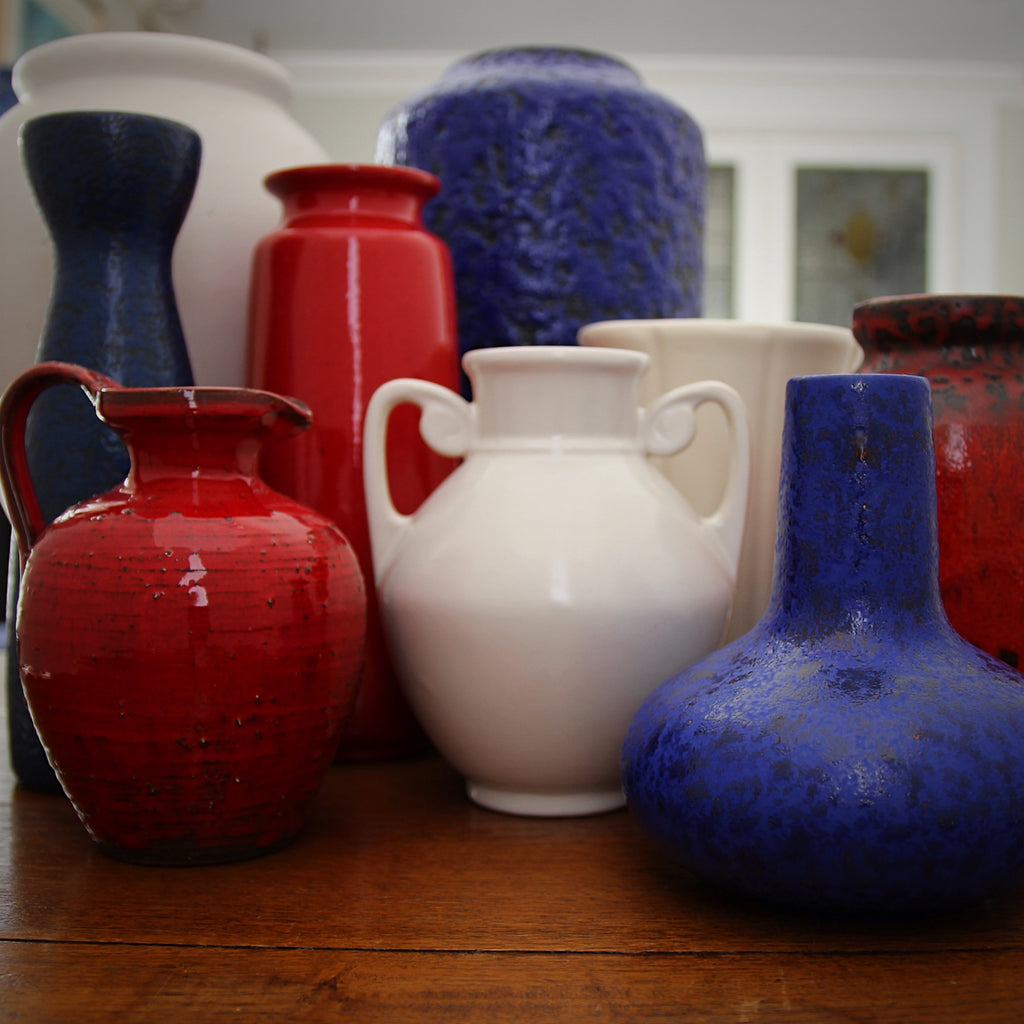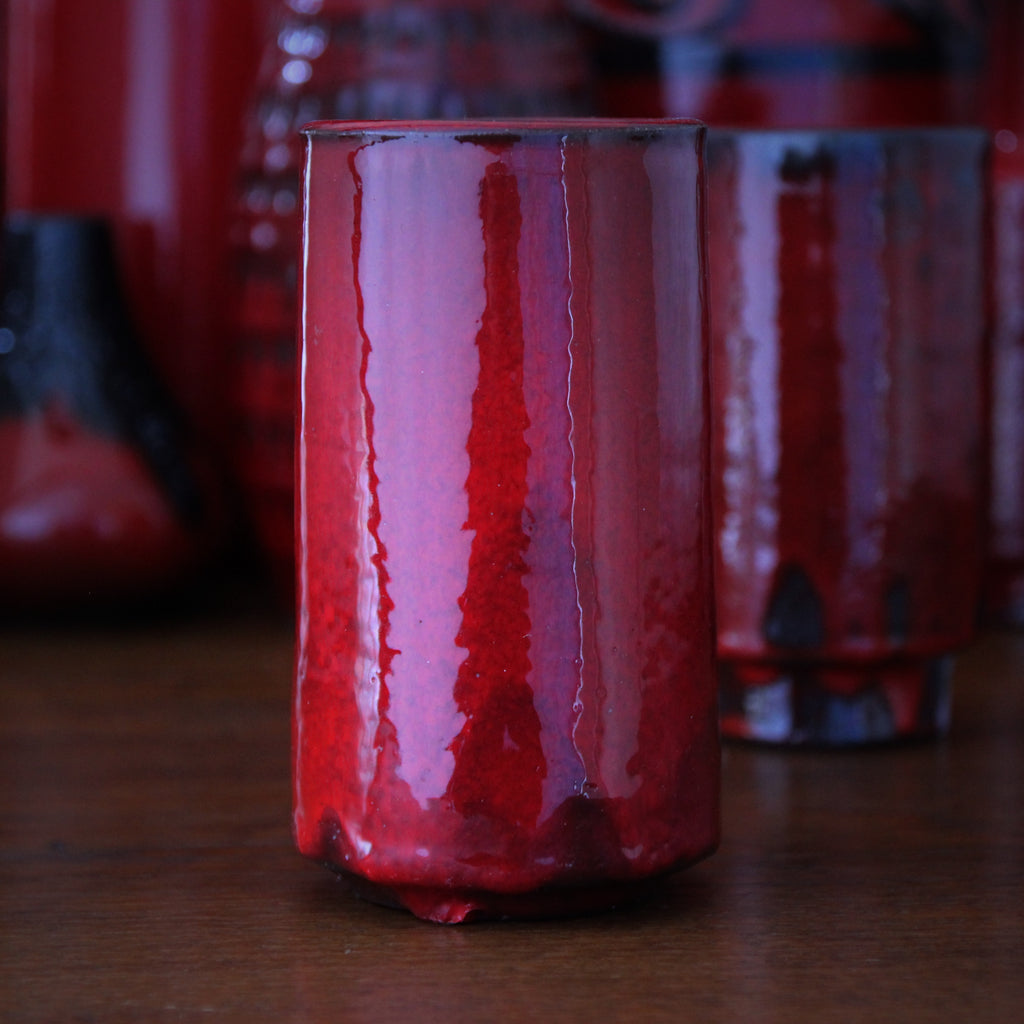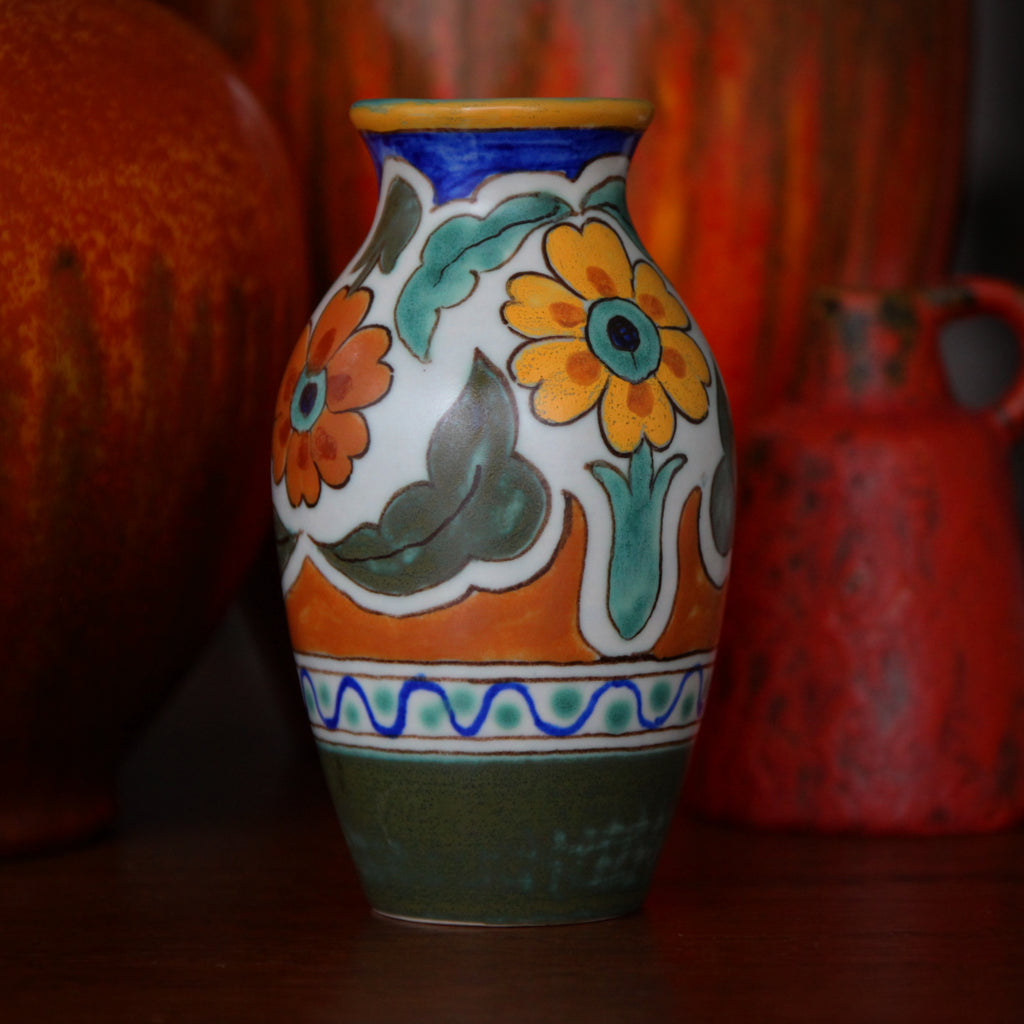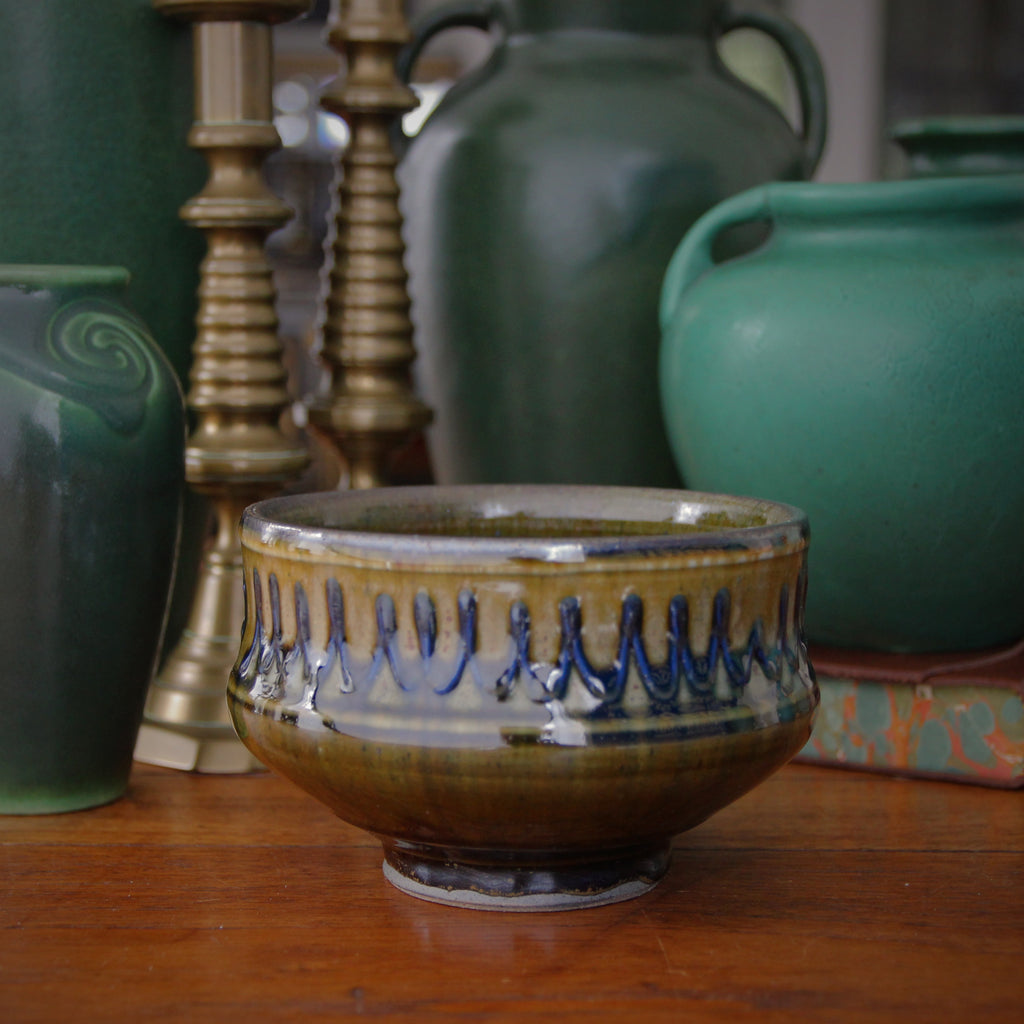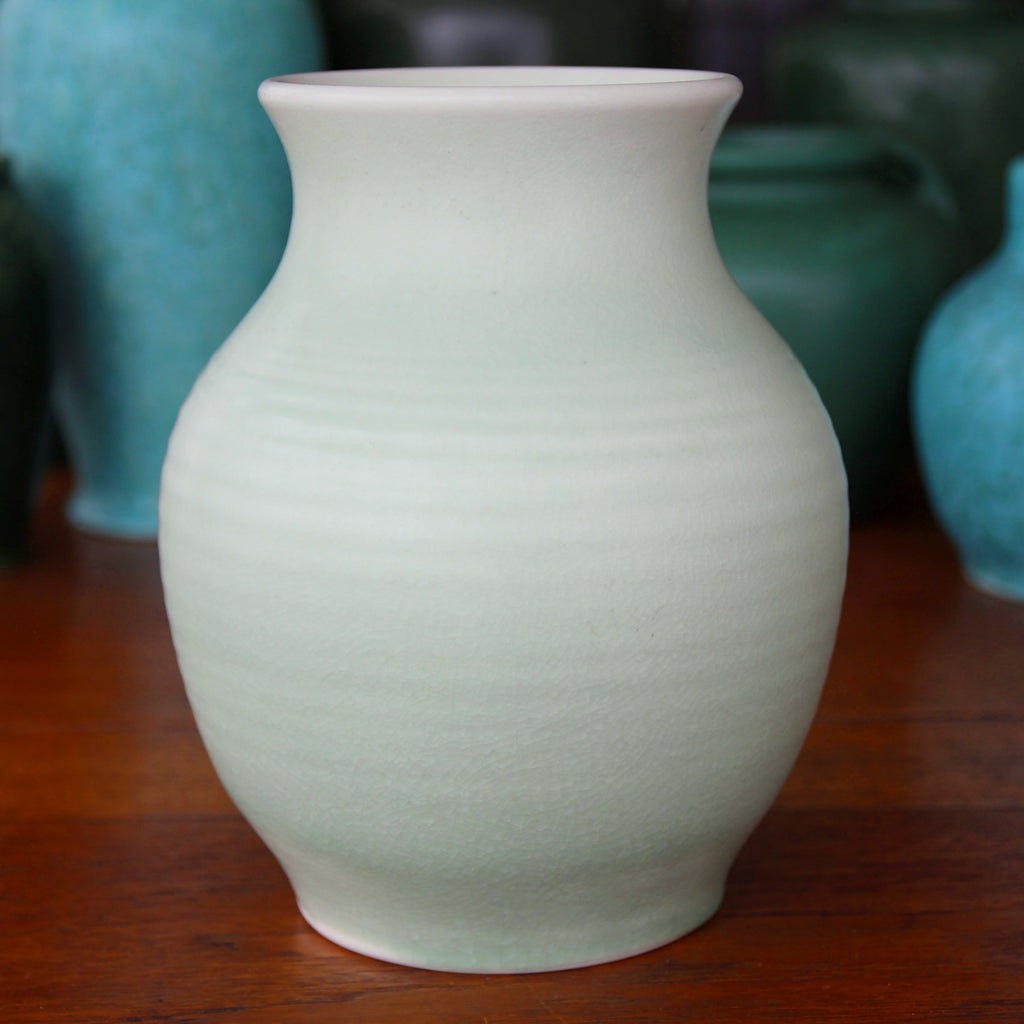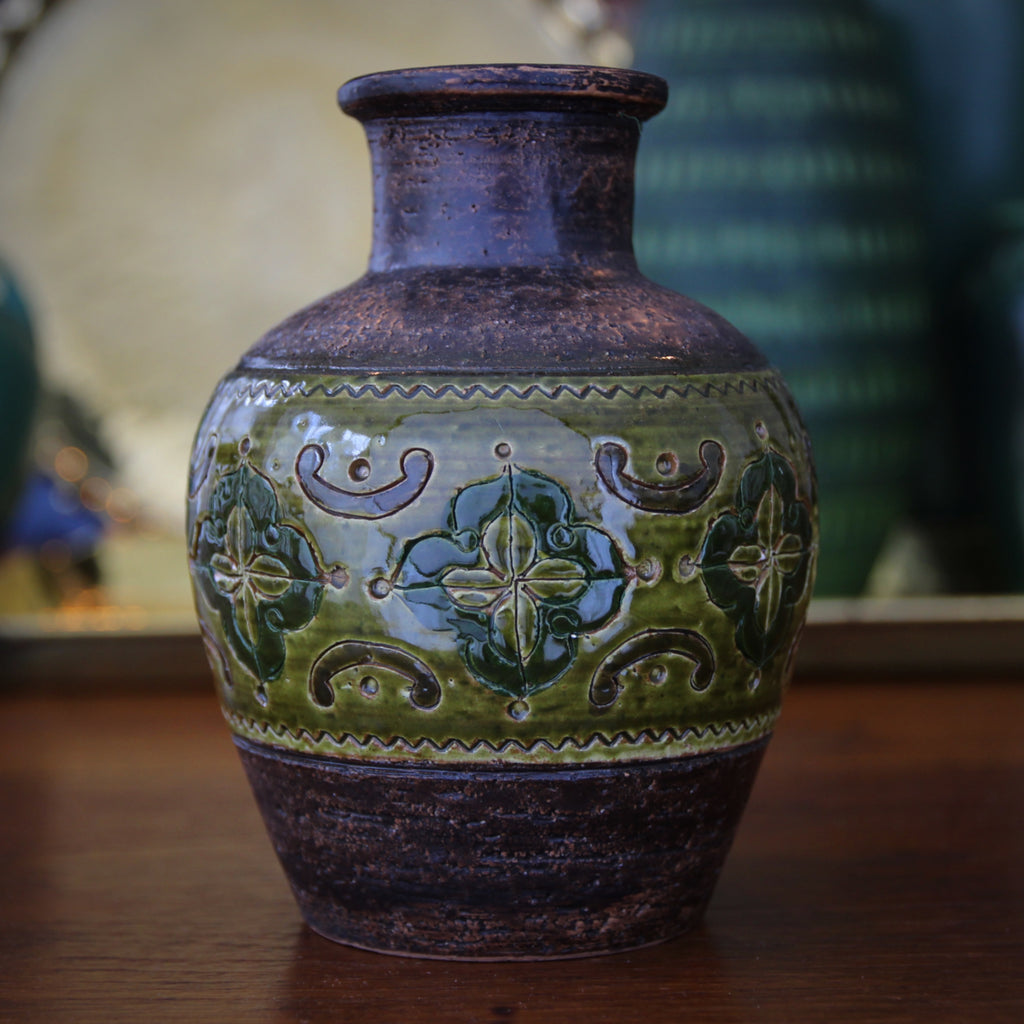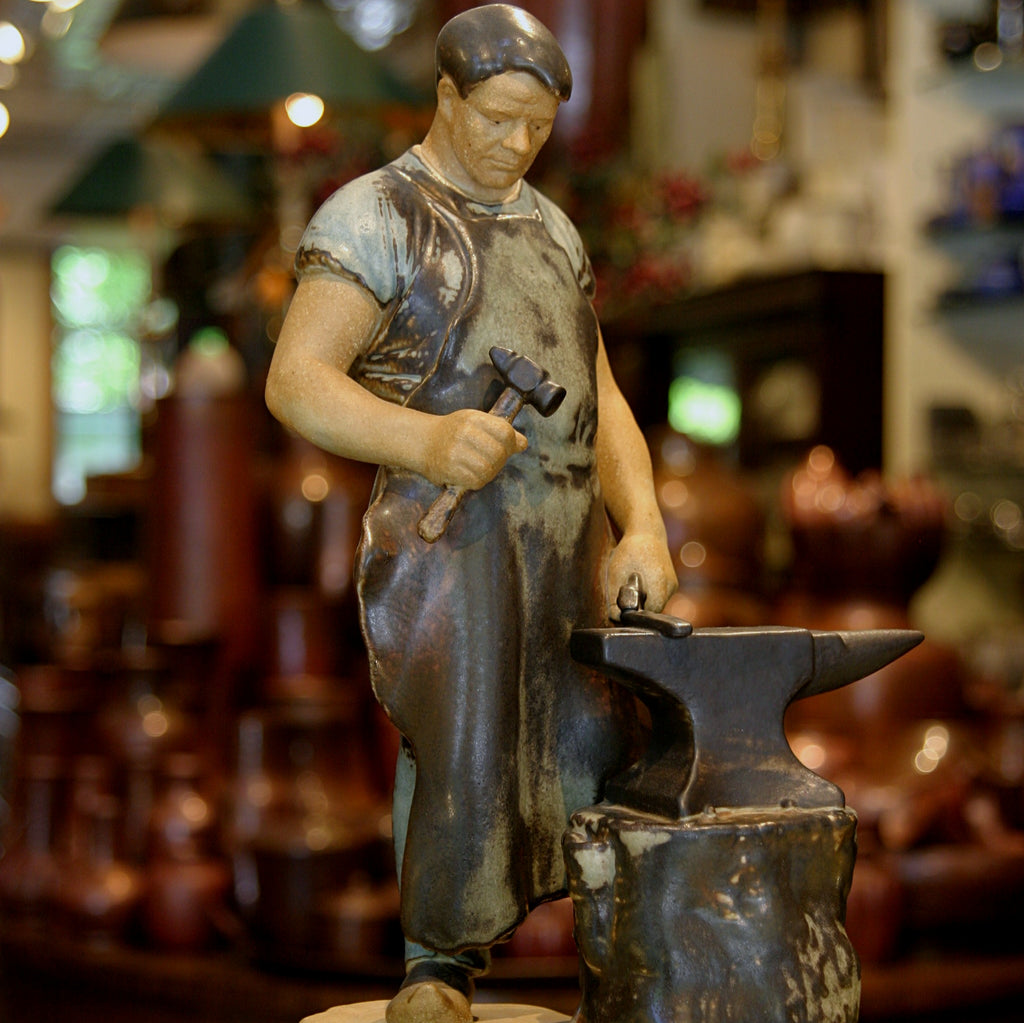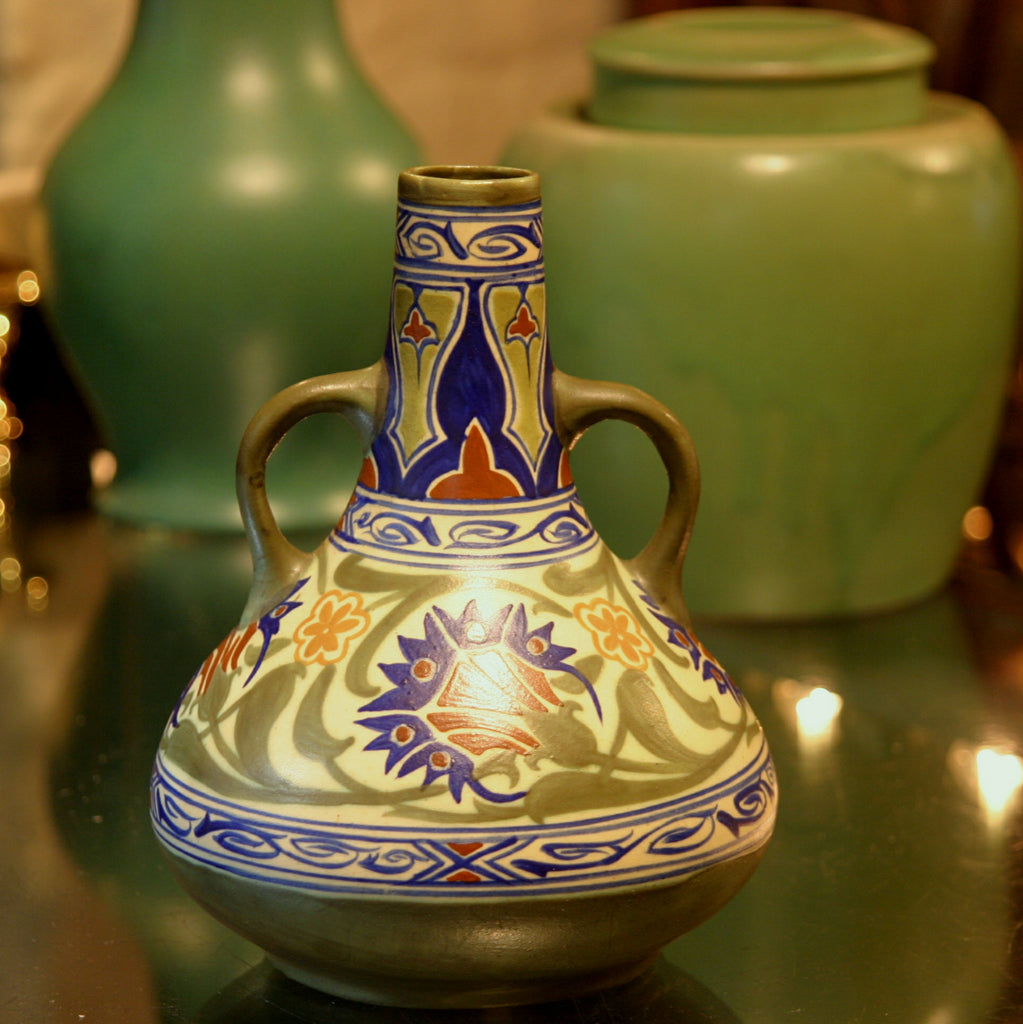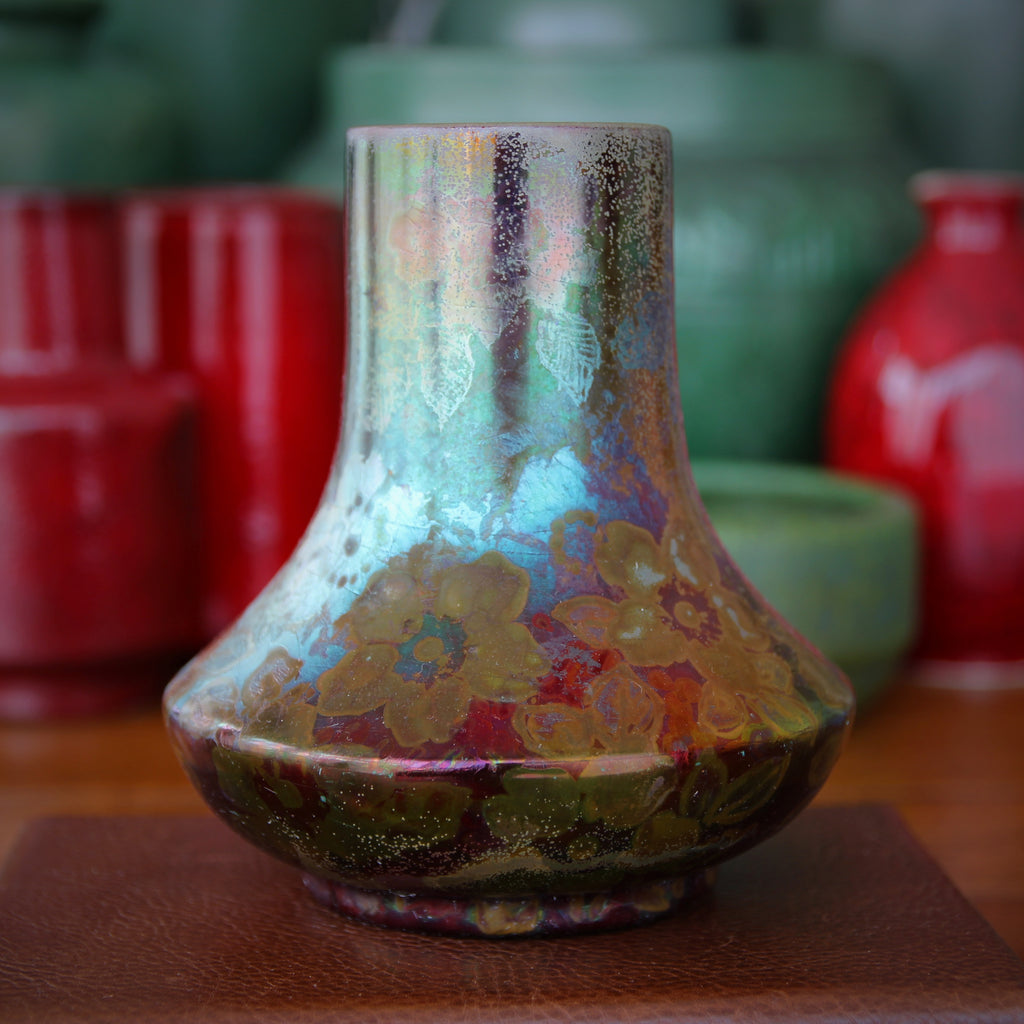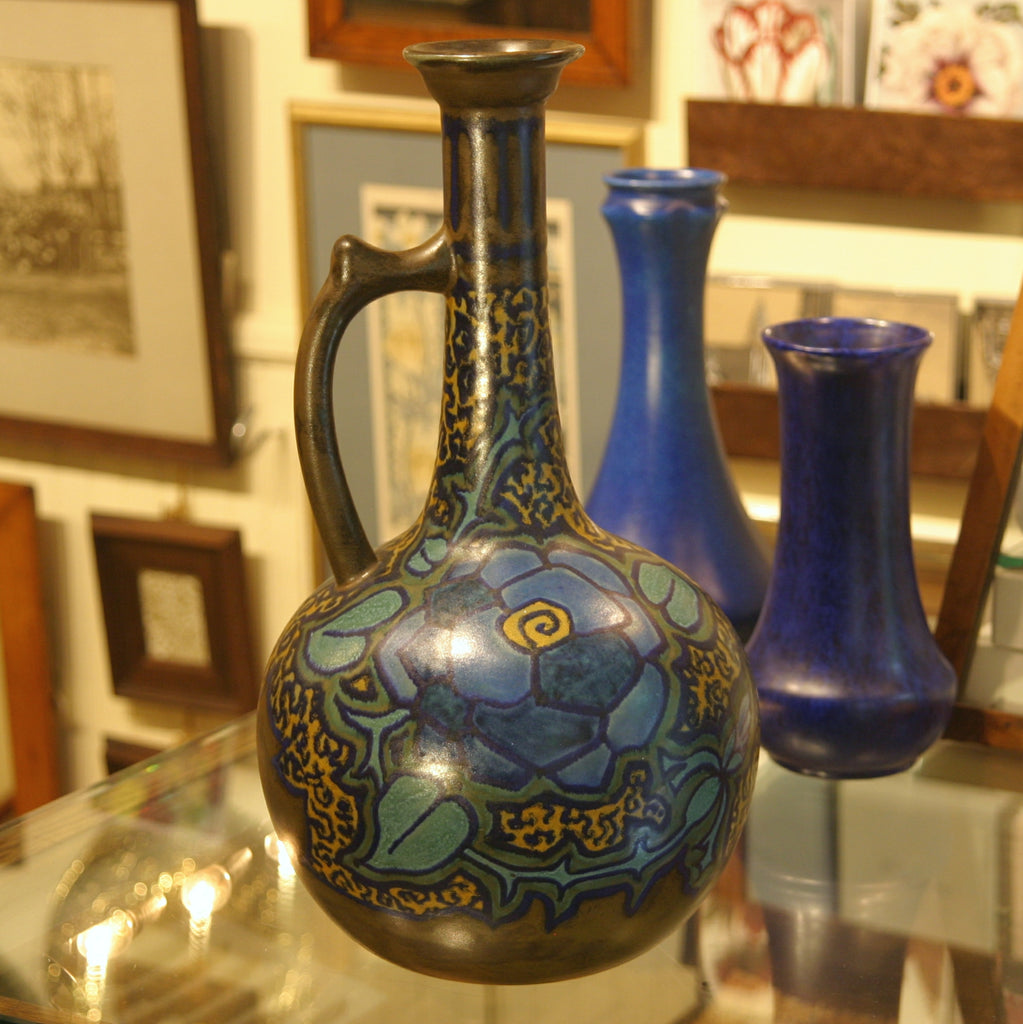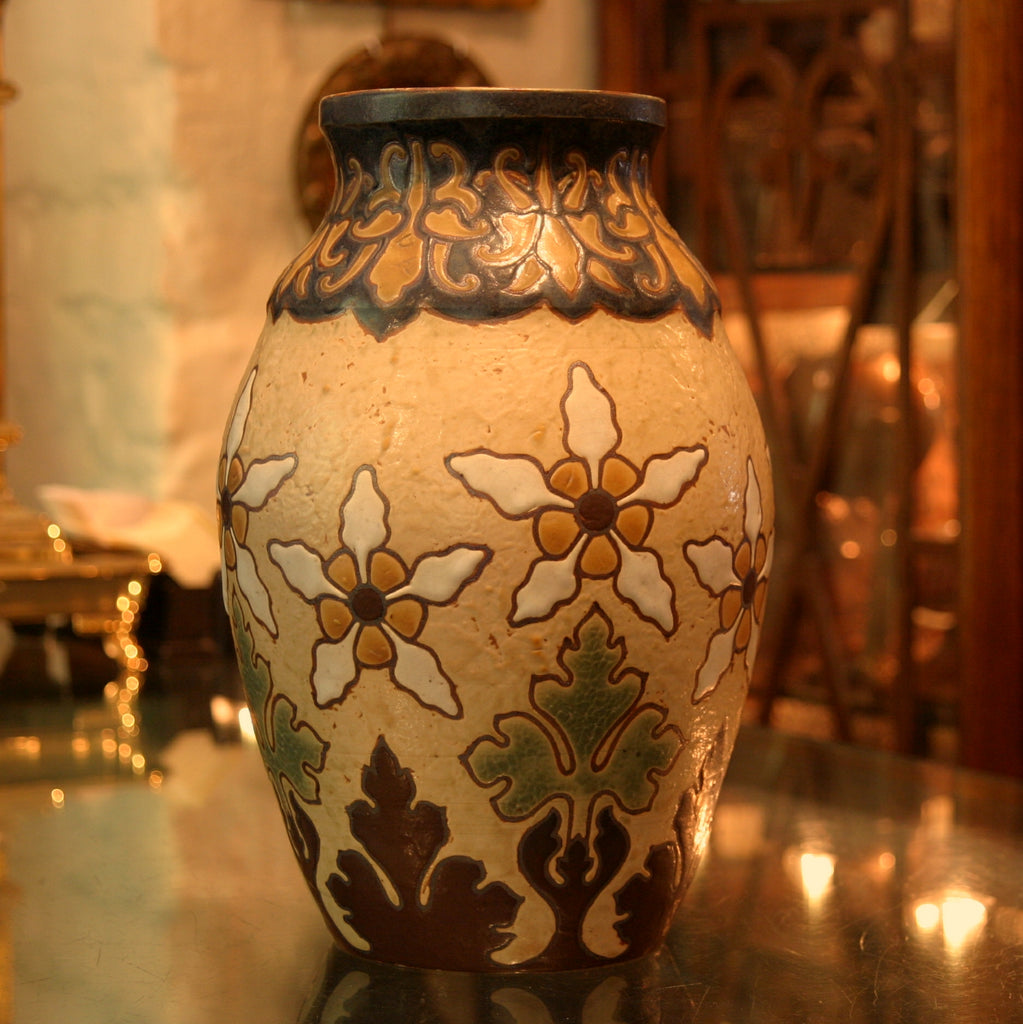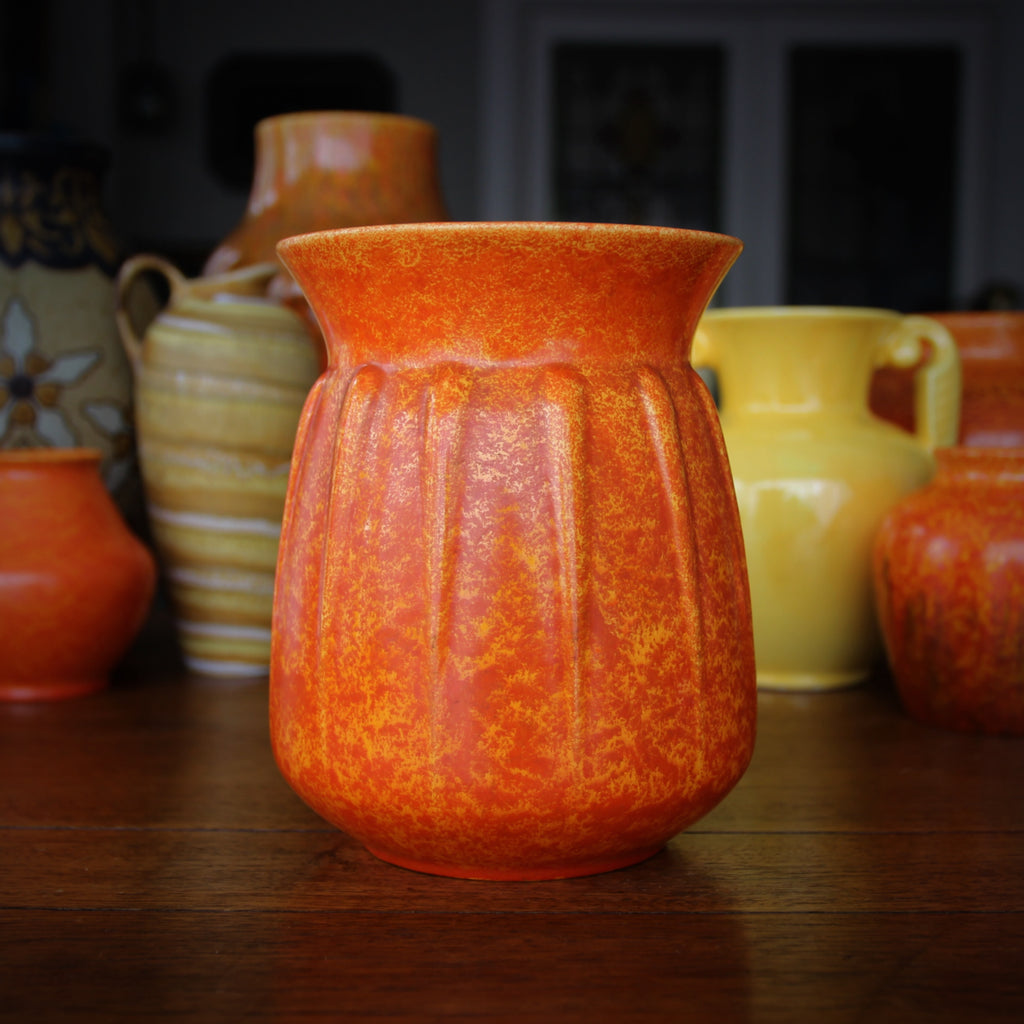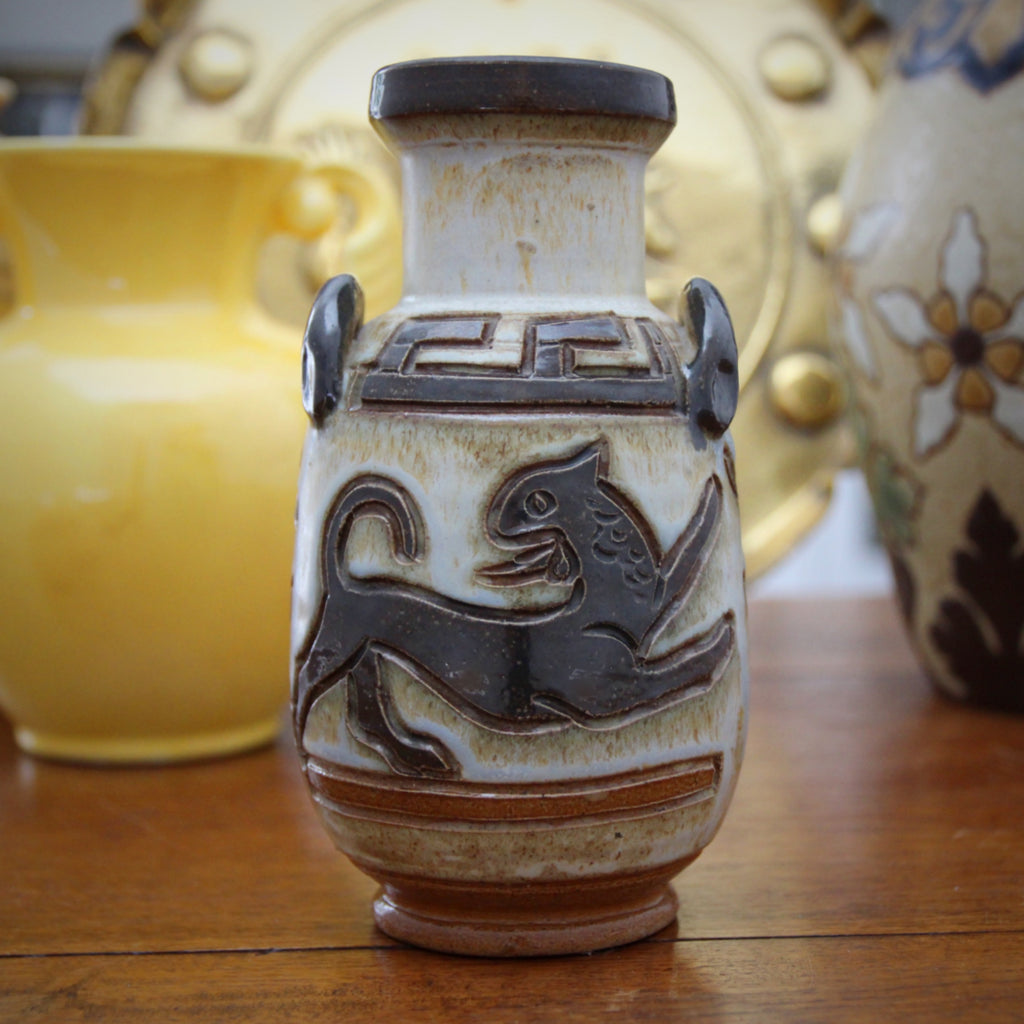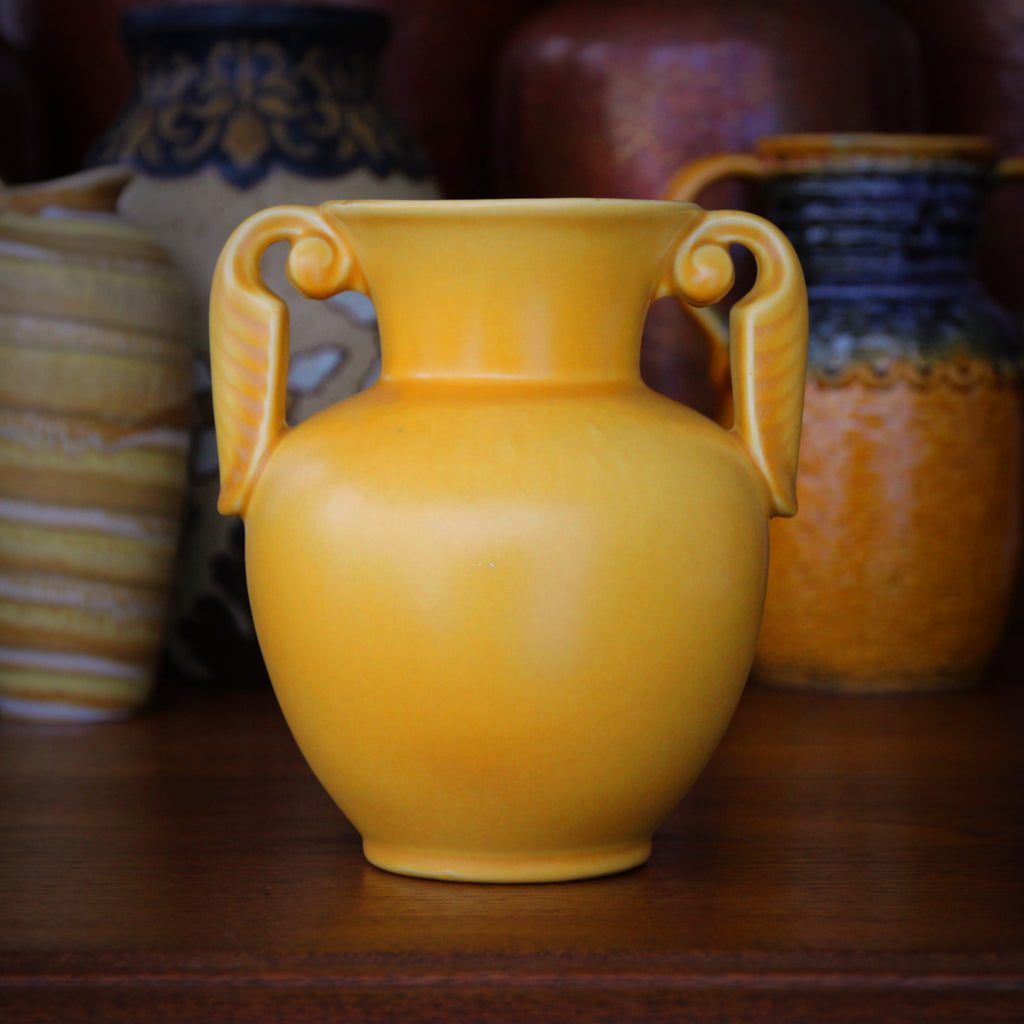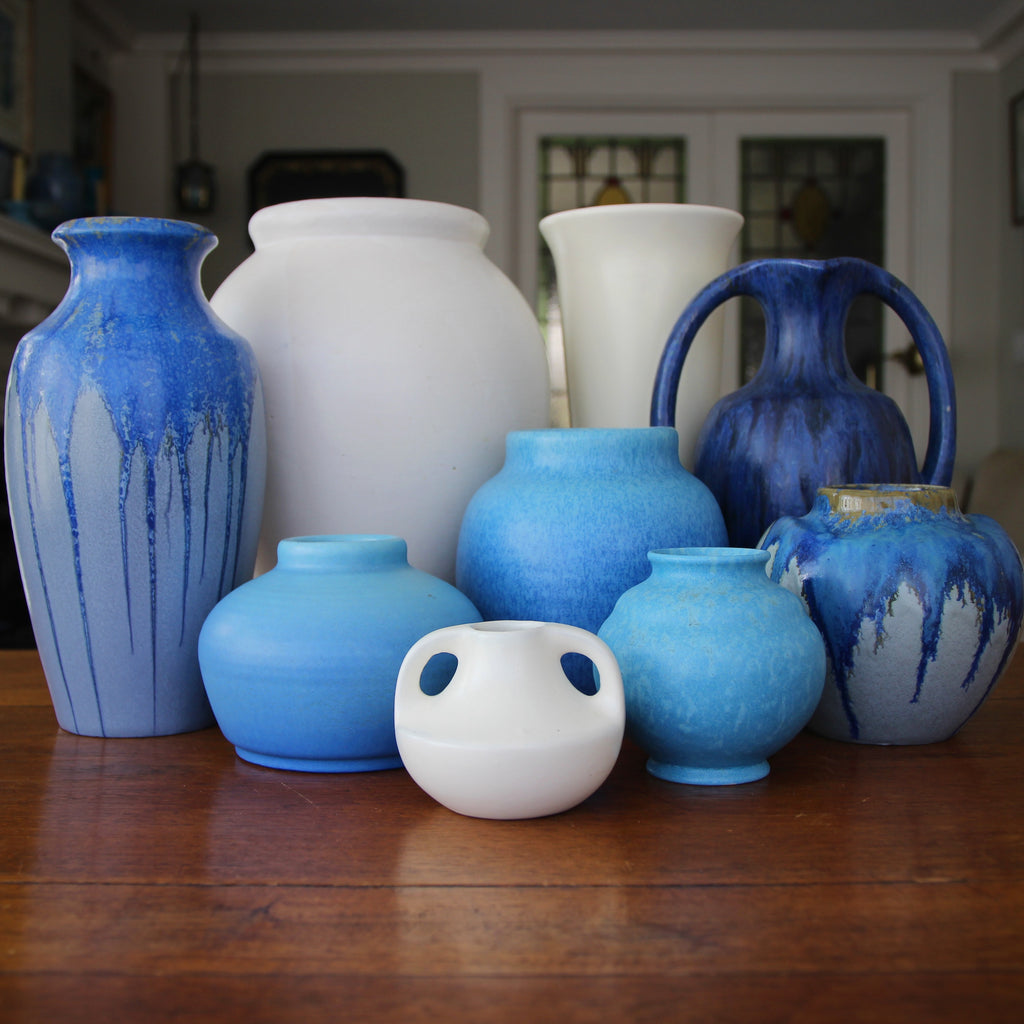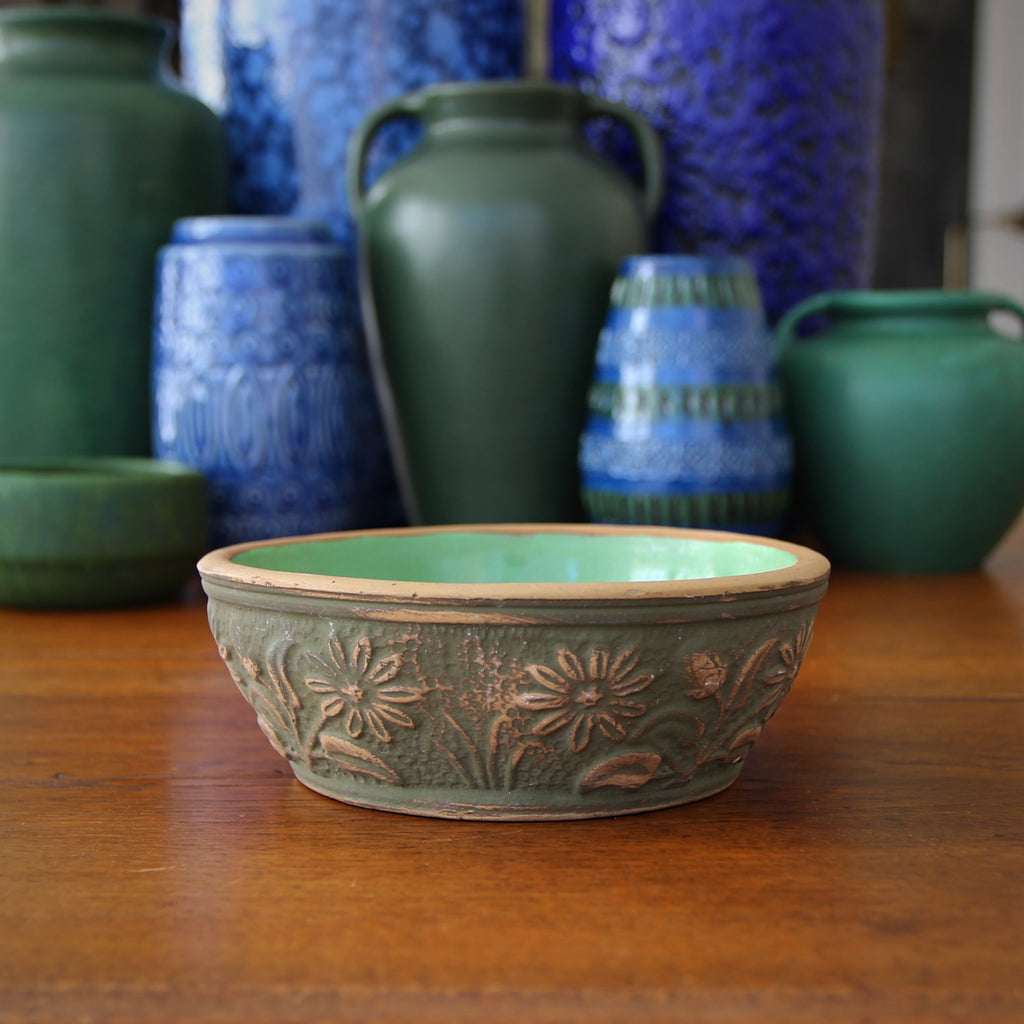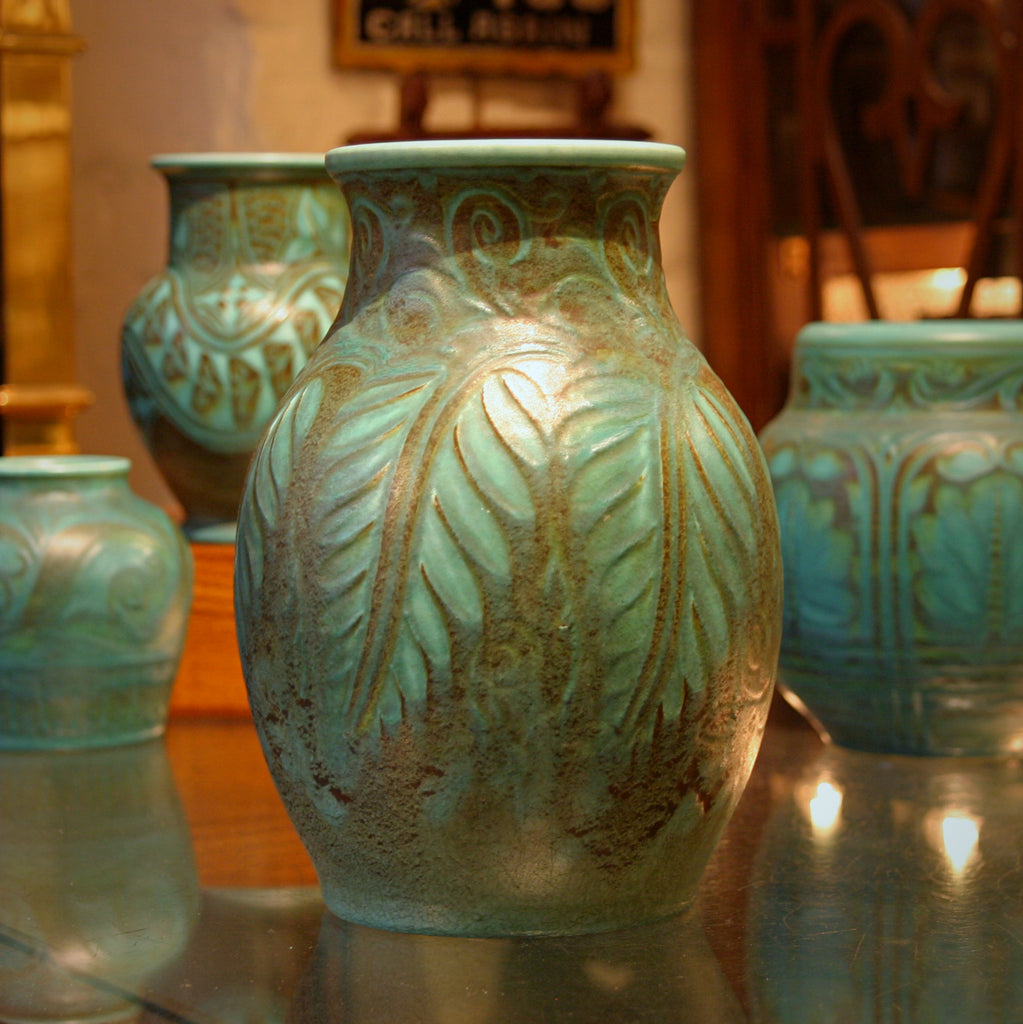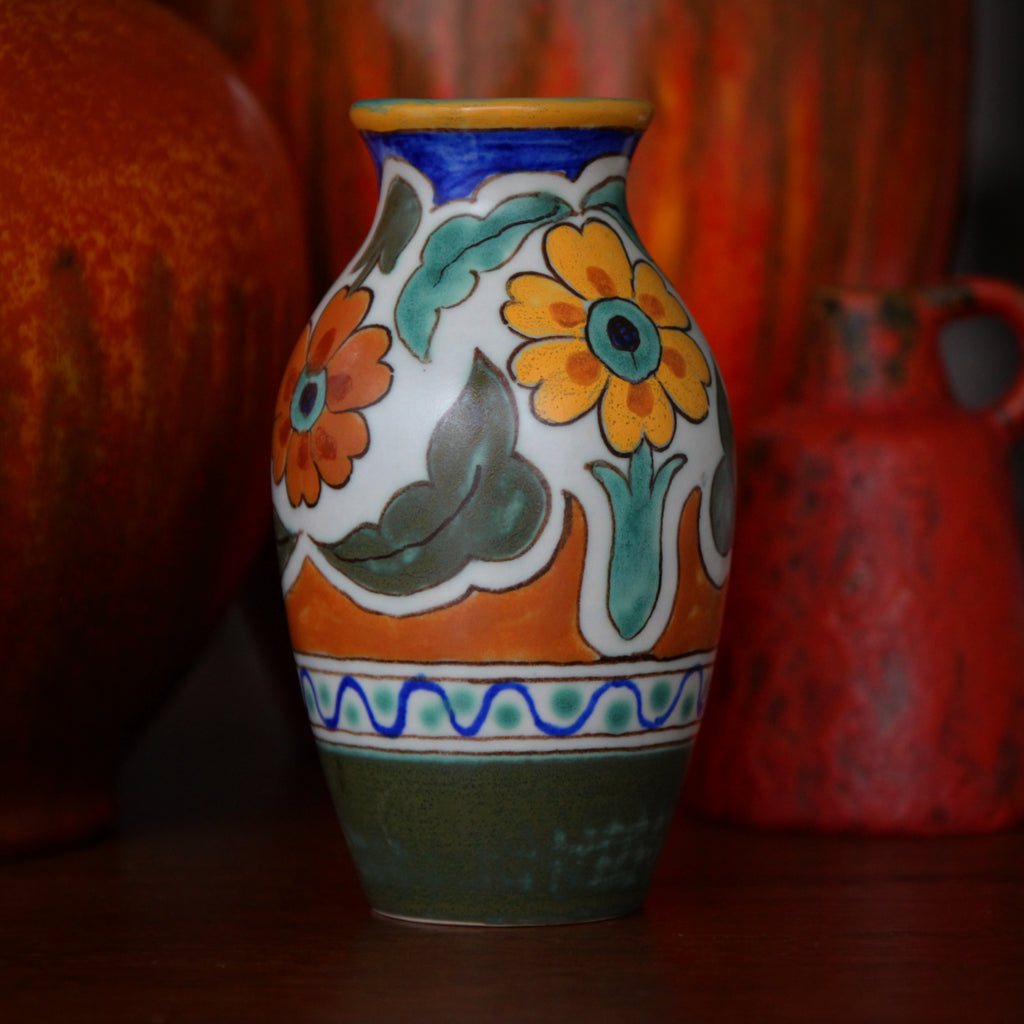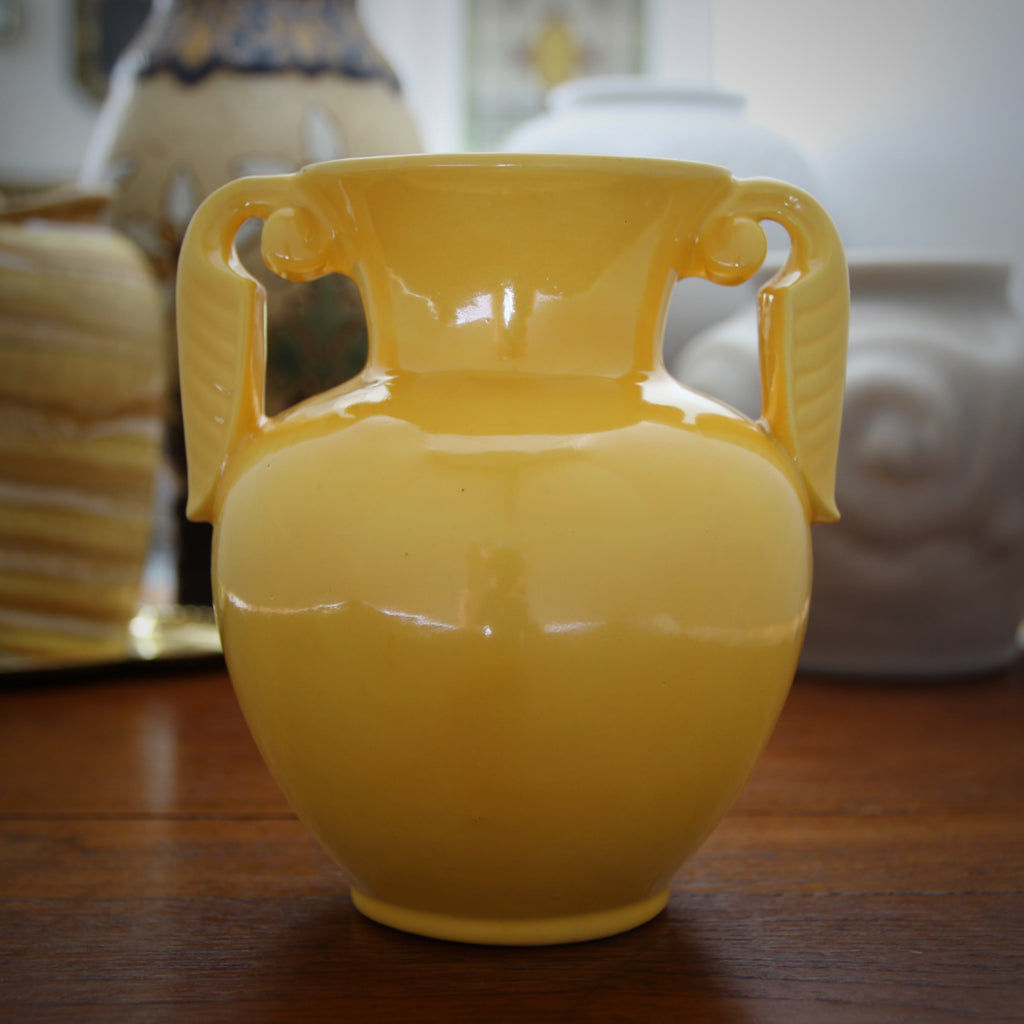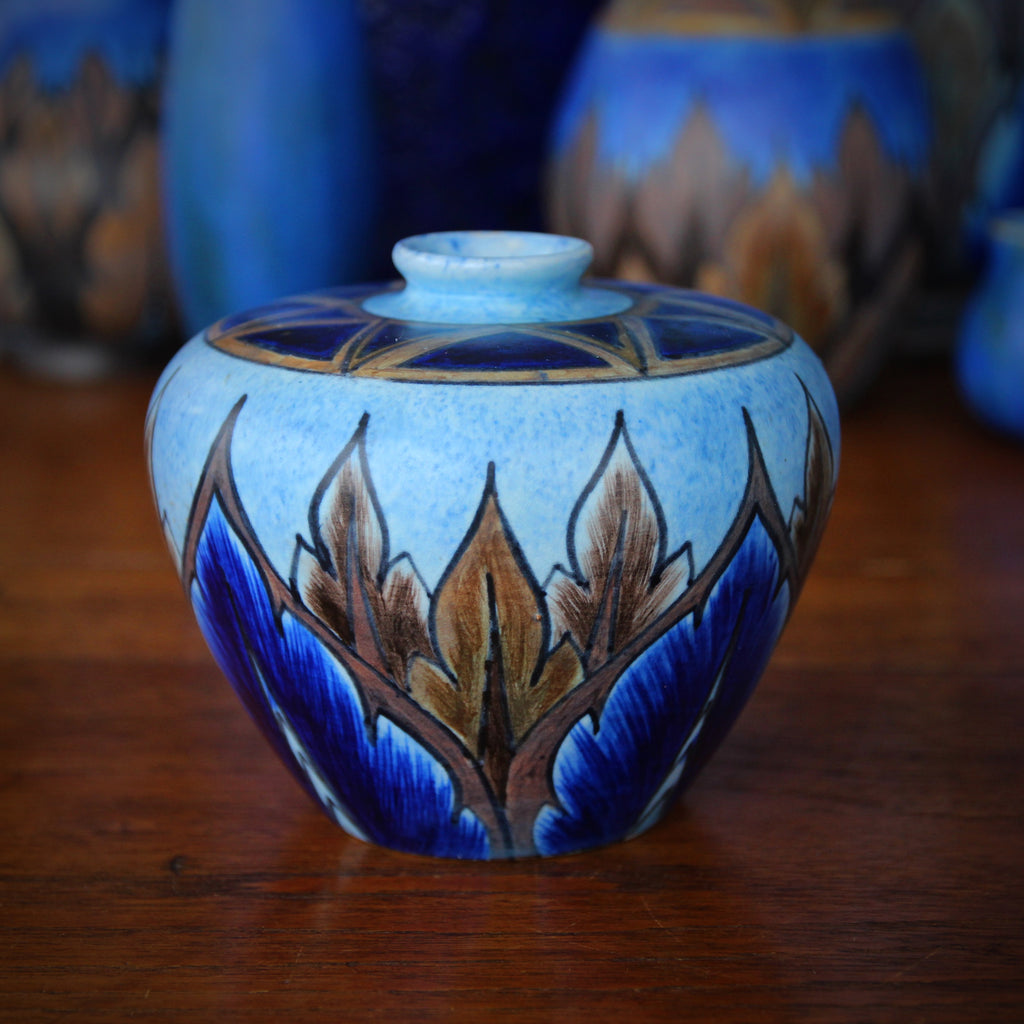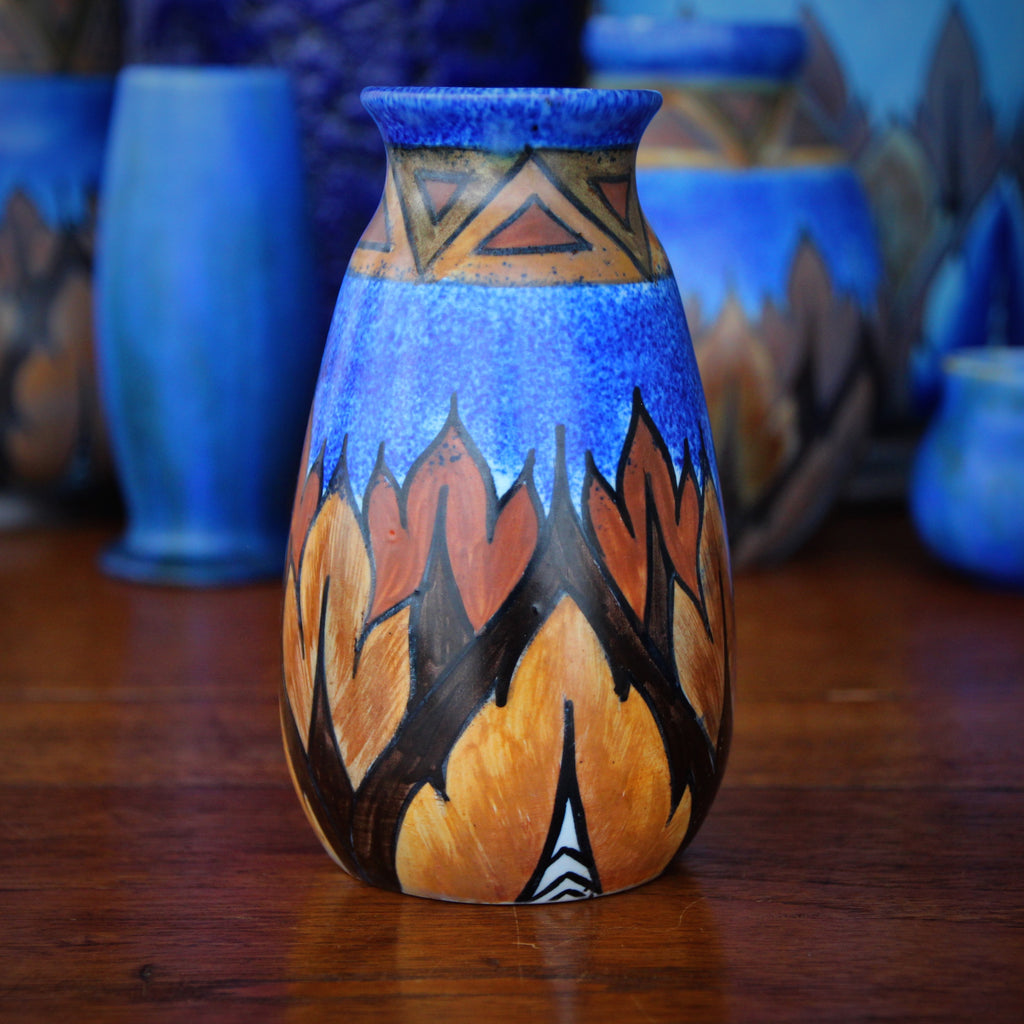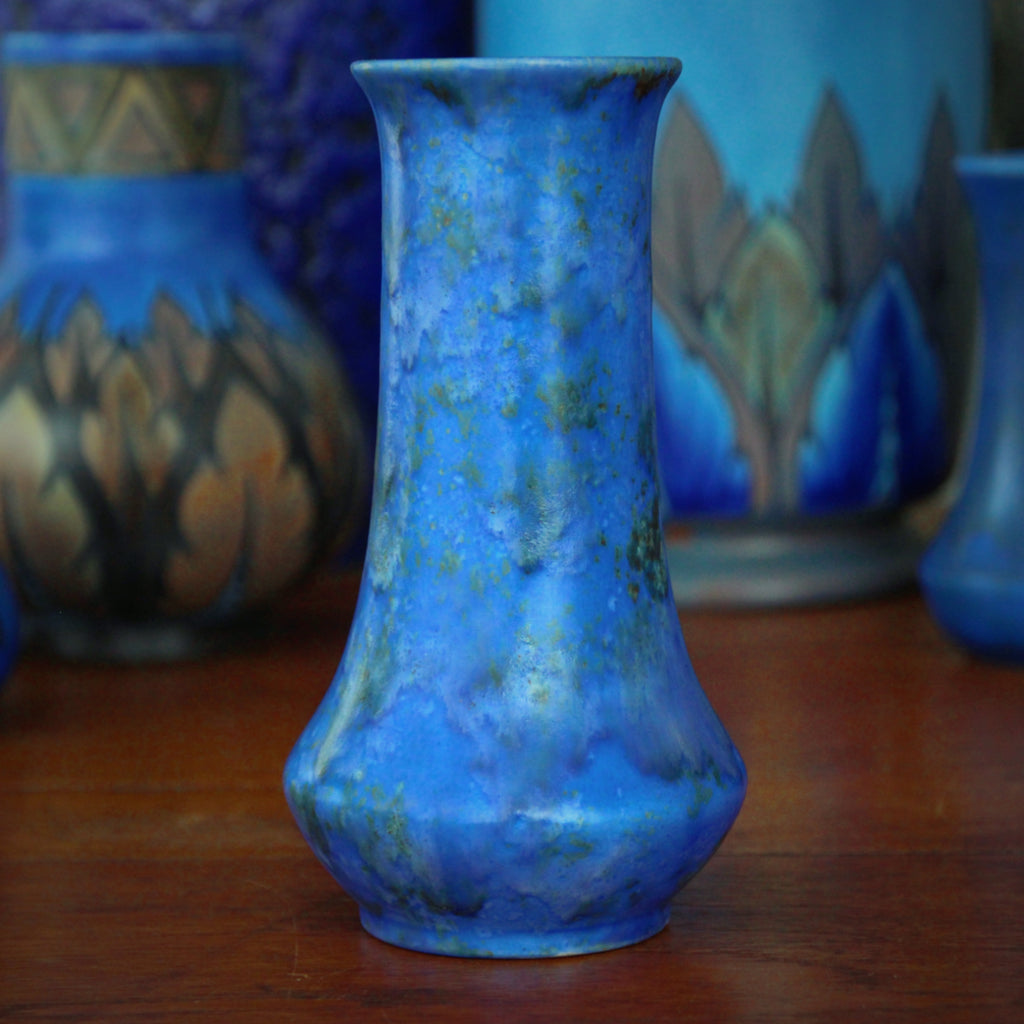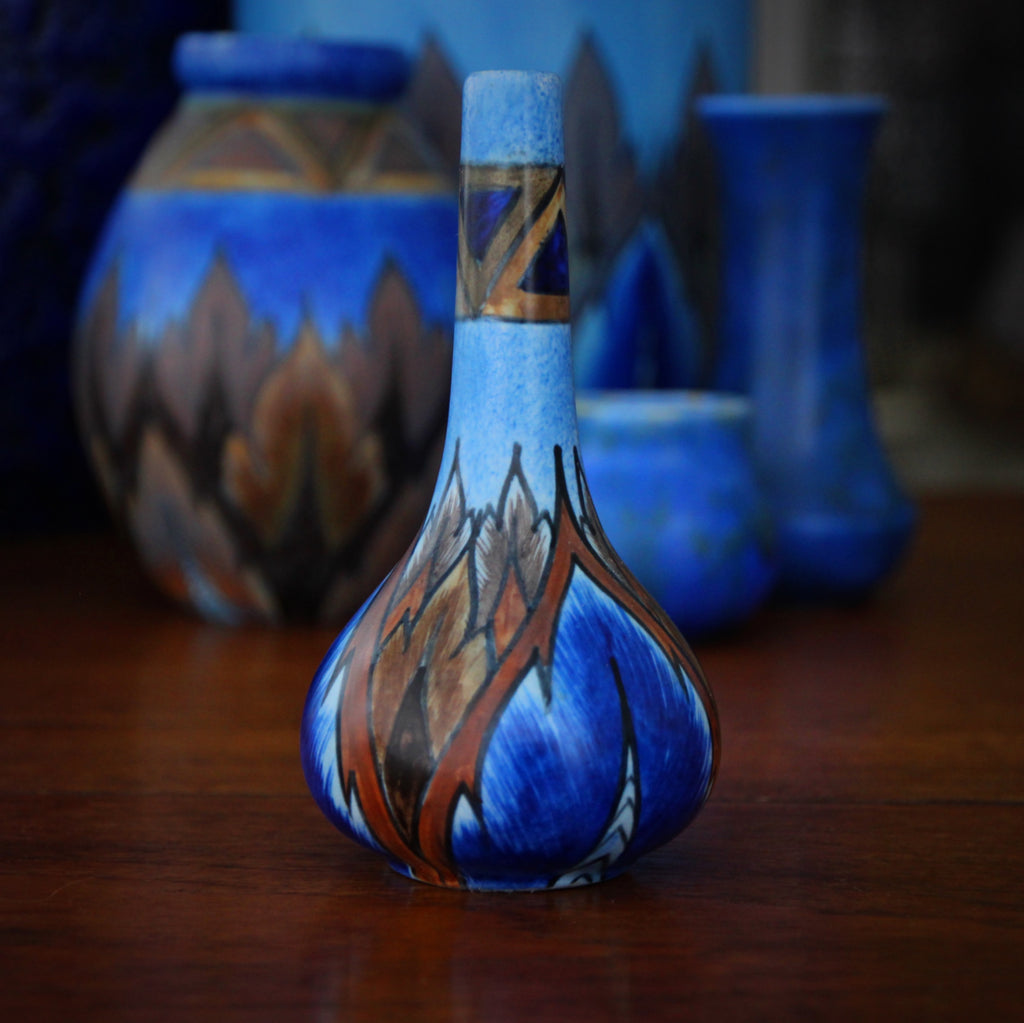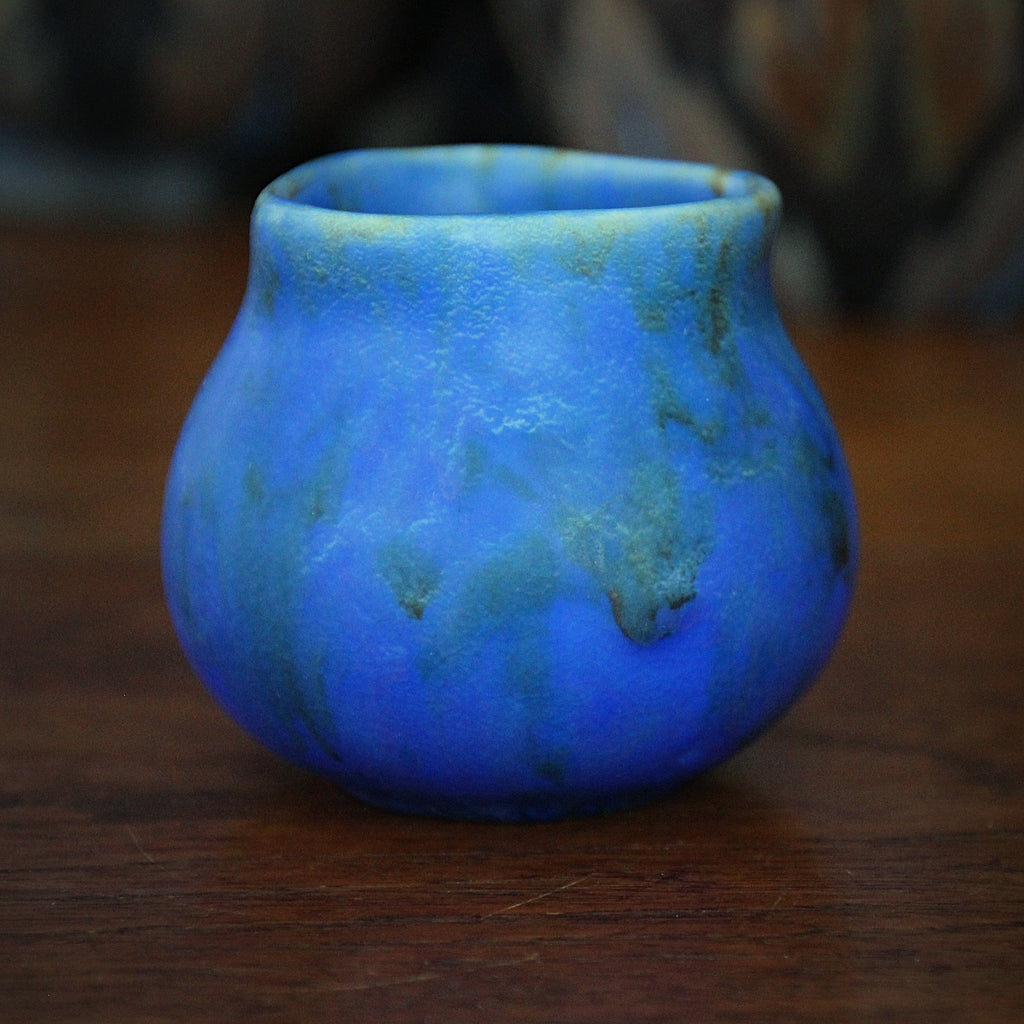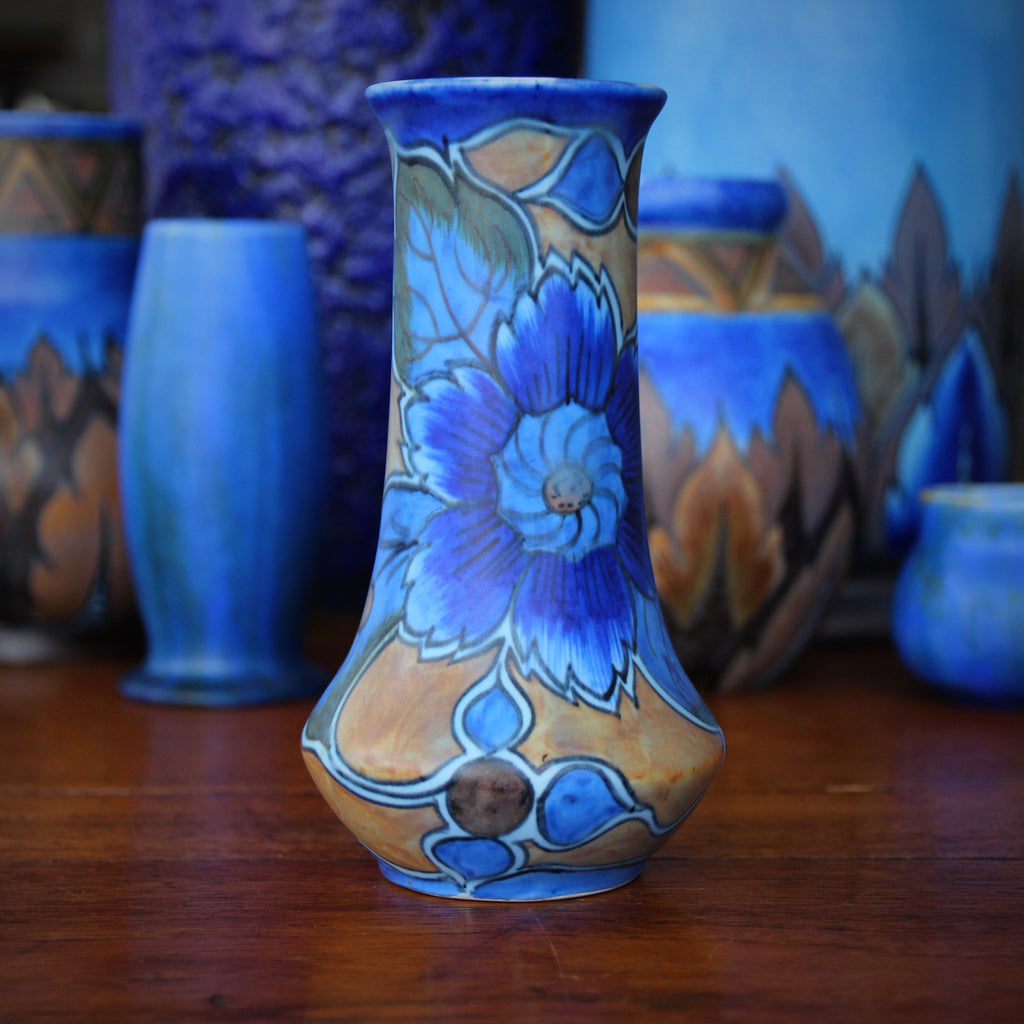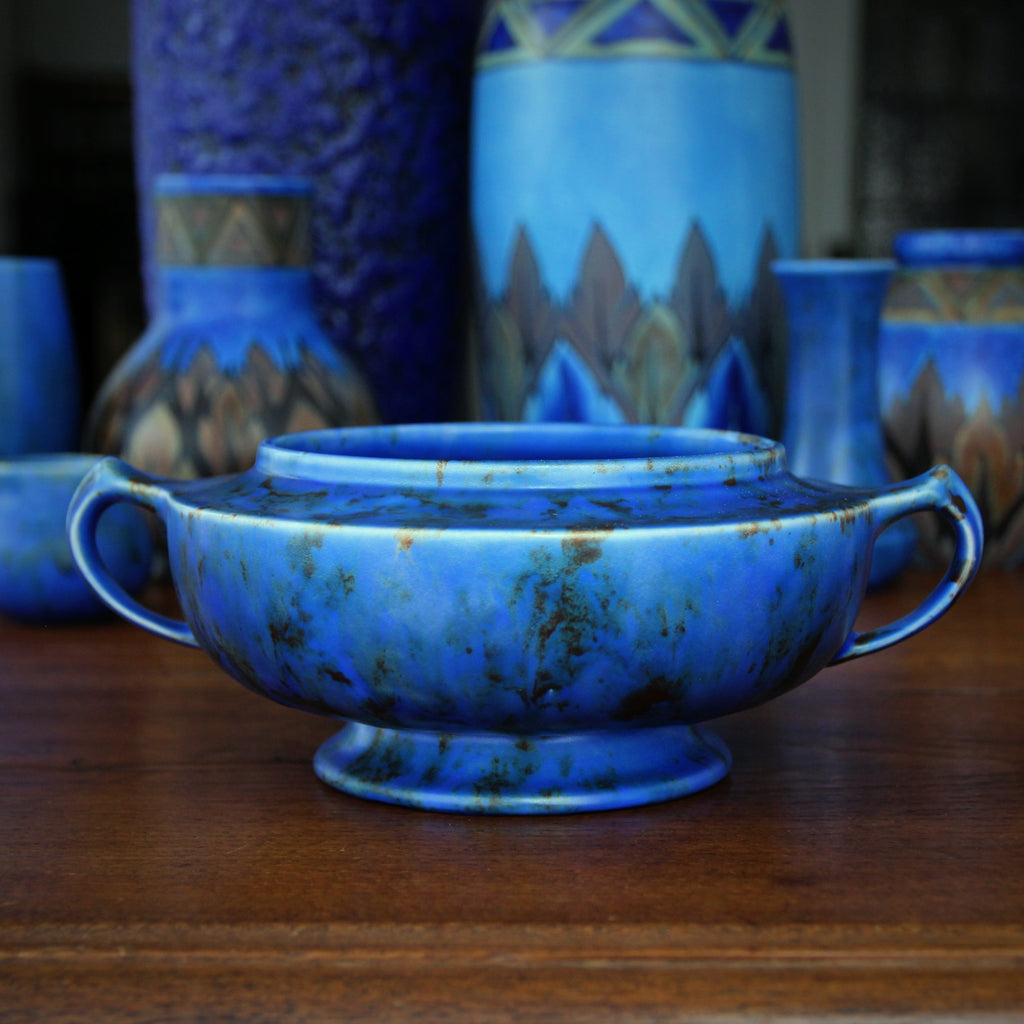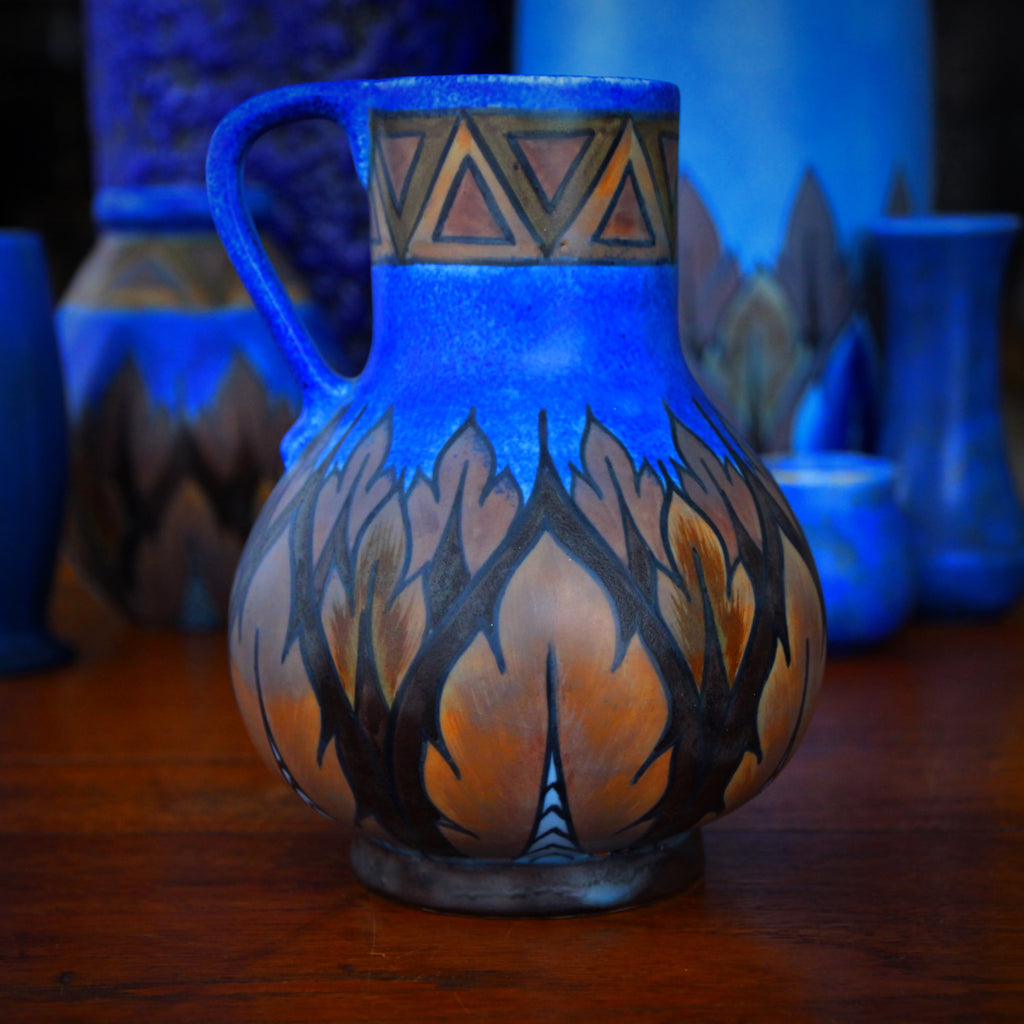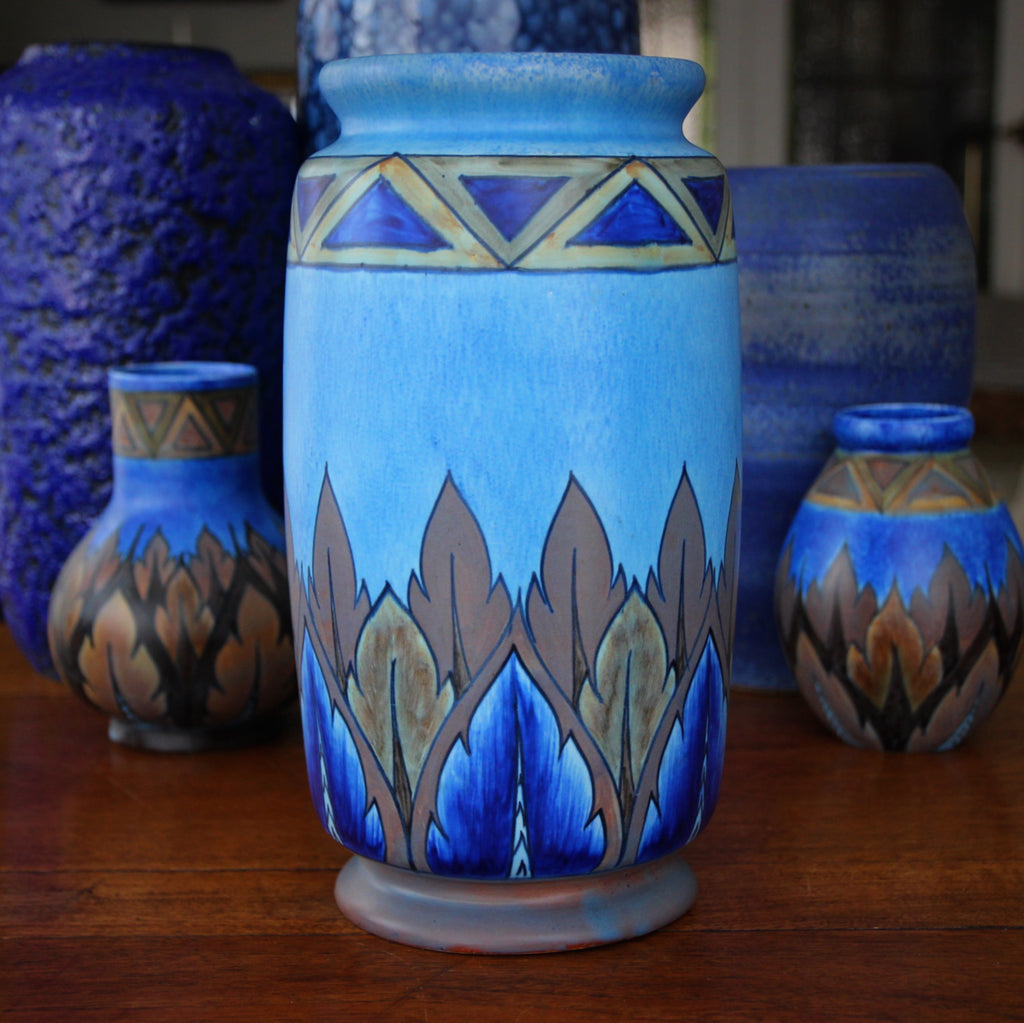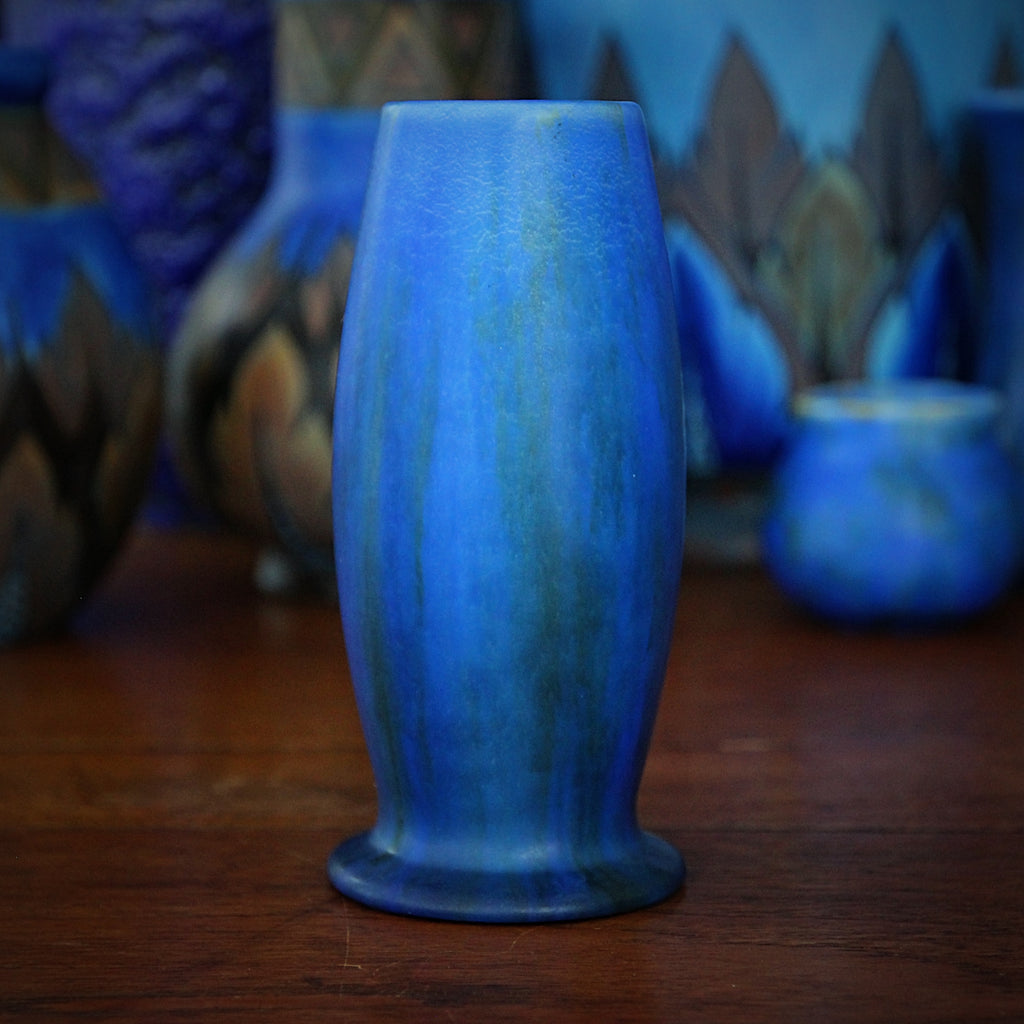JOURNAL — Art Pottery RSS
Much of the time, Art Deco styling is expressed with streamlined shapes, sharp edges and dynamic color combinations. Art Deco was Modern, Futuristic, Ready-for-the-Space-Age. Rocket ships and airplanes symbolized this fast and forceful promise. And Art Deco was wildly popular—incorporated into all manner of design, from architecture to toaster plugs.
This vocabulary of Art Deco crispness certainly was employed in British design. But, over the years, I've noticed a distinct and specific version of English Art Deco—a sub category—which is a little gentler, a little rounder, a little more subtle than its typical American sibling. In this English variety, designers "softened" the typically crisp Art Deco features.
Bretby Orientalism
In the Nineteenth Century, imported Chinese ceramics were all the rage in Europe (especially England). But these costly treasures were beyond the reach of all but the wealthiest collectors. British ceramics workshops began to make goods "in the Oriental style," for the domestic market. Rarely were these pieces authentic. In fact, they were usually over-the-top. And they almost never reached the quality of true Chinese ceramics in form, glaze or handcraft. But they did allow customers of modest means to acquire a small dash of far-away style—a taste of someplace exotic, on the other side of the world, which they could never enjoy visiting in-person.
Poole Pottery
The town of Poole, in the county of Dorset, lies along the Southern seacoast of England. In 1873, Jesse Carter purchased an existing "tile manufactory" along the quay (British English for "dock" or "pier"). Around the Turn-of-the-Twentieth-Century, the workshop started making art pottery wares in the Art Nouveau style. After WWI, Poole (still called Carter, Stabler & Adams) embraced jazz-age Art Deco. Around this time, Poole also formed a creative alliance with members of the Bloomsbury Group including Duncan Grant, Roger Fry and Vanessa Bell (Virginia Woolf's sister). Designs evolved into Post-War Modernism after WWII. During all this time, the factory continued to make ceramic tiles. In fact, Poole supplied much of the ceramic tiling for London Tube stations in...
Edward Thomas Radford
British ceramicist Edward Thomas Radford (born 1860) was a master of wheel-thrown pottery. He began his career at Wedgwood, followed by stints at Linthorpe, Burmantofts, Doulton, then back to Wedgwood. He was recruited to a new pottery company, Pilkington, in 1903 (it began making pottery in 1904) and he stayed here for the rest of his career. Radford retired in 1936 and Pilkington discontinued art pottery in 1938 (though its ceramic tile manufacturing continued). Radford was a star at Pilkington. He could throw monstrously-sized pots or the tiniest of pieces (only 1.5 inches tall). And he could throw a pot and then fashion a perfectly-fitting lid by eye (and hand) alone. Although many of the pieces at Pilkington were cast,...
China and Darwin
This vase, probably English or French, ticks a couple of Nineteenth Century boxes: Asian Style and Darwinian Intrigue. Both of these dynamics were at play in the minds of Late Nineteenth Century Europeans. First, there was the Western fascination with "Oriental" art and design—especially Asian style as embodied by Chinese ceramics (which 95% of Europeans could not afford). For a few centuries, Western traders had been crossing vast seas, buying and selling with China, Japan and Southeast Asia. Chinese ceramics were an important (and valuable) part of this trading mix. The Chinese had mastered ceramics production techniques which blew the minds of the Europeans (this despite their fairly primitive kilns and other equipment). Red glazes (including oxblood, as shown in...
March, On!
Welcome, March, and your flower, the glorious Daffodil.
Is there any flower more hopeful, more optimistic, than the daffodil? It emerges during the chilly bleakness of winter—a sunny, bright, resilient reminder of beautiful days to come. Quite often, it is the only spot of color in an otherwise grey landscape. And what a color it is!
The Stangl Art Deco vase, shown above, is dressed in a saturated daffodil yellow glaze. The vase's form is inspired by a Classical Greek or Roman urn, embellished with a pair of foliate handles—which honor both the ancient aesthetic and the modernism of the Art Deco. And the rich yellow color practically vibrates with sunny optimism.
Earthy Green
Green is my favorite color of pottery. The reason? Perhaps because I really love wood—boxes, furniture, paneling, cabinetry—and what looks better with wood (trees) than leaves and grass (green)? I find the color green (at least most shades) calming, centering. Green relaxes me. It's the color of nature herself. And the deeper the green, the more I like it.
The Übelacker West German Modernist jug, shown above, is a home run! The earthy, green glaze, for starters, is deep, deep, deep—and just this side of muddy (without being drab). Plus, the glaze is a matte finish—another few points in its favor.
Soviet-Cute
In nature, some of the cutest and cuddliest creatures can grow-up to become most fearsome—and dangerous. This Soviet porcelain bear cub might just be one such critter. The sculpture was made in the Sixties or Seventies in the Soviet Union. The symbol of the Russian Bear is an old one—at least from the 1500's. In the West, the symbolism is sometimes interpreted disparagingly: bears can be hulking, awkward and savage. Unpredictable and dangerous. But in Russia (and the Soviet Union before that), the bear has been a symbol of national pride: strength, fortitude, power. The earliest recorded use of the symbol is in Shakespeare's Macbeth (who says to the ghost, "What man dare, I dare. Approach thou like the rugged Russian...
James Plant Ceramics - Part II
A few weeks ago, a British (Dutch-born) ceramics collector contacted me about my James Plant ceramics offerings, which he had seen on-line. He is writing a book on the influence of Gouda (Dutch) pottery on English ceramics design. James Plant's "Orientalist" wares—while they certainly have their own distinctive aesthetic—do share a similarity with Gouda's hand-painted pieces. He asked for more photos of my pieces and my permission to use my photos in his forthcoming book. I was happy to help—and happy to have acquired new-found motivation to re-shoot the photos of the two pieces (which had never been well-lit in their original photos).
James Plant Ceramics - Part I
The history of James Plant & Sons English ceramics is, shall we say, "contested." Although the vase designs and decoration are firmly rooted in the 19th Century—Christopher Dresser-inspired shapes, hand-painted "Persian Orientalist" decoration, and an 1890's Aesthetic Movement attitude—certain English collectors contend that such wares were created during World War I, when Liberty of London sought to find a replacement source for Gouda-type (Dutch) ceramics (which could no longer be imported, due to the war).
Here's what we do know about James Plant & Sons. There are records of multiple "James Plants" working in and around Hanley, England—the heart of "The Potteries," Stoke-on-Trent, Staffordshire.
At Swim-Three-Fish
A most handsome vase has "swum" our way: an English Art Deco beauty by Pilkington Royal Lancastrian. A repeating pattern—three carp-like species riding atop scrolling waves—is incised upon the body of the vase. A mottled orange and yellow "uranium" glaze pops against an earthy "kelp brown" background. This vase was made in the Twenties or Thirties, just outside of Manchester, England. It has enough presence to hold-its-own as a statement piece. And yet, I must admit, it does look good featured against a collection of other Royal Lancastrian pieces.
Peregrine Power
The Peregrine Falcon has been capturing mankind's imagination for millennia. The Ancient Egyptians depicted their sun god, Ra, as having the body of a man and the head of the peregrine. And, for at least 3,000 years, people have been practicing falconry—the sport of training domesticated falcons to capture prey and return to their master. Peregrine Falcons are superb hunters. They are eager, agile, adaptable and oh-so-fast. Peregrines have been clocked at speeds of 242 mph while in "dive mode"—making them the fastest animal on Earth. First they fly to an altitude over 3,500 feet, after which they rocket downwards toward their prey. They tuck-in their heads, pull-in their wings, and contort their bodies for maximum aerodynamics. Even at these speeds,...
Amazing Glaze
In the world of ceramics, I have always treasured wonderful glazes—even more than I value form. A great form, once sculpted, can be duplicated endlessly. And, in many cases, form is easy for someone else to copy. Art pottery companies in the Twentieth Century would frequently sell their old moulds—or their employees would be hired-away by competing firms. After the Coca-Cola bottle was design in 1915, it was produced in the millions (billions?) for worldwide distribution—and has become an iconic feature of the global Coca-Cola brand. But no artistry or reinvention is necessary to keep that wonderful form in the marketplace (besides aggressive lawyers who guard vigorously the bottle's trademarked shape).
Winter's Chill - X
Let's end our parade of wintery pottery back in Pierrefonds, France—back in the shadows of the Medieval Chateau de Pierrefonds. It was here that Art Nouveau forms were dressed in sophisticated crystalline glazes, resulting in works which are unlike anything seen before or since. The French Art Nouveau vase, shown above, has an organic, egg-form body. It sits on a "platform foot" and is punctuated with two peaked, "bat wing" whiplash handles. As wonderful (and striking) as the form itself is, it's the sublime glaze that really takes this urn over the top. Multiple colors—blues, tans, greens—drip casually over the curved body of the vessel. Some of the glazes have crystallized in the kiln. And, because the vase wears a...
Winter's Chill - IX
The English ceramic pot shown above, hand-thrown by Edward Thomas Radford for Pilkington Royal Lancastrian, is finished with a gorgeous, sky blue glaze. And, if one looks carefully, one will see that the blue glazing displays the subtlest of ombre effects—slightly lighter at the top, slightly darker at the base—not unlike the graduations of color to be found in the actual winter sky. You also still can see (and feel) the delicate fingermarks on the sides of the vessel, left by the potter himself, on the day the pot was formed upon its spinning wheel. A vase like this can be used to display a striking, minimalist floral arrangement—think three sculptural stems. It would also look good with a full,...
Winter's Chill - VIII
Even in the coldest of weather, the ocean seems to remain liquified—at least as far north as I've ever traveled (New England). It's plenty cold, indeed, yet the waves continue to wash ashore and its salty foam bubbles, churns and slowly recedes back to the sea. This West German Modernist carafe-form vase is glazed in a sea-worthy blue, topped with a dripping, tempest-tossed white foam. The corseted neck of the vase provides a constricted opening at top—perfect for gathering a modest number of stems together, nice-and-tight. And the blue (and white) coloration provides a fresh backdrop for any manner of flowers: white carnations, yellow roses, green hydrangeas.
Winter's Chill - VII
We hop back to England, Stoke-on-Trent, to be specific. This conglomeration of six small towns in Staffordshire, England, was Ground Zero of British ceramics production in the Nineteenth and Early Twentieth Centuries. The region was frequently referred to as "The Potteries." Clay could be dug out of the ground. Coal was plentiful. Labor was cheap. And the region's glut of manufacturing ensured that train service (for shipping-out merchandise) was frequent and efficient. The George Clews pottery company was founded in 1906 in one of Stoke's towns, Burslem. In 1908, they moved to bigger facilities in the adjacent town of Tunstall. Although the company was named after the Clews family patriarch, George, the organization was actually run by his son, Percy Swinnerton Clews...
Winter's Chill - VI
Saturated blue glazes drip organically down the bold, two-handled form of this French Art Nouveau urn from the early Twentieth Century. It was made in the French village of Pierrefonds—some 55 miles North-East of Paris—in the shadow of the village's Medieval castle, Le Chateau de Pierrefonds. The deep blue glazes convey an ice-cold mien, perfect for the frozen, clean winter weather. The Pierrefonds pottery workshop was opened by a painter, a French nobleman, Comte Hallez d"Arros in 1903. He envisioned producing handsome tableware—plates, bowls, pitchers—painted with fancy aristocratic heraldry: shields, banners, noble crests. The village's castle, he thought, would be a perfect backdrop to such a romantic and aspirational product line. And the pottery's name, La Societe Faienciere Heraldique de Pierrefonds,...
Winter's Chill - V
This smallish vase—perfect for a stem or three—reminds me of a heavily clouded winter sky. Tightly-packed, fluffy clouds allow a bit of icy blue to peek-through. Or, perhaps, it looks like compressed ice on the surface of a frozen pond. As the water freezes and melts and freezes again, a dappled, irregular pattern emerges. The piece was made by Jopeko in West Germany in the Sixties or Seventies. Jopeko began its life, under a different name, in the mid-Nineteenth Century. Like so many Twentieth Century potteries, its earliest output was "sanitary ware"—pipes, crocks, kitchenware and water coolers—not fancy decorative objets. But, after World War II, Germany (and Japan, another "vanquished" country) found that it had a large labor force to put...
Winter's Chill - IV
Like a midnight sky, this West German vase is a play on shades of blue: inky, blackish blue with eerie streaks of penetrating brightness. It displays a simple—yet satisfyingly sensual—organic form and wears a random drip glaze which adds to its one-of-a-kind appearance. As the glaze courses over the soft curves of the vase, it creates an object filled with dynamism and movement and complexity. The ceramicist is Fridegart Glaztle who had a long and consequential career at the Karlsruhe West German ceramics studio. The Karlsruhe ceramics factory was founded at the Turn-of-the-Twentieth-Century to produce ceramics in the Italian Renaissance style. It underwent several changes of owners over the years, including private ownership by Villeroy & Boch and being state-run...
Winter's Chill - III
An icy season calls for an icy glaze. This handsome piece by Fulper (c. 1905, Flemington, New Jersey) is glazed in an organic Impressionist Winterscape of lustrous and crystalline glazes—frosty blues and just a hint of green. Think of a frozen, icy rock face or the hard, shiny surface of an icebound lake. Fulper was one of the true "art pottery" workshops in America during the Arts & Crafts period, attempting to emulate the coveted "Oriental" glazes which had eluded Western potters. Although the company had started its life (in the Nineteenth Century) by making utilitarian wares, by the Turn-of-the-Twenieth-Century, Fulper was hiring skilled artists and technicians to produce quality, expensive art pottery. Part of this high-minded mission may account for...
Winter's Chill - II
In France, where wine has been a traditional part of lunches and dinners, it was not unusual to serve table wine casually, decanted into a ceramic wine pitcher. French table wine, though delicious, is a bit lighter, of lower alcohol content, and not expensive (making it perfect for lunchtime or afternoon consumption). The size of the jug might be large or small—depending on the number of guests at table. Such wine pitchers might be found in either private homes or in taverns. Shown above, a small wine pitcher which might hold a couple of modest servings (or if planning ahead, provide a couple of top-offs). Using a pitcher not only allowed the wine to "breathe," it also added a touch...
Winter's Chill - I
The Winter's Chill—bitter though it is—brings with it a sense of freshness, cleanliness, purity. The color white often symbolizes a snowy, cold expanse. But I also feel that blue—the color of sky, water and ice—can express beautifully the cleansing wintry freeze. For the next few days, we'd like to present an array of handsome blue ceramics, from many different countries, which might bring a little beauty to this otherwise frosty season. In 1889, brothers Edward and Alfred Pilkington were in the coal business. One of their new, prospective mining sites, in Clifton—on the outskirts of Manchester—proved to be a bust. Sited alongside Fletcher's Canal, the mineshafts only produced water and clay. But this clay was perfect for making decorative tiles...
More Milk, Please
Here's another handsome milk pitcher, this one made by the Robinson-Ransbottom Pottery Company in the Teens or Twenties. It is called "yelloware"—a country kitchen staple material for plates, bowls, crocks, and other utilitarian objets. Bas relief flowers and strapping add a bit of decoration to the otherwise simple vessel. The company was founded in 1900, in Roseville, Ohio, by Frank Ransbottom and his brothers, Ed, Johnie and Mort. The town of Roseville was a center of ceramics production and Frank had experience working with other ceramics manufacturers in the region. When a pottery factory became available for sale, Frank and his brothers purchased it. By World War II, the Ransbottoms were the largest producers of stoneware crocks and jars in the...
Cream of the Crop
It's the week between Christmas and the New Year. Time for relaxing at home; perhaps nice family breakfasts are in order? If so, consider this little pitcher. It holds up to 16 ounces of milk, or cream, and is decorated with the heads of a cow (on one side) and a bull (on the other side). It also would be terrific for serving warm maple syrup for pancakes or waffles. The jug has a "country primitive" look. And the dripping, organic glazes—blue, brown and green—is reminiscent of majolica (although true majolica is always uses a tin glaze, which I am not sure this glaze is). This piece is similar to ceramics from Bennington, Vermont, though I have not been able...
'Tis the Season - VII
I've been to Russia twice—once to Saint Petersburg and once to Moscow—and I had air tickets for a third visit (and a valid tourist visa) in-hand when Ukraine was invaded by Russia in 2022. My plans were dashed, naturally. My husband, Robert Perdziola, a scenic and costume designer, was in the final stretch of opening a ballet, The Pharaoh's Daughter, at the Mariinsky (in Saint Petersburg) at the time of the invasion. Everything had been designed (two years before), constructed (months before) and the opening night was 3 months away. All that was left for him to do was to oversee the load-in, technical rehearsals, and final costume fittings. Last minute adjustments are always a part of any production's lead-up to opening....
December is Here!
Welcome, December, and your sublime birthstone, the turquoise. Turquoise is amongst the earliest of mined gemstones, collected by humans for over 5,000 years. The stone has been found in Persia, the Sinai Peninsula (Egypt), Afghanistan, China, India, Mexico and the American Southwest. Egyptians buried their dead with carved turquoise talismans carefully inserted within the deceased's body wraps. The stunning burial mask of King Tutankhamun was decorated with inlaid turquoise. The Book of Exodus refers to the High Priest's turquoise encrusted breastplate. In the Middle East, mosque domes were sometimes decorated with (or painted) turquoise to convey the notion of "Heaven on Earth." And, in the New World, archeologists have found ancient turquoise artifacts of the Zuni, Pueblo, Aztec and Mayans. To this day,...
Looks Like Snow - III
Let's wrap-up our parade of white, snow-inspired vases with this handsome urn by Roseville, circa 1930.
Classical ceramics—made in Greece, before the time of Christ—have provided inspiration to later potters for thousands of years. Shown above, a Classical Greek-form urn, adapted to the early Twentieth Century with Art Nouveau-inspired "whiplash" handles. When an ancient form is updated with a (then) modern accent, something new and interesting is created. When glazed in a clean, satin white finish, the resulting piece is timeless and endlessly beautiful.
Looks Like Snow - II
This week we're commemorating the season's "sense of snow." Although Winter has yet to begin, it feels like it may snow at any time. Clean, white vases will help us prepare for the blanketing to come. Shown above, an Art Deco two-handled vase from the Thirties. It was made by Stangl in Trenton, New Jersey. But the Stangl company took a long and winding path to the Thirties. Samuel Hill opened the Samuel Hill Pottery in Flemington, New Jersey, in 1814. They made functional, fairly primitive items: red clay water/sewage pipes and stoneware crocks (for food storage). Potter Abraham Fulper later joined the partnership and, in 1860, purchased the company outright (at which point he changed the name to Fulper...
Looks Like Snow - I
Though it is still late November—and Winter remains four weeks away—it's beginning to feel like snow. I have seen a flake or two twisting earthward in the last few days. So let's clean our palette, after Thanksgiving, with an assortment of snow white urns, now in stock at LEO Design. Think of this as a preview of the clean, white landscapes which will soon shimmer around us. Shown above is a Czech Art Nouveau period vase, crowned with three crisp, angular handles. It was made in Norther Czechoslovakia between 1918 and 1921. The maker is Ditmar-Urbach in Teplitz-Turn, Czechoslovakia, and it was imported to the US by Ebeling & Reuss (Philadelphia, Pennsylvania). Theodore Ebeling and Frederick Reuss, two German immigrants to...
I Am Not A Turkey . . .
No, I am not a turkey - And, yet, I'm here to say - May your Thanksgiving wishes - Come true upon this day. I may, yes, be a birdie - Found nesting in the grass - But, please, just leave me hidden - Don't serve me under glass. HAPPY THANKSGIVING from LEO Design.
A Family Affair
In 1892, in Turn-Teplitz, Bohemia (now called Tronvany, Czech Republic), a family group of ceramicists and other artists formed the ceramics studio Riessner, Stellmacher & Kessel (sometimes called by its nickname, Amphora). Alfred Stellmacher (born in Thuringia, Central Germany) had developed an improved clay material which allowed him to create porcelain flowers—even better than the French, winning him a Gold Medal at the 1889 Paris Worlds Fair. Stellmacher formed RSK with his son, Eduard Stellmacher, and three sons-in-law: Karl Riessner, Hans Riessner, and Rudolf Kessel (most of them trained artists). The workshop's location in Northern Bohemia, close to the German border, gave the studio access to newly-minted ceramicists from The Imperial Technical School for Ceramics & Associated Applied Arts in Dresden...
Futurist Form
Form, color and function coalesce handsomely in this Roseville Art Deco two-handled vase, circa 1935. Its space aged design—like an improbable Jules Verne flying saucer—offers a "throwback Modernism" to "A Futurism that Never Was." Like a Jetson's subcompact, actual flight is less important than the suggestion of aero-dynamism. The color is wonderful, too: a satiny white, not quite matte-dry, but with just a hint of shine. And I've learned over the years, a vase with a constricted neck will always make the flower arranging easier and better-looking. The narrow opening helps to support and gather the flower stems; fewer flowers won't look quite as paltry as they might when spreading across the opening of a wide-mouthed vase.
Scramblin' Man
I've always loved this scrambling little tree frog: able, cute, tenacious. He is handsomely sculpted—in deep bas relief—in dark stoneware, then finished with a wash of soft green glaze. A wire on the back makes him easy to hang. It can also be installed within a grouted tile project, if you desire
Quit or Do It In Style
I have never liked smoking. I just don't understand the allure of bathing one's lungs in carcinogenic smoke. One's first cigarette—and the disgust it induces—should be enough to preclude a second one. The act seems so foreign to me. However, I must admit, I really do like many smokers. And I love the accoutrements of smoking: tobacco jars, pipe holders, smoking cabinets, humidors and cigarette cases. And, of course, beautiful ashtrays. Shown above, a large Italian Modernist ceramic ashtray—impressed, incised and glazed in a "Rimini Blu" glaze. It was designed by Aldo Londi for Bitossi and made in the Sixties. The Bitossi family had been making ceramics in Tuscany since 1871. In 1921, Guido Bitossi founded his own pottery workshop outside of Florence....
Durable and Good-Looking, Too
Metallic candlestick and ceramic candlesticks are both popular and commonplace. This pair combines both of those looks: a pair of porcelain candlesticks, glazed in a lustrous, metallic platinum gunmetal. The design also straddle the Classic and the Modernist. They were made in the Twenties by Fraunfelter in Zanesville, Ohio. Charles Fraunfelter was born in Akron, Ohio, in 1866. His wife's uncle was the president of Roseville Pottery and Charles worked his way up in that company: clerk, secretary, sales manager. In 1915, he (and a group of other business partners) purchased the Ohio Pottery Company and hired Austrian ceramicist, John Herald, to guide design and production. At this point, the company was mostly making stoneware kitchenware items like mixing bowls and...
Stoneware Thrown
Stoneware crockery has been used to hold items—often, but not always, foodstuffs—since the Dawn of Civilization. While the manufacturing precision and methodologies have improved, the basic technology has long remained the same: clay is harvested, shaped, fired, glazed and fired again. The English Modernist lidded pot, shown above, was probably made in the 1960's or 1970's. It is crafted of hand-thrown stoneware (a fairly course variety of clay), incised with a band of hearts, and glazed in an organic, variegated brown glaze. A vessel like this is perfect in the kitchen: for holding sugar, pasta, or tea (either bagged or loose). In the bathroom it can keep-handy cotton balls or cotton swabs. And, to be frank, I've sold more than...
All Hallows' Eve
Today is "All Hallows' Eve"—Hallowe'en—the night before the important Christian Holyday of All Saints' Day. All Saints' Day began in the Fourth Century as a commemoration of Christian martyrs. By the Ninth Century, Christian communities in England were celebrating All Saints' Day on 1 November—a practice which was soon thereafter mandated worldwide by Pope Gregory IV. All Saints' Day (a Holy Day of Obligation for Roman Catholics) is the solemnity at which all saints—known or unknown—are commemorated. In the Christian faith, a saint is simply any soul which has reached Heaven (and is with God). Although we (mere mortals) don't always know who has already reached Heaven or not, the Church has designated certain souls as having "made it"—based on...
Blow, Raffaellesco, Blow!
The giant of Italian Renaissance Painting, Raffaello Sanzio da Urbino, is believed to have first painted this arrangement of "grotesques" and "arabesques"—those monstrous creatures whimsically surrounded by delicate sprays and curlicues. In this case, the "grotesque" is actually a benign deity, Raffaellesco, the protective god of sailors and merchant seamen. He blows gentle winds to keep seafarers moving forward and on-course. Raffael's home town, Urbino, was just a little over 20 miles from the seaside. Sailors (and merchant traders) would have been well-acquainted with the (fairly) nearby port of Pesaro. And the ceramics manufacturing town of Deruta, where this umbrella stand was made, although further inland, would have produced highly-decorated ceramics which would appeal to coastal Italians and would commemorate...
Monkey Business - IV
This great ape raises his arms in victory—a Modernist sculpture by the Danish artist Knud Carl Edvard Kyhn (1880-1969). Under the artist's careful supervision, this piece was produced in 1969. The original was sculpted by Kyhn from which a small number were produced each year—enough to satisfy collectors without over-saturating the market. Each piece is date-marked which makes it easy to determine its year of manufacture. This particular sculpture is an appropriate gift for the monkey lover who has just completed a Herculean feat: graduation, publication, business start-up
Monkey Business - III
Here a mother monkey cuddles her little one. Is that a worried expression on her face? Made by Knud Carl Edvard Kyhn (1880-1969) during his many years working with Royal Copenhagen in Denmark. Kyhn was an important figure in the world of Danish Modernist ceramics—especially figural sculptures. He was also a painter and illustrator. This sculpture was produced in 1969.
Monkey Business - II
A pensive monkey contemplates great thoughts. This sculpture was made by Danish artist Knud Carl Edvard Kyhn (1880-1969) during his long association with Royal Copenhagen. It was modeled by the artist and is finished in Kyhn's signature "Sung" glaze.
Monkey Business - I
For thirty years, I have been collecting works by the Danish sculptor Knud Carl Edvard Kyhn. He was born in 1880 and, after completing art school, began his career working for various Danish ceramics manufacturers: Royal Copenhagen, Herman Kahler, Bing & Grondahl. The bulk of his working years was at Royal Copenhagen where he designed (and supervised the production of) a line of stoneware sculptures finished with "Sung" glazes. Most of these were animals though there were the occasional people or mythological creatures. Royal Copenhagen was in the business of producing "collectable artwork" so they carefully produced a limited number of each design every year (enough to satisfy the collector's market without over-saturating the market with too many pieces). For this...
Bleu Français - Trois
As inventive as every generation aims to be, sometimes the past just cannot be improved upon. Such is the case with Chinese ceramics design (whom the Western World had been trying to copy for centuries). Thus, ceramicists, in every place and time, pay occasional homage to the Chinese masters of the past—and their forms which have proved classically enduring.
The Pierrefonds French Art Nouveau vase, shown above, is of classic Chinese form. But the glaze treatment is all Art Nouveau. A steely blue-grey underglaze wears a cape of dripping, organic glazes on its high shoulders. Light crystals are encrusted along the shoulders while tendrils of glaze drip languorously down the sides of the vessel
Bleu Français - Deux
The upscale ceramics workshop Societe Faiencière Heraldique de Pierrefonds was founded in 1903 by the painter Olivier de Sorra, the Count Hallez d'Arros. He was enchanted by the picturesque village of Pierrefonds, about 50 miles Northeast of Paris. He built a pottery in the shadows of the commune's handsome chateau—decorated as it was with plenty of turrets and gargoyles. The Count's original plan was to make handsome dinnerware—plates, bowls, tureens—bearing painted heraldic decoration. The plan didn't fly and soon Art Nouveau sculptor, Émile Bouillon, came-in to try something new. Bouillon's highly-sculptural works, beautifully-glazed (sometimes with crystalline finishes), scratched the world's Art Nouveau itch—and business took off. Soon Pierrefonds was selling in the smartest Paris shops (as well as in London, New...
Bleu Français - Un
Amongst my favorite trio of vases—in my LEO Design collection—is this set of three French Art Nouveau vessels, which I shall share over three days, made by Pierrefonds in the early Twentieth Century. Classic forms of heavy ceramic stoneware are glazed with a steely blue-grey underglaze, then capped with an organic, dripping blend of blue glazes: cornflower, royal, cobalt blue. The crisp, classical forms are juxtaposed against the random, uncontrolled embellishment—creating an artistic, dynamic tension.
This high-shouldered vase is a classic—even an ancient—form. The dripping glazes pool and curdle within the eddies of the flat ridge encircling the neck.
Autumn is Here - part XIV
Squirrels aren't the only wildlife wreaking havoc in my urban garden. Deer—over-populated and starving in the forested, nearby Schenley Park—have begun to cross into the city streets in-search of food. Since the mountain lions (which once roamed the area) are now gone, the deer population has exploded and they have stripped their wooded domain of grass, leaves and bark. As they venture out of the forest, they bring numerous problems with them. Automobiles hit them. Ticks (possibly bearing Lyme Disease) drop-off the deer, lying-in-wait for the next dog or human to pass-by. (A colleague of mine is currently battling the devastating effects of Lyme Disease—and not well.) And the starving creatures devour my lovingly-tended plants, sometimes just as they emerge...
Autumn is Here - part XII
With Autumn in full-swing, the bears are making final preparations for their months-long Winter hibernations. In the Fall, bears enter a period of "hyperphagia"—gorging on up to 20,000 calories per day (and gaining three pounds per day). They need to prepare for up to five months of confinement (depending on their climate zone) during which they will not eat, drink or eliminate waste. While they may not technically "sleep" right through their entire hibernation, their respiration and heartbeats will drop significantly, conserving precious energy, energy which they will need to complete the hibernation. Bear breeding season in in the late Spring or Summer. Pregnant bears, however, can "suspend their pregnancies"—that is, forestall their fertilized eggs from implanting into their...
Autumn is Here - part XI
The Art Deco ceramic rosebowl, shown here, made by Roseville in the Thirties, is an amalgamation—an artful melding—of two very different aesthetic sensibilities. First there is the form: a high-concept, industrio-mechanical sculpture, reminiscent of the vents on a piece of machinery (if not the gills on a robotic, Jules Verne shark). It's a hard, cold structure—practical, technical, efficient. (And a little scary, like a piece of equipment on the Star Wars Death Star.) Laid upon that is the second factor, the glaze. Its soft, mottled, earthy and organic coloration belies the hard, industrial form beneath. This juxtaposition of the gentle and the stern provides a wonderful contrast—a tension—in the final piece. And, as one can see, the glaze...
Autumn is Here - part X
Dressed in glazes of rusty, fallen Autumn leaves—with just a glint of metallic golden-bronze—this French Art Nouveau ceramic covered pot is animated with organic bas relief botanical elements: swaying leaves and twigs. It's the perfect size for keeping something special, perhaps those souvenir ticket stubs from flights to cherished holidays. Or something more mundane, like collar stays, cotton swabs or potpourri. The covered pot was made by Denbac around 1910.
Autumn is Here - part VIII
October is here! And with it comes the marigold—birth flower for the month of October.
Marigolds originated in Mexico and eventually spread South into Central and South America. This pungently-scented plant has been used medicinally, sometimes drunk as a tea, and it is also employed as a culinary herb. In South Asia, marigolds are used decoratively—strung into garlands or arranged as a carpet—for celebrations and Hindu religious ceremonies.
Over many years, the marigold has been developed into an easy-to-grow garden plant. Its fragrance, which some find unpleasant, is repellant to certain insects (thus marigolds are sometimes planted alongside other plants which require protection from infestation). And many varieties of marigolds have been produced by specialist gardeners.
Autumn is Here - part VII
Amongst the delights of urban home ownership is contending with the wildlife—wildlife which one would think should be living somewhere else (perhaps in a forest). Crows select their urban Winter night roosts every October (and you should hope that that tree is not in your yard . . . or over your car). Deer mow-down any tender shoot as it struggles to break-free of the ground. And the squirrels work all day, every day, to get into (and empty) your wild birdseed feeder. Despite these realities, crows, deer and squirrels all make wonderful decorative subjects in one's home. The squirrel on the stoneware ceramic plaque, shown above, is sculpted in perfect bas relief—from the tense hunch of its back to...
Autumn is Here - part V
Arts & Crafts movements—around the world—sought to "revive" (or "pay homage to") the ancient cultures, histories, art or literature of their particular countries. It was a way of "going back to the older, better times" which haunted the memories of contemporary people. The Brits referenced Medieval literary figures in their Arts & Crafts creations: knights, maidens, monarchs and heraldry. The Germans revived their Gothic folklore and fairy tales. The Celts restored their ancient, Viking-inspired decorative elements (knots, crosses, dragons and hearts). While in America, Arts & Crafts designers paid homage to the ancient, native cultures which populated the country before the arrival of Europeans: Native Americans.
Autumn is Here - part III
Like a misty, autumnal tree scape, the Impressionistic decoration on this Arts & Crafts style ceramic plate provides a moment of calm. Though I do not know where it was made (or when), I enjoy looking at it. The organic green gazing on the rim is especially handsome. It bleeds gently into the landscape, providing a strong but soft framing for the image.
Autumn is Here - part II
Autumn leaves are the surest (visual) sign of the Fall season. Hilltops blush—first with a tinge, then with a flame of color. Sidewalks, eventually, are blanketed with crispy, desiccated leaves. Before long, the skeletal "arms" of trees—trunks, branches, twigs—will lay bare against the silvery winter sky. It's all part of the seasonal cycle of trees, and their leaves, which reminds us that the year moves-on, with or without our consent. But not to worry; the soft green buds of spring will be back in a matter of months. And the whole cycle will begin again.
Autumn Equinox
This morning at 2:50 Eastern Daylight Time, the Earth will undergo the Autumnal Equinox. The Earth spins on an axis which runs through the center of the Earth, from the North Pole to the South Pole. This imaginary "stick," on which the Earth spins, tilts toward and then away from the Sun over the course of its annual cycle. When the Northern Hemisphere of the Earth is tilting toward the Sun (as it does during the Spring and Summer), the days in the North are longer and warmer. When the Northern Hemisphere of the Earth leans away from the Sun (as it does during the Autumn and Winter), the days in the North are shorter and colder. This cycle of...
Back-to-School - I
By now the kids (small and big) are back-at-school. These days, "hitting the books" may be an obsolete phrase. But it shouldn't be. All the best people love and collect books, don't they? And, I don't mind adding, the cream of that crop of booklovers also need lots of bookends! Shown above, a pair of Arts & Crafts ceramic bookends made by R. Guy Cowan of Cowan Pottery. They portray a sculpted monk bent over his tome. The piece is glazed in a wonderful, organic dark green. The Cowan workshop was opened in 1912 in Lakewood, Ohio. Initially, most of the production designs were the work of Cowan himself. The studio closed temporarily while Cowan was serving in World...
Last Days of LEO - Part II
The Minoan Civilization—centered on the Mediterranean island of Crete—is considered the first civilization in Europe, which coalesced some 5,000 years ago. Around 1450 BC, they came under the domination of the Mycenaeans (Ancient Greeks) and a hybrid culture developed. But the art and society of the Minoans (as can be seen at the Palace of Knossos) was lively, energetic and wonderful. The island boasts a small but terrific museum. The vase above, made in Art Nouveau Belgium by potter Antoine DuBois, is inspired by ancient ceramics such as those found in Crete. A Minoan or Greek-inspired lion leaps beneath a band of Greek Key fretwork. On the reverse, a Greek stylized palm leaf can be found, similar to those found...
. . . And a Sublime Summery Sky
We're sharing selections from our collection of art pottery, now in-stock at LEO Design, which reminds us of the Summer: the sea, the sky. This English Art Deco piece, made by Beswick in the Thirties, is a delicious combination of aqua glaze, topped with sponged-on cornflower "tendrils." The bright, optimistic coloration can only mean Summer. And the form—reminiscent of a fat penguin—adds to the piece's happy mien. It's large enough to make a statement on its own. It would also look wonderful anchoring a collection of aqueous ceramic vessels.
Summer's Last Tide . . .
The Summer ends six weeks from today—on Saturday 23 September. While six weeks of Summer sounds like a good, long time, in fact, the kids will be heading back to school in a matter of days (if they're not in-class already). The snap of Autumn (along with apples, sweaters and pumpkin spice) will be with us before you know it. So, let's bask in the glory of Summer warmth for a few more days. This impressive West German Modernist vase is tall, topped with four "strap-ring" handles, and is dressed in a foamy, aqueous glaze—like turquoise seawater churned with traces of foam. Its bright, optimistic color certainly reminds me of Summer. Perhaps it will take us back to those wonderful,...
Earlier Aesthetics
In the world of design and aesthetics, rarely is anything truly new. Designers, staring at their empty sketchbooks (and, perhaps on-deadline) have been "borrowing" other artists' good ideas since the Mesopotamians (and maybe before that). And this is not a bad thing. In my book, novelty is never as important as taste, beauty and craftsmanship. Appropriation—of dress, cuisine, architecture or artwork—is acknowledgement of someone's else's good choices. In the Arts & Crafts period, for example, designers and artists around the world sought local references from the artists (and the culture) which came before. Part of this was to honor the culture in which the (contemporary) artists were working. Additionally, Arts & Crafts designers were attempting to "go-back" to an...
A Desert Drive
At about this time last year I visited my mother in the Southwest, where she lives. Though she inhabits a fairly large town, which is part of a larger cluster of towns, her community remains "amenity-free"—meaning, in this case, that the nearest operating airport is 4 hours away by car. (By the way, there also are no arthouse cinemas or comprehensive bookstores in her town, either). I surmise that few people in her region of 100,000 people ever go anywhere by plane (or see foreign films or read secular books). So I flew to the nearest airport, rented a car, and drove the additional 4 hours to join her. Despite my annoyance (and travel exhaustion), it was a beautiful...
Going Dutch - Part V
Let's end our summer tour of Gouda with this sunny, summery piece made in the 1920's. With just a whisper of Mediterranean chic, this Dutch vase is embellished with bold flowers and leaves in marigold, burnt orange, mossy green, aqua blue and white. A serpentine border provides a meandering edge to the painting. This happy vase will certainly take you back to sunny days during the coldest weeks of the Winter.
Going Dutch - Part IV
Of all the Gouda pieces I've bought, sold and collected over the years, this one may be my all time favorite. The size is impressive. The shape sublime. And the hand-painted Art Nouveau florals are boldly handsome. But it's the color that delights me the most: a sophisticated blend of varied, saturated blues set against an earthy olive green (with small pops of golden embellishment). The color palette is an exercise of sophisticated restraint. It's date-marked 1922, a few years after the Great War, during the waning days of the Art Nouveau movement. In a couple of years, the Art Deco movement will coalesce. (Though the movement will go by a different name for a while, "L'Art Moderne." The term...
Going Dutch - Part III
Stylized flowers are used liberally in hand-painted Gouda ceramics, like on this little two-handled bowl dated 1923. A garland of Morning Glories wends its way around the bowl, providing handsome contrast to the dark chocolate and golden mustard glazes which provide the background.
Going Dutch - Part II
This week we are sharing a collection of nice Dutch pottery from Gouda, the inland city in the Netherlands. I have always liked these hand-painted ceramics, especially those Art Nouveau pieces which seem to be inspired from Oriental ceramics (in this case, pottery and tiles from the Near East: Persia and the Arab lands). Such "exotic" ceramics, made in Holland, would be more accessible and less costly to middle class consumers in Europe. While the carriage trade could afford real Persian ceramics (or, better yet, vases from China or Japan), working people—desiring a little taste of Orientalism—could better afford something less rare, made closer to home. The genie bottle, shown above, has the feeling of Persian ceramics work—with the inclusion...
Going Dutch - Part I
Gouda (pronounced "How-dah") is a Dutch inland city—known for its local cheeses, bisque clay pipes, Stroopwafel and hand-painted ceramics from the Art Nouveau and Art Deco eras. Built on marshlands in the Medieval era, Gouda had all the things needed for ceramics production: clay, a heat source for firing (peat), a manner of transport (waterways, then railways), and labor for crafting the objects. Although some solid-colored pottery was made in Gouda, local potters are best know for the detailed, fanciful, hand-painted designs which ran the gamut from folk art to the sophisticated. The Golden Age of Gouda pottery was from the 1880's to the 1920's. Like many Gouda products (including pipes, cheese and Stroopwafel), Gouda pottery soon developed a worldwide...
Independence Day
Happy Independence Day! On this day in 1995 (I remember it well), I was on my hands-and-knees, belt-sanding the floor in my first shop, 413 Bleecker Street. The shop was to open in a month—and there was no time for a day off. But it didn't matter: I was independent, I was my own boss, I was taking the first few steps off of an interesting and fulfilling career as a shopkeeper. This year—twenty-eight years later—I probably still will spend (at least) a little time at work. I'm leaving on vacation in five day's time and need to make use of the time. I guess some things don't change! As in 1995, I still live a life on-deadline. But...
Time for Rubies
Welcome, July, and your birthstone, the Ruby. The ruby—called "The King of Gemstones"—is one of the four "cardinal" gemstones (alongside diamonds, emeralds and sapphires). It is a variety of Corundum, as is the sapphire (the blue variety of the same stone). Rubies get their color from chromium and the deepest, darkest-red stones are the most valuable (called "pigeon's blood rubies"). Pink rubies can also be found, however, in the United States, they must be sold as "Pink Sapphires" (not rubies). The ruby is also the third hardest gemstone (after diamonds and moissanite). All natural rubies have imperfections called "rutile needles" which give the appearance of threads or silk fibers within the stone. Such imperfections can be reduced through heating—though an...
The First of Summer!
Today is the First Day of Summer! It is also called "The Summer Solstice"—the "longest day of the year." Technically, the Summer Solstice occurs today at 10:57 am (Eastern Time)—the precise moment when the Northern half of the Earth is most-tilted toward the sun. Because of this maximum tilt, the Earth gets maximum sunlight (thus, it's the longest day). Going forward, the Northern axis will slowly tilt away from the Sun and each day will get a little shorter (until the Winter Solstice—the shortest day of the year—when the Northern axis begins to resume it's annual crawl-back toward the sun). Shown above, a summery Dutch vase. Made in Gouda, Netherlands, in the Twenties, it boasts a wonderfully-sunny hand-painted floral decor—a perpetual...
Trusting One's Senses
After 28 years of buying and selling ceramics, I've gotten more confident in recognizing a nice piece of pottery when I see it. Even when I do not know who made the piece—or when. The Modernist bowl above is such an example.
Much of the pottery I buy was made in the Late-Nineteenth through the Mid-Twentieth Centuries. Most of the pieces I acquire were made by "recognized" workshops with recognizable attributes (and, with luck, a maker's mark). Even ceramic "studio" pieces (that is, pieces made-by-hand in small, artisanal shops) might have recognizable characteristics or bear a discernible signature. Additionally, some glazes, shapes or other idiosyncrasies obviously identify the maker or the workshop to an experienced collector.
Spring Green
Spring treats us to a palette of wonderful soft green shades—from the yellowish to the bluish. And, as the seasons progresses, the colors deepen, become richer, stronger and "more serious."
This English Art Deco vase was hand-thrown by the potter Edward Thomas Radford for Pilkington Royal Lancastrian. A whisper of cool, pale celadon glazing recalls the tenderest of new spring leaves. Beneath this glaze, one can still see Radford's fingermarks, left permanently behind from the day the vase was turned on a wheel.
Such a soft green glaze looks best when juxtaposed against a complimentary (or contrasting) color. An aqueous wall or a collection of blue and green ceramics will bring-out the best in this handsome, delicate glazing.
Emeralds for May
Welcome, May, and your majestic birthstone, the Emerald! Emeralds are one of the four "cardinal" gemstones, alongside diamonds, sapphires and rubies. Perfect emeralds are very rare. Because they are so susceptible to flaws, the industry allows them to be graded with the naked eye (that is, without magnification). This allows them a bit of a "reprieve" from the harsh standards of other rare gemstones—as almost no samples would pass muster under rigid scrutiny. It an Emerald looks perfect to the naked eye, it is considered flawless. The most valuable color is a deep green, but one that is very clear and bright. Emeralds are a variety of Beryl and its green coloration is due to chromium "impurities" trapped within the...
A Salute to Labor
In much of the world, today is Labor Day, a day when nations celebrate and honor their working people. Working people—people who use their bodies to build, transport and repair—are responsible for building nations and keeping them running. A strong, skilled and well-compensated working class makes for a strong and agile nation. Making something with one's hands provides tremendous satisfaction. Making tangible an idea—a vision, a drawing, a plan—brings fulfillment to many a craftsman. And we cannot live in a world of abstract technology. We need shelter, food and the tools which make life easier for us. And these essentials are provided by those who make them with their hands. The Danish Modern stoneware sculpture, shown above, portrays a blacksmith...
April Showers - Part Ten
During the British Aesthetic Movement and Arts & Crafts periods, designers sought inspiration in numerous places—including from the Middle East. Medieval Persian and Iznik (Turkish) tilework provided rich influence for Western designers who were looking for fresh and natural design which suited the Art Nouveau aesthetic. Middle Eastern ceramists incorporated botanical naturalism and graphic energy in their works, two elements well-suited to the Arts & Crafts. Westerners favored the distinctive historicism of Middle Eastern design, not to mention an "Orientalist" exoticism which was extremely popular in Eighteenth and Nineteenth Century Europe.
April Showers - Part Eight
In the earliest days of the French Art Nouveau movement, Clément Massier opened his ceramics workshop in the South of France, in Golfe-Juan along the Côte d'Azur. Even as a young boy, he was intrigued by the ceramics of Ancient Egypt, Greece and Rome. And, by hiring the best ceramicists and glaze masters, he was able to revolutionize the world of Turn-of-the-Century ceramics. He (and his staff) developed wonderful metallic lustre glazes—and enjoyed strong sales amongst the smart set who visited the French Riviera's seaside resorts. Artists, aristocrats and European royalty patronized his gallery. And soon his work was being sold in the most exclusive shops in Paris and New York. Today, Massier's work can be found in museums such...
April Showers - Part Four
The biggest problems with florals is that they are sometimes . . . florid. So I collect flowers with caution. This Gouda Dutch tall pitcher scratches my sweet spot. Flowers, yes. But the colors are restrained—dour even, in the best possible way. Several shades of blue and a touch of mustard yellow are presented on an olive background. Nothing "pops" unnecessarily. In fact, the restrained palette creates a highly-sophisticated presentation. It was made in Gouda, Holland, in 1922. Imagine this piece as a "statement piece" counterpoint before a pale blue wall. It could stand alone or with other ceramics which pick-up the glaze colors on the pitcher.
April Showers - Part Two
In honor of the Spring, we are sharing some of our florally-inspired items over the next several days. Enjoy the season—including the flowers which delightfully distinguish the Spring. This has always been one of my favorite vases. Stylized dandelions are carved and hand-painted upon the classic body of this heavy, stoneware vase. The Aesthetic Movement decoration provides a glimpse of the Art Nouveau movement to come. It was made in 1896 by the little ceramics workshop, Revernay, in Digoin, France. Revernay seems to be an "offshoot" of the older Alsace (France) ceramics workshop, Utzschneider & Cie. Utzschneider had been founded in the Eighteenth Century and counted Napoleon I amongst its customers. Alas, not much is known about the Revernay ceramics firm—except for...
Pilkington Royal Lancastrian
This is one handsome vase! A robust shape, punctuated with bold, tapering vertical ribbing, and finished with a mottled vermillion glaze—this piece is a knockout whether standing alone or as part of a larger collection. It was made by Pilkington Royal Lancastrian during the Art Deco Thirties. Pilkington's, the company, had planned to go into the coal mining business in Lancashire, England. But the company owners found very little coal while digging—all they managed to turn-up was clay! So Pilkington began to make ceramic tiles in 1893—a time when decorated tiles were much needed in the building trades. Before long, Pilkington added ceramic vessels to its production: bowls and vases. Pilkington received international acclaim for its works as well as recognition...
The Font of Civilization
Even today, the civilizations surrounding the Mediterranean Sea are astounding: the food, the cultures, the art and craftworks. But the Mediterranean's rich heritage extends back for millennia: the Mesopotamians, Egyptians, Phoenicians, Minoans, Greeks, Etruscans, and Romans—just to name a few of them. Even today, the art and antiquities of the Mare Nostrum are inspiring artists and all who love beauty. This Belgian vase, made by Antoine DuBois in the 1920's, is decorated with an incised "rampant lion" who looks like he may have leaped off the frescoed wall (or mosaic floor) of an ancient Mediterranean palace. On the reverse side, a stylized incised palm leaf continues the Greco-Mediterranean aesthetic. That this motif inspired an Art Nouveau ceramic artist shows...
Bright Monday
The day after Easter—called "Easter Monday" or "Bright Monday"—is a national holiday in many Western countries (though not in the United States). Banks and government offices are closed and families relax together or participate in customary activities specific to their locale. Many of these celebrations involve eating special foods, often out-of-doors. Italians and Spaniards picnic in the countryside or barbecue outside. Coptic Christians in Egypt eat fermented mullet (also outdoors!). Sporting activities are popular elsewhere. In Australia, horseraces and rugby games predominate. Germans play egg-rolling games (Catholics joining-in after Mass). And some Austrians organize walks called Emmausgang—recreating the walk of the disciples along the Road to Emmaus (on which two of the disciples recognized the resurrected Jesus when he appeared...
Happy Easter!
Happy Easter! And a Blessed Ramadan and Passover, too. This week, all three Abrahamic religions—Judaism, Christianity, Islam—simultaneously celebrate their important annual holy days, a coincidence which only happens approximately once every 30 years. For Christians, Easter commemorates the fundamental belief that Jesus rose from the dead, thus saving the World. Easter marks the end of the 40 day Lenten Journey of prayer, fasting and almsgiving. With Passover, Jews celebrate their covenant with God—and His deliverance from from their slavery in Egypt. Muslims observe a month of fasting, prayer and good works, a regimen of sacrifice, discipline and spiritual cleansing. In all three religions, prayer, fasting and almsgiving (or good works) play a critical role in preparing one to better encounter...
Happy Passover!
Chad Pesach Sameach! Happy Passover!
Passover is the annual Jewish celebration commemorating the Israelites' escape from enslavement in Egypt. In the Book of Exodus, God sends the "Angel of Death" over Egypt, directed to kill every firstborn child and animal. But the captive Israelites were instructed to mark the lintels of their dwellings with lamb's blood, thus marking their homes for preservation. The Angel of Death would then "pass-over" the homes of the Jewish believers, thus sparing them.
Like many Jewish festivals, it begins at Sundown on the previous evening—today, 5 April. This year, Passover concludes on the evening of Thursday 13 April.
Spring Fresh
Need a nice bowl for Spring paper whites? Or a caddy for keys and wallets near the door? Or, perhaps, a stylish water bowl for your dog? This bowl, made in the Thirties by Red Wing (in Red Wing, Minnesota), has plenty of style to match its functionality. The interior is fully glazed—in a fresh, Spring green—which makes it water-tight. The exterior, which is decorated with a bas relief ring of daisies, is first brushed with a matte green stain which is then partially wiped-off, thus accenting the high-low effect of the texturing. Subsequent firing fixes the exterior stain and the interior glaze. This brushing method inspired the pottery line's name, "Brushware."
Palm Sunday
Palm Sunday—one week before Easter Sunday—marks the start of the Christian "Holy Week" which culminates with Easter, the most important day of the Christian calendar. In the Gospels, Jesus entered Jerusalem to great celebration, welcome and fanfare. Many of the revelers waved palm branches, laying them on the ground before Jesus. Within days, He would be condemned by the authorities, tortured and crucified. This rollercoaster of adoration and renunciation provides the dramatic prelude to Jesus's death—a tragic but necessary passage which had to happen before the Resurrection. Why palms? Palms have a long history of importance and symbolism in many cultures. In the arid climes surrounding the Mediterranean, palms provided life-sustaining food, shade and building materials. In Ancient Egypt, the...
Dental Delight
Though modern dentistry has come far in the last 50 years, basic dental hygiene—brushing one's teeth two or three times a day—has been standard practice for decades. In a middle class English home of the 1880's, a toothbrush holder, such as the one above, might have sat on the edge of the heavy porcelain sink. It was made in Burslem, Stoke-on-Trent in Staffordshire—that center of British ceramics production since the 1700's. The handsome Aesthetic Movement decoration is applied with "transferware," a process by which a pattern printed on paper is applied to the ceramic item before firing. This allowed complex or delicate patterns to be quickly (and inexpensively) reproduced on ceramics en masse. The material is called "Ironstone," a common...
Spring, Soon
Spring is here. With luck, the Spring weather will follow shortly. Until then, a cheery reminder of the seasons to come: Spring, Summer and Autumn. This Dutch vase, from Gouda, Holland, was made in the Twenties. Hand-painted decoration includes flowers, leaves and graphic embellishments—all in rich shades of marigold, rust, greens and blues.
Welcome, March
March is here—and he brings with him the month's birth flower, the Daffodil. March is derived from the name "Martius," the first month of the Ancient Roman calendar. Martius was named after Mars, the hot-blooded God of War. Daffodils are a member of the large Narcissus family which also includes paperwhites, jonquils and a very wide range of narcissi. While there are numerous natural varieties, they have been vigorously cross-bred by humans, resulting in countless hybrid cultivars. Daffodils grow from bulbs, from which the flowers emerge—a trumpet-like "corona" surrounded by six petals—usually in the Spring. They are believed to have originated some 25 - 30 million years ago in Southwestern Europe: Spain, Portugal, Southern France, Italy and along the Mediterranean...
Clews Blues - XII
This week we have been sharing pieces from our collection of George Clews "Blue Chameleonware" Art Deco ceramics made in England in the Twenties and Thirties. Let's end our "parade of pottery" with this perfect pot—a handsome piece, just the right size, with broad shoulders, a little spout of a mouth, and an attractive, hand-painted "Indian Flame" design around its shapely body. Because of the color palette chosen by the decorator, this piece really leans-in to its Persian Iznik aesthetic roots. The color combination has a certain "freshness" to it—cool and clean, crisp and precise. And since the sidewalls "return" to the center (and the mouth), this piece looks wonderful whether viewed from the side, from the top down, or from...
Clews Blues - XI
This two-handled, trophy-form "loving cup" vase makes the perfect home for your tiny handful of flowers—perhaps three, five or seven stems. And the piece is an excellent addition to a collection of blue vases and bowls—for it gives unique variety of shape and size to a group of more traditional vases. The cornflower blue undercoat is mottled with an organic, dripping mossy green top glaze. The spontaneous, random glaze "softens" the otherwise crisply serious, ancient form. Made in the Twenties or Thirties by George Clews "Chameleonware" in Art Deco England.
Clews Blues - X
The classic, timeless form of this English Art Deco vase makes it a favorite of mine. "Pleasantly plump," this vase has a slightly distended look—as though the potter had blown a small gust of air into the vessel but not too much). And the hand-painted, "Indian Flame" pattern—in blues and browns—are laid perfectly upon the vase's body to complement its shape and show the graphic pattern to its greatest advantage.
Made by the George Clews Pottery in Tunstall, Stoke-on-Trent, England, it has graced some British home for nearly 100 years—that is, until it came back to the States with me.
Clews Blues - IX
Just before World War One, George Clews created their new, decorative Chameleonware line—whose roll-out had to be delayed due to the onset of the fighting. After the war, production resumed and proved enormously successful through the Twenties and Thirties. In fact, at times, Chameleionware represented 80% of George Clews's total sales. In the 1930's, the company added a line of sculpted ceramic animals including a frog and a chameleon (which is extra popular amongst collectors today). It was a war which delayed the Chameleonware line at the start. Alas, it was another war which killed Chameleonware altogether. When World War Two began in 1939, the production of discretionary items (like flamboyantly hand-painted vases) was restricted. George Clews was allowed to continue...
Clews Blues - VIII
In 1926—America's 150th birthday—Philadelphia held a Sesquicentennial Exposition, a World's Fair championed by Pennsylvania merchant-retailer John Wannamaker. Among the various historical, sporting, religious and artistic exhibitions, foreign nations, U.S. states, government offices and private companies were invited to sponsor a display, perhaps a pavilion, exhibiting their work, products, art, food and other cultural objets. The English were represented by (amongst other companies) the George Clews Pottery Works—who took-home a gold medal for "Originality of Design."
Vases such as the onion-form bud vase, shown above, were included in the award-winning Clews exhibition. The flamboyant, hand-painted designs created a sensation and helped broaden the Chameleonware product beyond the British Isles.
Clews Blues - VII
This week we are sharing pieces from our collection of George Clews "Blue Chameleonware" Art Deco ceramics made in England in the Twenties and Thirties. Not all of George Clews's production boasted ambitious, exotic and highly-decorated graphic design. A more understated, Modernist look was produced, too. In an attempt to emulate the expensive, hand-thrown studio pottery of the day (like Ruskin), David Capper developed simpler, organic glazes which looked random and spontaneous. The piece above, made in the Twenties or Thirties, has a triangular, "pinched-top" opening, like a handmade art piece might have. It is finished with dripping, organic glazes in cornflower blue and mossy green. This interesting glaze provides a unique, "studio pottery" look on a slip-cast form at...
Clews Blues - VI
From the time that Europeans and Asians first began crossing-paths—traveling the world and trading this for that—all parties along the trade routes had things that others wanted to buy and saw things that they wanted for themselves. To the Far East, Westerners supplied manufactured goods, steel objects, woolens, furs, cattle, honey, lots of gold & silver (not to mention slaves, opium and disease). In return, Europeans purchased silken textiles, tea, certain spices and lots (and lots) of porcelain and ceramics. Not only did the "Oriental Style" ceramics intrigue the Europeans, but the technical proficiency of their pottery-making was a compelling mystery to the Westerners (especially considering the rather primitive kilns and technology that was available in the East at the...
Clews Blues - V
Although George Clews's "Chameleonware" line was designed in 1914, its production was placed on-hold due to the outbreak of World War One. Artistic genius, David Capper, served and was injured in the war. Eventually, he returned to Clews and picked-up where he had left off: continuing to develop and market Chameleonware in the Twenties. The line—which was produced in dozens of differing painted patterns and colorations—included mottled "solid" art glazes (to emulate Ruskin) or ambitious hand-painted decorations which closely observed popular decorative trends. Very often, these trends were inspired by contemporary, international archeological discoveries—in Persia, Egypt or Asia—which intrigued the public (and, especially, people who might never have the means or opportunity to travel to these far-flung, exotic lands). Authentic "Oriental"...
Clews Blues - IV
We've spoken about David Capper before, the artistic force behind George Clews's unique glazes and painted patterns. His attempt to broaden the company's offerings—developing more decorative art pottery—started in 1913 with his production of Clews's "Jet" line: redware ceramics finished with a cobalt glaze which turns jet black under firing. The first "Chameleonware" pottery, like the jug shown above, was designed in 1914. It has been speculated that the name is a reference to the way glazes change color in the kiln—like a chameleon changes color based on its environment.
Clews's new products, promising as they were, were cut-short with the outbreak of World War One (1914-1918).
Clews Blues - III
David Capper was the George Clews works manager who also developed the company's unique glazes and hand-painted surface decorations. Capper, and the other executives at Clews, recognized a growing English middle class which had a taste and a desire (and a modest budget) for handsome but affordable art pottery. This "aspiring" social class might not be able to afford the pricier works of a Ruskin Pottery (hand-thrown in small batches as they were), but they could afford slip cast (moulded) pieces which were then embellished with intriguing patterns a la mode. This provided a happy medium in the workshop: well-priced mass produced forms which were carefully (and artfully) embellished by hand (often painted by women, a respectable and desirable job...
Clews Blues - II
This week we are sharing pieces from our collection of George Clews "Blue Chameleonware" Art Deco ceramics made in England in the Twenties and Thirties.
The first George Clews products in 1906 were utilitarian in nature—mostly teapots. One of their groundbreaking (and profitable) designs was an Art Deco cube-form teapot in which the handle was recessed into the cubic shape of the pot and the spout was formed out of the opposite corner. This cubic shape allowed the teapots to be packed snugly together, a practicality in the hotel, restaurant, or (especially) the cruise line trade. Clews supplied these square teapots and tea services to the Cunard Line for use on their passenger ships—practicality and efficiency meet streamlined Art Deco modernity.
Clews Blues - I
Recently, two long-time customers visited, interested in adding another piece of English Art Deco "Chameleonware" to their collection of other pieces, purchased from me in the past. While they perused the collection, I decided it was time to shoot the nicest pieces and make them available in the LEO Design on-line shop. Over the next several days, I will be sharing a few of these most interesting pieces. The George Clews company was founded in 1906 in Staffordshire, England—"Ground Zero" of the British ceramics industry in the English Midlands. The region, sometimes called "The Potteries" is more formally known as "Stoke-on-Trent"—a confederation of six pottery-manufacturing towns including Burslem and Tunstall (both of which the George Clews Company inhabited at different times)....


